
House-Flipping Business Plan

Clothing Line Business Plan

Cannabis Business Plan

Laundromat Business Plan

- Business Plans
Healthcare and Medical App Business Plan
While technology has helped progress many industries, the medical and healthcare industries may be the most important. From tracking health to accessing medical help quicker, a variety of new healthcare apps have entered the market over the last two decades. As a result, the amount of investment going into these types of apps have attracted hundreds of millions of dollars in investment. However, before an entrepreneur can raise investment, they need to first create a strong medical app business plan.
Although healthcare app business plans are very similar to other types of app business plans , there are many differences that you must be aware of when writing one. In this post, we will provide several tips for writing a strong business plan for a medical app startup.
State of Healthcare and mHealth Startups
As of 2018, there were an estimated 318,000 health apps on the market with over 200 new apps being added each day. This was double the number of health apps that existed in 2015.
With a total projected value of over $28.3 billion and an expectation of reaching $102 billion by 2023; there’s no question why investors are so attracted innovation in this industry.
For startups, these investments are necessary. In a study of 2,400 mobile health stakeholders, the average cost of development for a mobile health app (from conception to launch) was around $425,000. There was a large portion of these startups though (36%), that spent less than $25,000 up until launch, and 12% spent over $500,000. In other words, for a startup to be successful in this space, some level of investor capital will be necessary.
However, with so many new startups entering the market, the competition for investment is fierce. Investors want to invest in highly innovative health tech startups that are solving real challenges and have the potential to affect millions of users.
Types of Healthcare Apps
There are many different types of healthcare apps to provide a variety of solutions. In general, these apps fall into one of the following categories:
- Clinical & Administrative : These are applications used by healthcare staff to manage records, review charts, keep track of patients, and more.
- Monitoring and Tracking : Software that monitors patients in real-time, such as heart monitoring, blood glucose monitoring and more.
- Locators, Appointments & Reminders : Includes apps that allow patients to search for healthcare providers, set appointments, set reminders to take medicine, and more.
- Lifestyle : Includes apps related to living a healthy lifestyle like fitness apps, nutrition, and food apps, and more.
3 Tips To Writing Your Medical App Business Plan
When writing a medical app business plan, there are several considerations that should be made. These considerations will help to ensure that your business plan stands out among the competition and makes the biggest impact among readers.
Team & Advisors
For any startup, investors want to see a strong team in place. This is even more important in the case of a medical or healthcare startup. With these apps, startups often put themselves in between the user and their health – whether it is offering advice or information, access to medical records, or medication reminders.
Investors know that there are many risks associated with medical software and technology. In many industries, risks can be assumed and mistakes can take place. This flexibility doesn’t exist when someone’s health is on the line.
Because of this, team experience is important. Founding members should have the experience necessary to bring the application to life. If the app is one that needs specialist medical knowledge, investors will probably want to see someone with this experience represented in your medical app business plan.
A strong advisory board can help you fill in the experience gaps of your team. When you write up your team bios in your plan, consider how investors will perceive your team’s experience. Will they see gaps or have reason to be concerned that you are not experienced enough? If so, correct these issues before writing up your plan.
Acceptance By Medical Professionals
People trust medical professionals, but they don’t always trust brands. An app may say that a specific diet is best for individuals with diabetes, but unless that app is backed by someone trusted in the medical community, it won’t be deemed as credible.
Seek approval by medical influencers and professionals that can add credibility and validation to your concept. Showcase reviews from these individuals in your medical app business plan to better your chances of impressing an investor.
Tell Your Startup Story
Healthcare apps often have incredible startup stories attached to them, and these stories can help connect with readers. Explain how the idea came about and what inspired you to start your business.
Imagine a remind app for caregivers of the elderly. On it’s own it doesn’t sound extremely exciting. However, when finding out that the founder’s mother had severe dementia and her family built and used the app to more effectively manage her daily medicine – the solution is given more personality.
What is your brand story ? Figure out the story that strengthens and validates your brand and build your medical app business plan around it!
Putting Your Medical App Business Plan Together
Ready to put together an investor-ready healthcare app business plan? We’d love to help. At ThinkLions, our business plan writers have worked with dozens of mHealth companies, helping them raise money from investors around the world. Contact us today and speak with one of our business plan experts.

You may also like

One-Page Business Plan

Brewery Business Plan

Leave a Reply Cancel reply
Your email address will not be published. Required fields are marked *
Save my name, email, and website in this browser for the next time I comment.
Medical & Healthcare Apps For Businesses In 2024
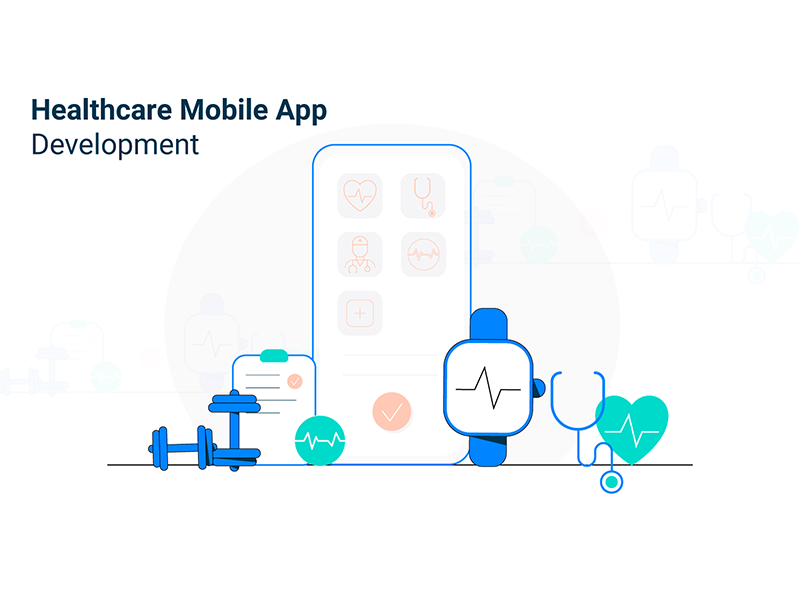
“Automation makes population health management feasible, scalable, and sustainable.” Institute of Health Technology Transformation
The current state of healthcare systems needs substantial improvement, especially in the recent outbreak of Covid-19. These days, Coronavirus has infected almost 215M people, with 4.47 M deaths worldwide. It has impacted the world and its economy drastically. New health app ideas are needed to confront the situation and come up with apps for medical services .
The sector has the potential for innovative trends, like IoT, Big Data, and AI. We will talk about the sectors of the best healthcare apps and come up with some popular applications in the market. The article may give you some good health app ideas that we can turn into a robust project.
How many health apps are there in 2023?
To understand the potential of the industry in terms of business perspectives and investment, consider statistics data. For 2021, the global mHealth market was valued at $38.2 billion . From 2021 to 2028, the market is predicted to grow at a CAGR of 34,8%, registering a value of $314.60 billion. The growing penetration of smartphones, 5G technology implementation and the users’ consciousness over health issues provide an unprecedented rise in mobile healthcare technologies.
The rise of mHealth demand increased mobile apps available in the App Store and Google Play market. Thus for Q1 2021, there were 53,979 iOS healthcare apps and 53,054 apps available at Google Play.
The Benefits of Integrating Mobile Apps in Healthcare and Patient Experience
The integration of healthcare services and innovative projects with the best healthcare apps is one of the ways to prevent epidemic situations and address other, no less important medical issues.
Healthcare automation and digitalisation across most of its sectors implies benefits , namely:
- Removal of bureaucracy
- Minimisation of human errors
- Improved medical treatments
Quicker diagnosis and pre-screening processes
- Remote patient monitoring
- Cutting the operational costs
- Improvement of global health
Speeding up the provision of healthcare service
- Access to the medical service in remote
- Unified and secure medical and patient databases.
How much does a medical app cost?
Mobile health application development is related to the most complicated development processes beyond simple programming. It requires regulations, security, and support. With a rough estimation, the average cost of a health mobile app is $425.000. It is the price of an app enhanced with the latest technologies. The price, though, does not include marketing and support services.
There is no universal pricing for app development. The price depends on many factors, and even the less significant element can change the price. The main cost drivers still remain the app complexity, the app’s features, and the dev team’s hourly rate.
There are more important elements to care about with mobile healthcare apps than, for example, interactive UI/UX. More than anything, healthcare apps should be secure, stable, and user-friendly. Here is a rough estimation of app development costs led by an average-rated dev team.
How to Create a Mobile App for Business?
App development needs to follow six-step business planning to make your idea compatible with business perspectives and market demands:
- Developing a business strategy
- Hiring development team
- Budgeting and planning
- Defining app features
- Marketing strategy
- Support and maintenance
WANT TO KNOW HOW MUCH DOES IT COST AN APP?
Find out cost drivers of app development in our blog.
Best Healthcare apps in Medical Services
Medical app development that utilizes the smartphone and functionality of other smart devices provides an advanced value. To develop the software operating on iPhone devices, applying specific tech stacks and following the platform guidelines is necessary. The same applies to the Android operating system.
To build an iOS or Android client app, it is necessary to use Swift and Kotlin programming languages. Applying technologies like Node.js, Python, Ruby, cloud-service platforms of AWS, EC2, S3, and PostgreSQL or MySQL databases is possible for the back-end developments and server setups.
Here are some of the apps popular in the market.
Doctor On Demand - Telehealth app
This app provides care on demand and by appointment. It is an iOS and Android app and is used in various physical and mental healthcare services.
Heal - Doctor house calls
HealpersonalisedWhen is an app to arrange a house call. It also applies to iOS and Android platforms.
Maven - Woman’s healthcare
Maven is designed for women and families. It is a kind of “digital clinic” where women and their families can turn for physical and mental health issues.
Fitbit - Activity tracker
This app allows us to monitor the state of health, including heartbeats, calories, fitness time, etc.
Healow - Health records management
Healow is the main communication tool between patients and their doctors. It records data and allows access to healthcare records.
MyChart - Patient portal
This app is also used for communication, allowing access to records, online scheduling, and paying the bills.
UpToDate - Educational portal
This app is designed for doctors and students—a powerful platform with vast medical information. Students and practitioners can have access to expert opinions.
Sonosupport - Ultrasound imaging support
This app is designed for ultrasound examinations. With the use of the app, it is possible to get clinical-grade ultrasound diagnostics at home.
Talkspace - Therapy
The online therapy platform gives access to psychiatrists and therapists for consulting and treatment via smartphone.
First Derm - Dermatology Services
The free app helps users connect to doctors, consult online, and get treatment and prescriptions for non-emergency skin issues.
Amwell - Insurance coverage
The application provides on-demand doctor visits and accepts health insurances, including United Healthcare, Aetna, Blue Cross Blue Shield, and more.
ZocDoc - Appointment scheduling
The application connects patients with different medical institutions to schedule appointments without calling or visiting to set an appointment.
GoodRx - Prescription discounts
It is a huge prescription database with over 75.000 medications where users can search for information and find the lowest medicine price in the area.
Medisafe - Medication reminder
With the app, the patients will never forget to take their prescriptions. Virtual pillbox sends reminders and notifications for taking medications.
Teladoc - On-demand Care
On-demand Telehealth service is an affordable way to connect to physicians and get virtual care for non-life-threatening cases.
WebMD - Medical resource
It is one of the largest medical resources and information databases that gives access to care directories, a database of medications, etc.
Generis - DNA & Nutrition
This innovative solution helps users understand their genes. The app provides DNA-based recommendations: food and nutrition, fitness advice, supplement recommendations, etc.
Better Help - Online consulting
It is a quick and cost-efficient way to access mental health professionals. The application is a convenient way to get online help from professional therapists and counselors.
MDacne - Acne treatment
The application is instant access to dermatologists and gets instant treatment based on the patient's answers, photos and videos. The app has a built-in chat to provide better communication between patients and doctors.
Leafly - One-stop-shop for cannabis information
The application’s main function is to connect doctors and patients, shed light on medical Marijuana properties, and educate users.
MySugr - Diabetes tracker
The lifesaver helps patients track blood sugar, carbs, estimated HbA1c and bolus within an app. With synchronized and updated data, it is easy to track changes and take actions if necessary.
EyeCare Live - Online consulting
The application is useful to get instant consulting on eye conditions through pictures and videos. Through visuals, the doctor can resolve the condition and advise treatment.
Heal - Physician house calls
The application is aimed at bringing back the traditional doctor’s visits. The holistic view will help doctors observe the lifestyle of a patient that may help in further treatment.
Factors to Consider When Building a Healthcare Mobile App
As one of the growing industries witnessing a boom of mobile integration, every new startup is entering a highly competitive market with global players that use the latest mobile and smart tech solutions. To be in line with global players, there are top factors to be considered when building an app.
- Integration of Medical Things
The IoT may be utilized in any health-related area by uniting medical hardware and software. The system uses different sensors and processors to collect data and share it across the network. The technology can connect not only with one device but also it is possible to create a complex ecosystem of interrelated tools and gadgets.
In the upcoming years, the implementation of IoT solutions is expected to grow, which is a subject of healthcare software development. Statista states that in 2020 almost 161 million IoT devices will be delivered and used.
When wearable devices, home medication dispensers, personalized trackers, digital cameras, and other medical equipment are interconnected, it will result in the next-level healthcare service, as stated by Forbes.
Vitals trackings, efficient operations in inventory management, treatments of chronic diseases, telehealth surgeries, built-in emergency response systems, and mood trackers are just a few directions where IoMT software can be implemented.
WANT TO KNOW HOW TO MAKE AN IOT APP?
Check out our blog.
It makes no doubt that the healthcare industry holds and processes huge masses of different information. Big Data allows for effective collecting and elaboration of internal medical documentation and patient data (EHR & EMR).
These operations surely remove bureaucracy among healthcare providers, improve patient diagnostics and care, and add value to medical research and the field of analytics.
Machine Learning and Artificial Intelligence
Advancements in language processing technology create and apply chatbots, voice recognition systems, voice assistants, etc. It is only the beginning of the story related to machine learning use cases. Automated healthcare operations with the help of ML and AI will bring user experience to the next level.
WANT TO KNOW HOW TO MAKE AN AI APP?
Blogs to get deeper knowledge about AI.
Blockchain technology is widely known due to the Bitcoin cryptocurrency. However, it is a great solution to provide top security and transparency levels within the healthcare industry. The technology removes paperwork and offers fast and secure information sharing.
HOW TO BUILD A BLOCKCHAIN APP?
Get insights into blockchain technology with our blog.
How can Addevice Help you Build a Healthcare Mobile App?
Still not sure about your health app ideas? The team of Addevice is an experienced offshore software provider that designs and develops top-notch healthcare applications based on IoT and AI. We create solutions for fitness and a healthy lifestyle, patient portals, and doctor-on-demand projects. Our team can also integrate and gain data from 100+ medical devices and 3rd party services to build a complex app functionality.
As an example, Addevice has projected and implemented Sentinel hypertension medical care application. The app aims to help patients with hypertension have safe life keeping health data under control. The application provides clinicians with real-time patient data, medication, and symptom management.
ARE YOU INTERESTED IN STARTING A BUSINESS?
Contact us for consulting.
Develop Your Mobile Health App
Transform healthcare experiences with your own mobile health app Our Expertise Covers: ✅ Telemedicine and virtual consultations ✅ Electronic health records integration ✅ Medication tracking and health monitoring features
Table of contents
Mobile health application development is related to the most complicated development processes beyond simple programming. It requires regulations, security, and support. With a rough estimation, the average cost of a health mobile app is $425.000. It is the price of an app enhanced with the latest technologies. The price, though, does not include marketing and support services.
The rise of mHealth demand increased mobile apps available in the App Store and Google Play market. Thus for Q1 2021, there were 53,979 iOS healthcare apps and 53,054 apps available at Google Play.
Rate this article
Give us your impressions about this article, relevant blogs.

Some are useful to improve and personalize your user experience with all the frills and the way our website works.

Mobile Health Clinic Business Plan Template
Written by Dave Lavinsky

Mobile Health Clinic Business Plan
Over the past 20+ years, we have helped over 1,000 entrepreneurs and business owners create business plans to start and grow their mobile health clinic companies. We have the experience, resources, and knowledge to help you create a great business plan.
In this article, you will learn some background information on why business planning is important. Then, you will learn how to write a mobile health clinic business plan step-by-step so you can create your plan today.
Download our Ultimate Business Plan Template here >
What Is a Business Plan?
A business plan provides a snapshot of your mobile health clinic business as it stands today, and lays out your growth plan for the next five years. It explains your business goals and your strategies for reaching them. It also includes market research to support your plans.
Why You Need a Business Plan
If you’re looking to start a mobile health clinic business or grow your existing mobile health clinic company, you need a business plan. A business plan will help you raise funding, if needed, and plan out the growth of your mobile health clinic business to improve your chances of success. Your mobile health clinic business plan is a living document that should be updated annually as your company grows and changes.
Sources of Funding for Mobile Health Clinic Businesses
With regards to funding, the main sources of funding for a mobile health clinic business are personal savings, credit cards, bank loans, and angel investors. When it comes to bank loans, banks will want to review your business plan (hand it to them in person or email to them as a PDF file) and gain confidence that you will be able to repay your loan and interest. To acquire this confidence, the loan officer will not only want to ensure that your financials are reasonable, but they will also want to see a professional plan. Such a plan will give them the confidence that you can successfully and professionally operate a business. Personal savings and bank loans are the most common funding paths for mobile health clinic companies.
Finish Your Business Plan Today!
How to write a business plan for a mobile health clinic business.
If you want to start a mobile health clinic business or expand your current one, you need a business plan. The guide and sample below details the necessary information for how to write each essential component of your mobile health clinic business plan.
Executive Summary
Your executive summary provides an introduction to your business plan, but it is normally the last section you write because it provides a summary of each key section of your plan.
The goal of your executive summary is to quickly engage the reader. Explain to them the kind of mobile health clinic business you are running and the status. For example, are you a startup, do you have a mobile health clinic business that you would like to grow, or are you operating a chain of mobile health clinic businesses?
Next, provide an overview of each of the subsequent sections of your plan.
- Give a brief overv iew of the mobile health clinic industry.
- Discuss the type of mobile health clinic business you are operating.
- Detail your direct competitors. Give an overview of your target customers.
- Provide a snapshot of your marketing strategy. Identify the key members of your team.
- Offer an overview of your financial plan.
Company Overview
In your company overview, you will detail the type of mobile health clinic business you are operating.
For example, you m ight specialize in one of the following types of mobile health clinic businesses:
- Neighborhood mobile health clinic : Often contracting with the city or county, mobile health clinics stop in certain neighborhoods at appointed times to offer general services to family members.
- Pregnancy and Motherhood Health Clinic: Typically provided by nonprofit corporations, these clinics assist with pregnancy testing, women’s health and early childhood care.
- Corporate Mobile Health Clinic: This service is offered to employees to provide standard tests, offer immunizations, and treat any construction on-site minor injuries.
- Blood Donation & Lab Tests Mobile Health Clinic: Provided by major donors and hospitals, mobile health clinics that solicit blood donations and provide lab tests are service-oriented and often free to the general public.
In addition to explaining the type of mobile health clinic business you will operate, the company overview needs to provide background on the business.
Include answers to questions such as:
- When and why did you start the business?
- What milestones have you achieved to date? Milestones could include the number of patients served, the number of cases with positive outcomes, reaching X number of clients served, etc.
- Your legal business structure. Are you incorporated as an S-Corp? An LLC? A sole proprietorship? Explain your legal structure here.
Industry Analysis
In your industry or market analysis, you need to provide an overview of the mobile health clinic industry.
While this may seem unnecessary, it serves multiple purposes.
First, researching the mobile health clinic industry educates you. It helps you understand the market in which you are operating.
Secondly, market research can improve your marketing strategy, particularly if your analysis identifies market trends.
The third reason is to prove to readers that you are an expert in your industry. By conducting the research and presenting it in your plan, you achieve just that.
The following questions should be answered in the industry analysis section of your mobile health clinic business plan:
- How big is the mobile health clinic industry (in dollars)?
- Is the market declining or increasing?
- Who are the key competitors in the market?
- Who are the key suppliers in the market?
- What trends are affecting the industry?
- What is the industry’s growth forecast over the next 5 – 10 years?
- What is the relevant market size? That is, how big is the potential target market for your mobile health clinic business? You can extrapolate such a figure by assessing the size of the market in the entire country and then applying that figure to your local population.
Customer Analysis
The customer analysis section of your mobile health clinic business plan must detail the customers you serve and/or expect to serve.
The following are examples of customer segments: individuals, schools, families, and corporations.
As you can imagine, the customer segment(s) you choose will have a great impact on the type of mobile health clinic business you operate. Clearly, individuals would respond to different marketing promotions than corporations, for example.
Try to break out your target customers in terms of their demographic and psychographic profiles. With regards to demographics, including a discussion of the ages, genders, locations, and income levels of the potential customers you seek to serve.
Psychographic profiles explain the wants and needs of your target customers. The more you can recognize and define these needs, the better you will do in attracting and retaining your customers. Ideally you can speak with a sample of your target customers before writing your plan to better understand their needs.
Finish Your Mobile Health Clinic Business Plan in 1 Day!
Don’t you wish there was a faster, easier way to finish your business plan?
With Growthink’s Ultimate Business Plan Template you can finish your plan in just 8 hours or less!
Competitive Analysis
Your competitive analysis should identify the indirect and direct competitors your business faces and then focus on the latter.
Direct competitors are othe r mobile health clinic businesses.
Indirect competitors are other options that customers have to purchase from that aren’t directly competing with your product or service. This includes mental health professionals, private practice providers, or private laboratories. You need to mention direct competition, as well.
For each direct competitor, provide an overview of their business and document their strengths and weaknesses. Unless you once worked at your competitors’ businesses, it will be impossible to know everything about them. But you should be able to find out key things about them such as
- What types of customers do they serve?
- What type of mobile health clinic business are they?
- What is their pricing (premium, low, etc.)?
- What are they good at?
- What are their weaknesses?
With regards to the last two questions, think about your answers from the customers’ perspective. And don’t be afraid to ask your competitors’ customers what they like most and least about them.
The final part of your competitive analysis section is to document your areas of competitive advantage. For example:
- Will you provide options for the uninsured?
- Will you offer products or services that your competition doesn’t?
- Will you provide better customer service?
- Will you offer better pricing?
Think about ways you will outperform your competition and document them in this section of your plan.
Marketing Plan
Traditionally, a marketing plan includes the four P’s: Product, Price, Place, and Promotion. For a mobile health clinic business plan, your marketing strategy should include the following:
Product : In the product section, you should reiterate the type o f mobile health clinic company that you documented in your company overview. Then, detail the specific products or services you will be offering. For example, will you provide free ultrasounds, discounted medications, x-ray services, or family counseling?
Price : Document the prices you will offer and how they compare to your competitors. Essentially in the product and price sub-sections of yo ur plan, yo u are presenting the products and/or services you offer and their prices.
Place : Place refers to the sites where your mobile health clinic is contracted to visit. Document where your company is situated and mention how the site will impact your success. For example, is your mobile health clinic business located in busy retail districts, business districts, or company-owned construction sites? Discuss how your sites might be the ideal location for your customers.
Promotions : The final part of your mobile health clinic marketing plan is where you will document how you will drive potential customers to your location(s). The following are some promotional methods you might consider:
- Advertise in local papers, radio stations and/or magazines
- Reach out to websites
- Distribute flyers to neighborhoods
- Engage in email marketing
- Advertise on social media platforms
- Improve the SEO (search engine optimization) on your website for targeted keywords
Operations Plan
While the earlier sections of your business plan explained your goals, your operations plan describes how you will meet them. Your operations plan should have two distinct sections as follows.
Everyday short-term processes include all of the tasks involved in running your mobile health clinic business, including answering calls, planning and providing mobile clinic services, billing insurance and/or corporate clients, etc.
Long-term goals are the milestones you hope to achieve. These could include the dates when you expect to book your Xth corporate client, or when you hope to reach $X in revenue. It could also be when you expect to expand your mobile health clinic business to a new city.
Management Team
To demonstrate your mobile health clinic business’ potential to succeed, a strong management team is essential. Highlight your key players’ backgrounds, emphasizing those skills and experiences that prove their ability to grow a company.
Ideally, you and/or your team members have direct experience in managing mobile health clinic businesses. If so, highlight this experience and expertise. But also highlight any experience that you think will help your business succeed.
If your team is lacking, consider assembling an advisory board. An advisory board would include 2 to 8 individuals who would act as mentors to your business. They would help answer questions and provide strategic guidance. If needed, look for advisory board members with experience in managing a mobile health clinic business or successfully running a small medical practice.
Financial Plan
Your financial plan should include your 5-year financial statement broken out both monthly or quarterly for the first year and then annually. Your financial statements include your income statement, balance s heet, and cash flow statements.
Income Statement
An income statement is more commonly called a Profit and Loss statement or P&L. It shows your revenue and then subtracts your costs to show whether you turned a profit or not.
In developing your income statement, you need to devise assumptions. For example, will you see 25 patients per day, and/or visit 10 sites per day ? And will sales grow by 2% or 10% per year? As you can imagine, your choice of assumptions will greatly impact the financial forecasts for your business. As much as possible, conduct research to try to root your assumptions in reality.
Balance Sheets
Balance sheets show your assets and liabilities. While balance sheets can include much information, try to simplify them to the key items you need to know about. For instance, if you spend $50,000 on building out your mobile health clinic business, this will not give you immediate profits. Rather it is an asset that will hopefully help you generate profits for years to come. Likewise, if a lender writes you a check for $50,000, you don’t need to pay it back immediately. Rather, that is a liability you will pay back over time.
Cash Flow Statement
Your cash flow statement will help determine how much money you need to start or grow your business, and ensure you never run out of money. What most entrepreneurs and business owners don’t realize is that you can turn a profit but run out of money and go bankrupt.
When creating your Income Statement and Balance Sheets be sure to include several of the key costs needed in starting or growing a mobile health clinic business:
- Cost of vehicles, medical and lab equipment and office supplies
- Payroll or salaries paid to staff
- Business insurance
- Other start-up expenses (if you’re a new business) like legal expenses, permits, computer software, and equipment
Attach your full financial projections in the appendix of your plan along with any supporting documents that make your plan more compelling. For example, you might include your list of contracted corporations or a list of insurance plans you accept.
Writing a business plan for your mobile health clinic business is a worthwhile endeavor. If you follow the template above, by the time you are done, you will truly be an expert. You will understand the mobile health clinic industry, your competition, and your customers. You will develop a marketing strategy and will understand what it takes to launch and grow a successful mobile health clinic business.
Mobile Health Clinic Business Plan FAQs
What is the easiest way to complete my mobile health clinic business plan.
Growthink's Ultimate Business Plan Template allows you to quickly and easily write your mobile health clinic business plan.
How Do You Start a Mobile Health Clinic Business?
Starting a mobile health clinic business is easy with these 14 steps:
- Choose the Name for Your Mobile Health Clinic Business
- Create Your Mobile Health Clinic Business Plan
- Choose the Legal Structure for Your Mobile Health Clinic Business
- Secure Startup Funding for Your Mobile Health Clinic Business (If Needed)
- Secure a Location for Your Business
- Register Your Mobile Health Clinic Business with the IRS
- Open a Business Bank Account
- Get a Business Credit Card
- Get the Required Business Licenses and Permits
- Get Business Insurance for Your Mobile Health Clinic Business
- Buy or Lease the Right Mobile Health Clinic Business Equipment
- Develop Your Mobile Health Clinic Business Marketing Materials
- Purchase and Setup the Software Needed to Run Your Mobile Health Clinic Business
- Open for Business
Where Can I Download a Free Business Plan Template PDF?
Click here to download the pdf version of our basic business plan template.
Our free business plan template pdf allows you to see the key sections to complete in your plan and the key questions that each must answer. The business plan pdf will definitely get you started in the right direction.
We do offer a premium version of our business plan template. Click here to learn more about it. The premium version includes numerous features allowing you to quickly and easily create a professional business plan. Its most touted feature is its financial projections template which allows you to simply enter your estimated sales and growth rates, and it automatically calculates your complete five-year financial projections including income statements, balance sheets, and cash flow statements. Here’s the link to our Ultimate Business Plan Template.
Don’t you wish there was a faster, easier way to finish your Mobile Health Clinic business plan?
OR, Let Us Develop Your Plan For You
Since 1999, Growthink has developed business plans for thousands of companies who have gone on to achieve tremendous success.
Click here to hire someone to write a business plan for you from Growthink’s team.
Other Helpful Business Plan Articles & Templates

- Case Studies
- Product Discovery Phase
- Product Design Phase
- Product Engineering Phase
- Web Development
- Mobile App Development
- UI/UX Design & Branding
- Cloud Engineering
- Artificial Intelligence
- FinTech Solutions
- Banking Software Development
- Renewable Energy
- Startup Library
- Whitepapers
for signing up to S-PRO blog.
Roadmap for Planning Development of Telehealth Services
Oct 22, 2021 4 min read

As the use of telemedicine continues to make major inroads into the standard practice of modern health services, many hospitals and medical providers are still playing catch-up.
A lot of them are either beginning the process of implementing a system of their own or trying to piece together fragments that already exist. This can appear to be a very daunting task.
Therefore, in order to best help them achieve their goals, we need to understand every facet of the telehealth business model. To do this, we must first develop a telehealth business plan of our own that has concrete steps and follows a clear roadmap towards success that we can share with clients.

This telehealth implementation plan must also keep in mind requirements of the state and limitations of their internal networks as well as the potential for monetization to other clients or systems. In this article, we’ll provide concrete steps as well as references for further information.
Telemedicine Strategic Plan Template
In setting up a telehealth system, it’s often hard to know where to begin.
Fortunately, there is a very good planning document that is a great starting point for developing a telehealth implementation plan.
It was created and published by the Northeast Telehealth Resource Center (NETRC) and entitled Roadmap for Planning Development of Telehealth Services .
In the document they list a series of steps in what they believe to be the best overall structure for creating any telemedicine plan, which are:
- Evaluate needs . Take a look at your hospital or organization. What are you trying to accomplish? For example, are you trying to expand your existing telemedicine program or are you starting from scratch? Educate yourself on different approaches other hospitals have taken.
- Develop care services plan . Go over the needs of your telemedicine plan. Think about how and where patients and doctors will be located and what security measures will be implemented to allow only credentialed users. Also consider things like how scheduling, documentation, and billing will be integrated within the system.
- Develop a business plan and risk analysis . This is a step that is critical to the process but often overlooked. In fact, lack of planning is one of the top 10 reasons most businesses fail. It’s important to determine the level of service volume that will be the “break even” point between expenses and income. Assess the costs of the service as well as how it will offset expenses in other ways.
- Train personnel . Now is the time to prepare staff for the upcoming changes to policies and procedures that come with the shift to telemedicine. Develop a program to teach the new software to doctors and medical personnel or find a specialist to help. This also includes training administrators and other staff to its uses and benefits.
- Pilot service. Once the build is ready, it is very important to have a limited rollout of the software to test for bugs as well as useability issues. Important questions to resolve are how long the trial will run, how many participants, and whether or not you will attempt reimbursement from the efforts.
- Evaluate outcomes. One of the most important things to consider is whether the telemedicine pilot program has met the same quality standards as face-to-face care. This can be done with a simple survey for both providers and patients at the end of the visit. A plan to measure long range outcomes of telehealth using data collected should also be created.
It is recommended to begin the telehealth upgrade process slowly by creating a planning group that can assess each of these steps in an abbreviated form before diving into all the details; they can then present their findings to the board.
This will give all the stakeholders a general idea of the feasibility of the implementation project as well as a general estimate of the costs. If necessary, adjustments to the scope and direction can be made at this time.
The complete NETRC Roadmap has 6 pages of steps and 24 pages of resources that include links to pdfs, web pages, and videos that go into much greater detail in every area. They include sections on planning guides, room design, program evaluation, and more.
Additional information can be found from:
Office for the Advancement of Telehealth
Telehealth.HHS.gov
List of telehealth services payable under the Medicare Physician Fee
Other Telemedicine Business Plan Considerations
Another excellent overview is The Business Aspects of Telemedicine created by the Arizona Telemedicine Program. It has some Arizona-specific related content along with general ideas about revenue streams, expense considerations, and billing & reimbursement.
Other things that should be considered and included in your telehealth development plan are:
- Regional requirements
- Computer and network systems
- Monetization of software products.
Regional requirements
This is very important information to know about as each state has different demands regarding the management of private patient information as well as the creation of these types of software products.
Therefore, the first thing the developer should ask is “where are you located?” and make the necessary preparations from there. An excellent resource is the Center for Connected Health Policy’s State Telehealth Laws & Reimbursement Policies which has information for all 50 states as well as the District of Columbia.
Computer systems and networks
Another critical factor in the creation of a telehealth platform is the computer systems and networks it will be used on. The reality is many hospitals rely on very old computers that have slow processing speeds and very little memory.
Therefore, when creating this software, we need to make sure that graphics-heavy pages are rendered and assembled on the server; this will put less strain on older machines and allow them to access similar information as newer ones.
Monetization
Finally, let’s talk about making money from our hard work. We need to develop products for specific niches within the telemedicine system that are clearly defined as to who the end-user will be.
For example, if we are developing an entire MIS (medical information system), this reaches a more general audience, like a network of hospitals or an insurance agency.
However, if we are just developing a third-party add-on to an MIS such as video, then there is no need to spend time and money duplicating functions that already exist; the target market may also be smaller.
This must be taken into consideration and communicated to the marketing department, so they can help us reach out to the hospitals, doctors, and systems that will be receptive to and benefit most from our services.
If you are interested in learning more about telemedicine and how S-PRO can help you develop a system for your practice or hospital, please contact us.
Igor Izraylevych
- # healthcare
- # telemedicine
Latest in Healthcare
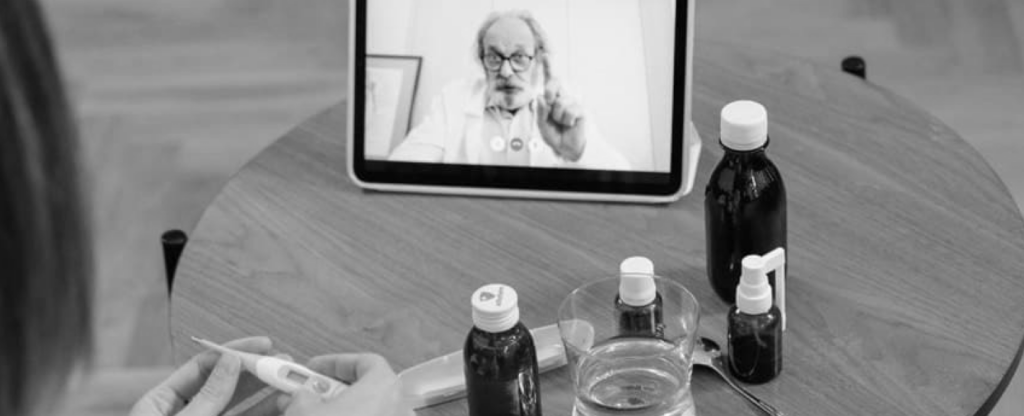
Join to Get Tech and Business Insights
Once a month we will share fresh and thematic insights, how-to articles, case studies, s-pro news, and other industry updates, for subscription.
- Skip to primary navigation
- Skip to main content

The 2024 Ultimate Guide to App Development for Healthcare
Get in touch with Pranjal
Subscribe to our weekly newsletter
Stay up to date with the latest healthcare trends.
Healthcare app development is the process by which an app is built for mobile devices with the intent of helping users effectively manage their medical conditions, fitness goals, hospital visits or insurance claims. This includes telemedicine, lab results reviews, prescription & appointment management and more.
As technology advances, the need for mHealth apps is only going to increase .
mHealth (mobile health) refers to the use of mobile phones and other technology in the medical industry. The primary uses of mobile applications are to inform patients and healthcare professionals about preventive healthcare measures, treatment support, tracking the progress being made and assisting in clinical trials.
It’s estimated that the global healthcare mobile app development market will grow and be valued at over $59 billion by 2024 .
On the consumer side, patients LOVE health care apps. In fact, 71% of patients said they would prefer if their doctors used a healthcare mobile app.
On the provider side, the same applies. The use of medical apps has become frequent and widespread; 70% of medical school students reported using at least one medical app regularly, with 50% using their favorite app daily.
The value is there, but are healthcare organizations ready to adopt mobile technologies in their digital transformation initiatives ? The answer isn’t cut and dried. The reality is that building the first healthcare mobile app doesn’t always work out as planned.
Digital Authority Partners works with some of the greatest companies in the healthcare space (Epocrates, Athenahealth, Omron, and Blue Cross Blue Shield, to name just a few).
For every healthcare executive out there interested in developing their first mobile app , we put together this guide covering the top 9 considerations you should be aware of BEFORE you sign the dotted line to build your first app.
100+ companies trust us with their mobile app development needs. Watch the video below to learn why.
1. Define a robust digital strategy

Clarify the type of healthcare mobile app you are building. And why!
Before anything else, you need to define the specific goal for your first health app. Don’t try to do it all. Also, think about who the app is intended for.
Here’s what makes all successful mobile apps out there great. In the user’s mind, a connection is made between a mobile app and a specific use case. Like - I go to Facebook to decompress and see what my friends are up to, Linkedin to read professional news and network updates, Epocrates to get drug information etc.
Bottomline: whatever app you build, make sure you answer this question first. My ideal customer will regularly use this app to do thing one thing.
Product development
Build an exceptional digital experience.
Now, we learn by example. So here’s a few great healthcare mobile apps that perform one function and they do it well.
Examples of health information management apps
These apps are designed to provide & exchange medical information between doctors and patients. They can also be used to set up & manage appointments with your physician.
Medibabble is designed to help doctors and administration staff communicate with patients who do not speak English. It is pre-loaded with the patient’s medical history and contains simple, clear examination questions in common languages including French, Spanish, Russian and German.
To ensure the information is accurate, each phrase is checked by fluent physicians so non-native patients can receive the correct care.
Lybrate is another information management app that enables doctors and staff to add patients to an appointment list, track payments and record treatments provided. The dashboard also lets physicians to track their team’s efficiency with up-to-date stats on tasks completed by supporting personnel.
Patient monitoring mobile apps built the right way
Patient monitoring & overall telemedicine services have really picked up in the last five years. A wide variety of healthcare manufacturers & software providers have rushed to enter this increasingly crowded space and create value more hundreds of millions of patients all over the world.
For example, HeartGuide is a wearable blood pressure monitor (full disclosure, Digital Authority Partners worked on this project). The device can track heart data and inform a patient’s of how their behavior impacts the health of their heart. It then syncs to the HeartAdvisor mobile app & Alexa skill to provide real-time health insights to the user.
Common patient monitoring apps also track the user’s location so as soon as they need help, they can receive help as soon as possible.
Medical resource information apps created with the users’ needs in mind
In a survey of medical school faculty, residents, and students, 75%, 95%, and 55%, respectively, agreed that using a mobile device to quickly access educational resources while on the go had a positive effect on their individual performance.
Examples include drug referencing apps that can inform a patient about the effects and benefits of a particular treatment and medical calculators that can calculate how often a drug needs to be taken.
Epocrates is a mobile healthcare app that delivers current and safe treatment information when patients need it (full disclosure, Digital Authority Partners worked on Epocrates). It can also help check for harmful interactions with up to 30 drugs at a time and provide a communication platform between care teams.
Pepid is another great example of an amazing medical app which works as a clinical decision support app targeted to ER physicians. One of its best features is the ‘Symptom Checker’ which can help diagnose patients quicker by suggesting possible ailments based on a patient’s symptoms, physical examinations and lab results.
Make sure you’re super clear on what problem your new healthcare app is solving

If you build a new healthcare app for your business, you need to make sure it’s a problem that people actually want or need to be solved.
For example, only 11% of health systems offer patients proprietary apps that operate with at least one of the three functions that consumers demand most: access to medical records; the ability to book, change and cancel appointments; and the ability to request prescription refills electronically.
So if you work at a hospital and want to build an app - make sure that app solves at least one of the problems highlighted above.
Your app may also want to tackle the problem of getting healthcare to people in remote areas. Rural Health Information Hub shows that long distances can be a large problem in terms of time and cost to access healthcare. With a mobile app, they will be able to get a lot of the information they need through their phones.
Bottomline: don’t build an app for the sake of building an app. Make sure whatever you do has real life applications and that your ideal target users can benefit from it and leverage it as soon as it’s live.
Make sure you study your competitors - and outperform them

Once you know about the problem your new healthcare app will solve, think about the other players on the market who have comparable or complimentary solutions. Competition can work both for and against your app.
If there is competition, that means that there is demand for the product. On the other hand, the more businesses that compete in the same space, the harder it will be to get your brand noticed.
Nevertheless, you cannot build a great healthcare mobile app unless you closely analyze what your competitors are doing. Use Google to search for keywords that are related to your app idea. Think of what your target audience would search for.
Every business has a unique selling point (USP) that separates it from the rest. For example, your competitors may be the fastest to respond to patient queries or have a larger database of drug information.
Knowing what competitors are using as their USP can help you find out your common target audience is looking for and determine your own.
For example, the Digital Authority Partners’ philosophy towards helping our clients build a new health app is simple. We do our thorough analysis of the market, create a detailed matrix of all competitors’ main features, then determine the list of functionalities a new app should have that will make our clients’ app than any other app in the market . That should be the output of any mobile app competitor analysis you work on.
Define upfront how you plan to monetize the app

If you look at the highest-grossing games in the App or Play store, they’ll have one thing in common: they’re free to download. Instead, they make their money by advertising and in-app purchases.
You need to take the same approach and avoid the pitfall of charging to download the app. In fact, only 5.76% of apps are paid and that number is falling every quarter.
In the healthcare space, in particular, the most common monetization method is actually subscriptions. If you have built a solid health app which collects data and provides health assistance, tips and tricks, this is the route to go.
But overall, the only one thing we suggest you stay away from is paid apps. Those perform the worst. Most people want to “try out” a new app before buying it, so, even if you want to force all users to pay for your app, offer a free trial. Allow people to download and use your healthcare app for free for one month, then start charging a fee.
Determine the omni-channel strategy for your app

Will your healthcare app work best on a mobile phone or on a tablet? Will it be built for Android or iOS or both?
Think about what you are building as an ecosystem. Will you have an app AND a website? Can it be voice activated by Siri or the Google Assistant? Would it benefit from in-person interactions by making use of a camera?
We live in an omni-channel world and in simple terms, digital users don’t interact with a company via only one channel. So you need to think upfront what is the perfect blend of touch-points for your app.
This of course depends on a variety of factors.
For example, elderly patients typically prefer websites & tablets while younger users may be more inclined to interact with your product via a mobile app and an Alexa/ Google Home skill. Therefore your ideal target audience should drive your multi touch-point strategy.
Either way - one thing is certain: if you’re going to support multiple touch-points, at least think through this before you build and launch a product. You don’t have to build all these touchpoints at launch (see our next tip below for more details), but you need to make a conscious decision on what path you want to take from the get-go.
Build an MVP healthcare mobile app and test it

When you start building a mobile app, the first instinct would be to build the best possible app out there. But that shouldn’t be the case. The optimal healthcare mobile app could take years to flesh out.
Do not try and build the entire app in one day. Instead, build a Minimum Viable Product (MVP) and iterate it. There are multiple reasons for this.
First - there is time. A simple app (aka doesn’t have a ton of functionalities) is faster to build, therefore it is easier to get it done and in the hands of your ideal customers. When you build a mobile product, time is of the essence. You should do your very best to narrow down the core functionality of an app, then make a list of additional features you will schedule, build and launch after the first version of the app goes live.
Second, when you ship a healthcare mobile app quickly, you have the chance to build relationships with customers sooner. Early users are more likely to provide positive and negative feedback on your app and suggest changes or additions to it. So whatever health mobile app you’re building - you want to get user feedback ASAP - and then iterate on it.
Third, when you define a mangable MVP, you can get your product to market quicker which will also help you test your marketing message quicker. Even if your app is brilliant, you may not get traction if your marketing and sales are poor. And even if the app is great, you may need to adjust your branding, positioning and even your core target audience - all of which is a lot easier to do if you go to market fast.
2. Build an app that is outcome-focused

Here is an example of an app that failed .
A company created an app that was meant to cure acne by emitting blue light from the screen of a smartphone. It got more than 10,000 downloads at a nominal fee of $1.99 on the iTunes and Google Play stores. However, the Federal Trade Commission (FTC) took control and the app was swiftly removed from app stores.
Why? Because there was no proof that the blue light actually cured acne. When you build your app, the outcome from it must be realistic and plausible.
Mobile healthcare applications designed for doctors and other professionals should aim to save them time and money while increasing accuracy of diagnoses or treatment advice.
Most importantly, patient apps must provide correct and relevant information.
At the end of the day, you need to build products which lives up to the expectation you set forth for your product. And the better you get at clearly highlighting the outcome you want to impact, the better it is for your company - and your customers.
3. Ensure you understand and abide by healthcare regulations

Healthcare is one of the most regulated industries in the US. If your app runs afoul of any regulations, it risks being removed from the marketplace, being shut down permanently, fined by the FDA or you could even be sued by consumers.
Here is an example of a company that failed to comply with regulations.
Theranos
Theranos was founded in 2004 with the ambitious goal of revolutionizing blood testing machines. They claimed it would spare patients the pain of traditional blood drawing methods and would test for a variety of potential ailments using just a few drops of blood.
The company quickly found success, raising funds and growing its staff at a remarkable rate. Founder Elizabeth Holmes managed to attract $700 million of investment from savvy international investors, with the promise of changing the world.

However, this success was short-lived and crumbled as quickly as it was formed. In October 2015, the Wall Street Journal published an article that the Theranos’ blood-testing machines didn’t actually work. The article said the company was both faking proficiency testing and using other commercial machines to complete the tests.
Contracts were quickly terminated and lawsuits were filed by the investors. Holmes and former Theranos president and CEO Sunny Balwani were later indicted on charges of criminal fraud.
How to comply with HIPAA regulations
To be compliant with HIPAA, healthcare mobile app development must follow the HIPAA Privacy Rule and HIPAA Security Rule . Here are extracts from the HHS on both:
HIPAA privacy rule
The HIPAA Privacy Rule establishes national standards to protect individuals’ medical records and other personal health information and applies to health plans, health care clearinghouses, and those health care providers that conduct certain health-related transactions electronically.
The law requires appropriate safeguards to protect the privacy of personal health information and sets limits and conditions on the uses and disclosures that may be made of such information without patient authorization.
The Rule also gives patients rights over their health information, including rights to examine and obtain a copy of their health records and to request corrections.
HIPAA security rule
The HIPAA Security Rule establishes national standards to protect individuals’ electronic personal health information records that are created, received, used, or maintained by a covered entity.
The Security Rule requires appropriate administrative, physical and technical safeguards to ensure the confidentiality, integrity, and security of electronic protected health information.
How to comply with HITECH regulations
All mobile health apps must abide by the Health Information Technology for Economic and Clinical Health (HITECH) Act, which promotes the adoption and meaningful use of health information technology.
The goal is to strengthen the civil and criminal enforcement of HIPAA rules. It addresses the privacy and security concerns associated with the electronic submission of health information.
You can find more about HITECH here .
Other regulations
Although there is a review process for new apps for technical reasons by Apple or Android, there isn’t a review of the medical value of the app itself. So healthtech companies must undergo their own due diligence and ensure their app complies with all existing regulations.
4. Validate the idea with both healthcare professionals & patients

Once your app meets target market specifications, regulations and best practices, you should run it past the people that will actually use it through focus groups and surveys.
Think about how your app answers the questions from step 1:
- Does the app solve a specific real problem?
- How big a problem is it?
- Would users be willing to pay while using your app?
It’s not important that professionals or patients like your app at this stage. Instead, you must find out whether or not they will use it.
App founders, including but not limited to the health industry, are concerned that spending time doing market research slows down the business. It’s actually the opposite.
The more market research you conduct, the faster your app will move to launch. Businesses that fail to do enough market research spend too much time and money trying to make their product fit the market.
For example, you won’t have to spend time adding a new feature that your customers are asking for or removing any older features that nobody wants. You’ll be ahead of the game. Save money. And make a better healthcare mobile product.
5. Build an amazing digital experience

Modern customers expect a great user experience but the healthcare industry is traditionally ill-equipped to deliver a flawless digital strategy.
In fact, while 66 of the 100 largest hospitals in the United States offer consumers mobile health apps, only 2% of patients are using them, according to a new report published by Accenture .
Building a great health app is done by hiring a great digital strategy and mobile app development agency. Don’t try to create it in house.
The following tips are key to finding the perfect healthcare mobile app development solution.
Find an agency that has worked in healthcare
The best development agencies should be able to guide you from the inception of your app to launch and beyond while giving you input based on their experience with previous applications. The best businesses already know what works well because of their collective knowledge which goes well beyond a specific product.
Whereas some healthcare companies are often hesitant about working with healthcare app development partners because they fear these agencies don’t know a specific product well enough, it's more likely the opposite. You know only the app you’re trying to build, but an agency working in the healthcare space has witnessed the birth of hundreds of similar apps. You want to tap into that knowledge versus narrowing it down to just the people you’re working with day in and day out.
Make great mobile app design a priority
Great developers care about the user experience more than about anything else. Because great agencies look at every new healthcare development project as yet another resume maker –– and the design of an app impacts its overall usability –– a digital partner is only as successful as the product they are building. So as you search for a partner, look at their portfolio for apps that look just as good as they function. 21% of millennials will delete an app from their home screen if it doesn’t look good.
The app store is full of healthcare apps and yours needs to stand out. The mobile app design must be a top priority and it will define how patients or health professionals interact with it.
Often standalone developers will just focus on creating the app completely disregarding the user experience. Find a team that will carry out all the necessary tasks to ensure your app becomes a success.
Consider if you can work with the agency long-term
App development is not a one-time thing.
It will need to be changed and updated every so often from adding new functionalities to addressing customer feedback. You need to find a partner that you can build a relationship with. Once the app is live and hosted, you need them to stick around.
Don’t be driven by prices
Finally, don’t just choose a developer because they are quoting you lower than your competitors. You want to build the best product, not the cheapest. You don’t want to end up paying someone to fix another developer’s mistake.
We mean it. If we had a nickel for every mobile app we have to fix because another development team created a sub-par product either on the UX side or the development side...
And that’s not a good thing. It means many of our clients have wasted hundreds of thousands, sometimes millions, and built the wrong product. Always choose the best team you can afford. That will pay off dividends in the long term. Every. Single. Time.
6. Build apps that can be integrated within the healthcare ecosystem

Connections With EMRs And EHRs
All mHealth apps must connect with EMRs and EHRs.
For reference, the following definitions have been taken from The Office of the National Coordinator for Health Information Technology .
“Electronic medical records (EMRs) are a digital version of the paper charts in the clinician’s office. An EMR contains the medical and treatment history of the patients in one practice. EMRs have advantages over paper records. For example, EMRs allow clinicians to:
- Track data over time
- Easily identify which patients are due for preventive screenings or checkups
- Check how their patients are doing on certain parameters—such as blood pressure readings or vaccinations
- Monitor and improve the overall quality of care within the practice
“Electronic health records (EHRs) focus on the total health of the patient, going beyond standard clinical data collected in the provider’s office and inclusive of a broader view on a patient’s care.
“EHRs are designed to reach out beyond the health organization that originally collects and compiles the information. They are built to share information with other health care providers, such as laboratories and specialists, so they contain information from all the clinicians involved in the patient’s care.”
How can you integrate health apps and EHRs?
WellDoc conducted a study where they interviewed healthcare mobile app development and testing teams, EHR software consultants, hospital IT teams, patients, project managers, and business analysts. These were the results:
- Integration must take into account the professional’s or patient’s day-to-day life and workflow.
- Design should support mobile-integrated therapies (MITs) into a single EHR. Developers must eliminate redundancies between the systems, where app users and EHR users might enter the same data into different fields.
- Multiple environments must be secure, but security must not keep them from interacting with each other.
- Both halves of the integration, especially patient-facing apps, must work natively on as many mobile devices as possible.
- Apps must be able to run even when network connectivity is sparse or intermittent.
- Support teams familiar with the technology must be available to help.
- The two systems must adhere to common standards; for example, the same measuring units.
- The team working on integration must be ready for a more complex process than anticipated.
Connect with other sources
There are over 700 million iPhone users worldwide . There are also over 25 million Fitbit users worldwide . This presents an opportunity for healthcare mobile app development companies to tap into the data these apps collect.
For example, the Apple Health app records data like the number of steps taken every day and organizes it based on where it comes from:
- Manually entered Health data
- Automatically recorded Health data from an iPhone and Apple Watch
- Health data from Bluetooth devices
Communicating with the Health app provides doctors with an accurate reflection of how active a patient is every day.
But the bottomline is simple: you can build a good product on your own, but what makes a product amazing, is whether that product integrates with other apps and wearables a user may use. For example, I love how my Strava tracking app integrates with MyFitnessPal and my Apple 4 watch. That way, I get to see how my physical activity and calorie intake impact my overall health stats on any given day.
App integrations are typically a phase 2 deliverable for most apps. But the lesson here is to make sure you build a long term app for your healthcare app development cycle which accounts for relevant and useful integrations over time.
7. Stay ahead of the curve with next-gen technologies in healthcare

One of the biggest issues facing the healthcare industry in the US is that current legacy systems are not able to handle the rapid technology advancements being made every year.
As part of your healthcare mobile app development, you need to ensure that your product can adopt new tech stocks over time.
Here are some examples.
Artificial intelligence in healthcare
AI in healthcare is huge. And we’ve covered the topic at length in other articles ( here , here and here ). And this article will give you a great summary of the coolest companies leveraging Artificial Intelligence in a way that is revolutionizing the healthcare industry.
As Toby Nwazor expertly points out in a recent Entrepreneur article , Artificial Intelligence is becoming a commonplace technology in the healthcare field. From digital consultations to personalized medicine, to robot surgeons, we’re no longer talking about if AI is coming to healthcare, but how quickly companies in the health space are catching up with the times, and same with AI in pharma .
One particular field of AI that is useful for the healthcare industry is neural networks. Neural networks are self-learning and trained rather than explicitly programmed. They are already being used as part of drug discovery processes and detecting cancer cells in the body.
So, in the future, healthcare apps may use neural networks to enable patients to self diagnose and recommend treatments, without the need for a doctor.
Blockchain technology in healthcare
Blockchain technology is most commonly known for its use in cryptocurrency. As defined by Don & Alex Tapscott , the blockchain is an incorruptible digital ledger of economic transactions that can be programmed to record not just financial transactions but virtually everything of value.
The blockchain is very secure and immutable i.e. tamperproof. These qualities make it potentially useful for improving the security of patient data on healthcare apps.
But blockchain is also revolutionizing the healthcare space. Take this article from HealthcareWeekly , for example which highlights seven different scenarios in the healthcare space already positively impacted by Blockchain:
- Owning and sharing medical data
- Clinical trials and consent management
- Micropayments & small awards given to patients for adhering to medical treatment plans
- Blockchain solutions that record health products information in the supply chain
- Data security
- Fraud prevention
- Customer payments
Blockchain is an incredible technology and we’ve only scratched the surface of what it can do for healthcare. If you’re curious to learn more, read about the following companies who’ve released healthcare products using blockchain technologies: PatientSphere , Hu-manity and Blackberry .
For a more in-depth discussion about blockchain in healthcare, check out our ' Blockchain in Healthcare: An Executive's Guide for 2019 ' report.
Virtual reality comes to healthcare
Virtual reality (VR) uses computer technology to create a simulated environment and places the user inside the experience. 55% of physicians want to use VR to learn about new treatments. VR could be used as part of an app to take a patient to a place of comfort as a way to reduce stress and treat mental illnesses like anxiety and depression.
Also check this awesome interview I did with David Badri which shows how Johnson and Johnson is leveraging VR to help doctors get better at their job.
Internet of Things & healthcare
The Internet of Things (IoT) can be used to provide continuous data about patients that can be analyzed to improve the quality of care. The Apple Watch and the aforementioned HeartGuide are products that sync this data to health apps.
Compatibility with voice communication products like Amazon’s Alexa or Google Home could also become part of healthcare mobile app development. They may be able to help patients decide when to take their medication or assisting with compliance for medical studies.
Immersive 3D video
70% of physicians are interested in watching medical training videos. Furthermore, 46% of patients diagnosed with a chronic condition want to see videos to learn more about their condition and its treatment.
8. Leverage mobile app analytics to measure and improve the overall UX of your healthcare mobile app

Businesses concerned with healthcare mobile app development must continually improve their digital products through mobile app analytics .
59% of US consumers say they expect the healthcare system to offer the same level of service and user experience as companies like Amazon. P eople cannot stand bad user experiences as 71% of all app users churn within 90 days. This is across all industries.
Here are two ways you can increase customer retention and improve the user experience.
A/B testing
A/B testing allows healthcare product teams to test out multiple user experiences to determine which is the most effective at achieving a specific business goal. Continual A/B testing leads to vastly improved user experiences and better key performance indicators.
For more about A/B testing and its benefits, read this article.
Mobile app analytics
Mobile app analytics are used to measure a user’s behavior, find where they trip up and attract new customers. Invest in a tool that will help you better understand how customers respond to the experience.
For example, Mixpanel ’s platform can tell if users are coming back after adding or improving the app’s features. Retention then provides insight that helps make a product stickier over time.
Alternatively, Amplitude identifies critical drop-off points in product paths and optimizes marketing and sales funnels.
9. Define how you will market and gain adoption of your app
You’ve had the vision and finished the healthcare mobile app development process. Now you need to get actual user adoption. Remember, at least 30-35% of your total budget should be reserved for marketing.
Think of the old adage… if a tree falls in the woods and no one hears it, did it make a noise? Ultimately, your app needs to “make a noise” by getting people talking and using your app.
Define a marketing strategy to get adoption depending on who you are trying to sell to. B2B businesses selling to hospitals and medical device manufacturers will require different techniques compared to B2C businesses.
However, they will both have the same goals:
- Increase brand awareness
- Attract people to your app
Blog posts, infographics, testimonials and short videos are the best ways to grow your online presence and get a product noticed. Once people start downloading and using the app, your goals can then shift to keeping them engaged.
Here are some tips to successfully market your healthcare app.
Use social media
Social media is essential to building an audience and can increase the number of downloads while being cost-effective.
Your app requires a social media profile across all major channels like Facebook, Instagram and Twitter. Ensure that there is a link to your website and app store download page. Add an interesting app description and screenshots to complete the setup.
Now for the marketing. Facebook and Instagram ads are very powerful in attracting new customers to your new healthcare app. Check out their App Install Ads that will promote your app across multiple channels simultaneously.
If you don’t have a budget for ads, you can use your social media pages to share blog posts and infographic content with followers.
Create an attractive landing page
A clean and professional landing page builds trust and confidence in the app, especially when it’s optimized for mobiles. Don’t be one of the 50% of businesses that don’t adapt their sites for mobile usage.
In addition, remember that the most important thing about a landing page is the ability of that page to track conversions (via analytics). This is a crucial metric for marketing campaigns.
Ensure the headline grabs the user’s attention along with clear call-to-actions (CTAs). Again, like on the social media pages, add links to your app in the App and Play stores. The website’s content must also include your app’s keywords. Search Google to find similar keywords an increase your brand’s visibility in search results.
Finally, it may be worth having a video on the landing page that explains what app does and how a user would benefit having it. This can improve by 86% if implemented correctly.
Traditional marketing
Why do people still knock on doors trying to sell things? Because it works. Visit a medical practice and hand out fliers, postcards or QR codes to patients, doctors and other professional staff to promote your app.
Of course, this is a lot harder to track than the above methods but word of mouth and referral marketing is own of the most powerful marketing tools in your arsenal; word of mouth is the primary factor behind 20% to 50% of all purchasing decisions.
Want To Meet Our Expert Team?
Book a meeting directly here

Related Articles

Search engine optimization (SEO) helps chiropractors reach their target market and direct patients to their clinics. ...
Search engine rankings help chiropractors build an online presence and attract patients. Higher rankings increase a c...

Modern digital marketing strategies such as artificial intelligence (AI) and pay-per-click (PPC) help hospitals reach...
Contact our team
One of our consultants will get back to you within 24 hours..
- Business Plan for Investors
- Bank/SBA Business Plan
- Operational/Strategic Planning Services
- L1 Visa Business Plan
- E1 Treaty Trader Visa Business Plan
- E2 Treaty Investor Visa Business Plan
- EB-1 Business Plan
- EB-2 NIW Business Plan
- EB-5 Business Plan
- Innovator Founder Visa Business Plan
- Start-Up Visa Business Plan
- Expansion Worker Visa Business Plan
- Manitoba MPNP Visa Business Plan
- Nova Scotia NSNP Visa Business Plan
- British Columbia BC PNP Visa Business Plan
- Self-Employed Visa Business Plan
- OINP Entrepreneur Stream Business Plan
- LMIA Owner Operator Business Plan
- ICT Work Permit Business Plan
- LMIA Mobility Program – C11 Entrepreneur Business Plan
- USMCA (ex-NAFTA) Business Plan
- Franchise Business Plan
- Landlord business plan
- Nonprofit Start-Up Business Plan
- USDA Business Plan
- Cannabis business plan
- Ecommerce business plan
- Online boutique business plan
- Mobile application business plan
- Daycare business plan
- Restaurant business plan
- Food delivery business plan
- Real estate business plan
- Business Continuity Plan
- Pitch Deck Consulting Services
- Financial Due Diligence Services
- ICO whitepaper
- ICO consulting services
- Confidential Information Memorandum
- Private Placement Memorandum
- Feasibility study
- Fractional CFO
- How it works
- Business Plan Examples
Medical Device Business Plan
NOV.06, 2023
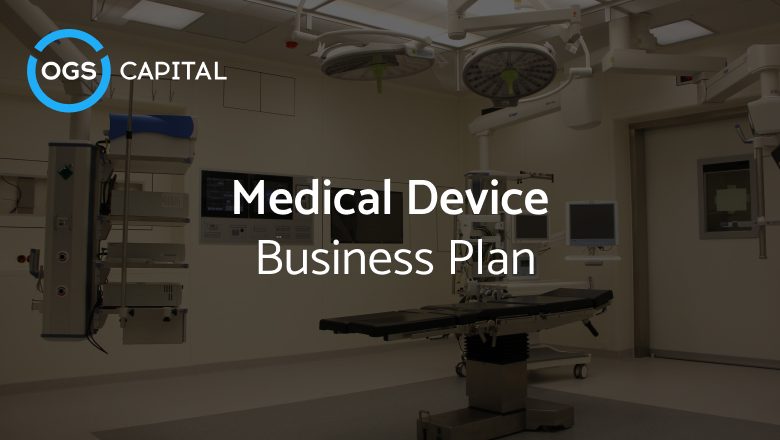
Medical Device Business Plan Sample
A medical device business plan is a document that outlines how to start and run a successful company that produces and sells products that diagnose, treat, or prevent diseases or injuries. Navigating the vast and expanding medical device sector presents thrilling opportunities alongside complex hurdles. A well-crafted business plan illuminates the route to success. Articulate your vision, milestones, tactics, and budgetary forecasts.
A business plan should also demonstrate how you will stand out from the crowd, satisfy users, adhere to regulations, and uphold ethical standards. A medical billing business plan is a specific type of medical device business plan that focuses on how to provide billing and coding services for healthcare providers.
In this article, we will provide you with a medical device business plan sample that you can use as a template or a reference for your business plan. We will cover the following sections:
- Executive Summary
- Company Overview
- Industry Analysis
- Customer Analysis
- Competitive Analysis
- Marketing Plan
- Operations Plan
Management Team
- Financial Plan
Executive Summary Section of Our Medical Device Business Plan
Business overview.
Medix is a medical device company that develops and sells innovative and affordable devices for diabetes management. We aim to enhance the well-being and health results of those managing diabetes. We aim to offer user-friendly and dependable products that assist in tracking and regulating blood sugar levels.
Products and Services
Medix offers two main products:
- Medix Glucometer – A smart glucose meter that connects to a mobile app via Bluetooth and provides accurate and instant readings of blood glucose levels.
- Medix Patch – A wearable patch that continuously measures blood glucose levels through the skin without needing finger pricks or test strips.
Customer Focus
Medix focuses on serving people with diabetes, seeking convenient and affordable solutions to manage their condition. According to the IDF Diabetes Atlas 10th edition report , 537 million adults (20-79 years) live with diabetes – 1 in 10. Experts predict that this number will rise to 643 million by 2030 and 783 million by 2045. Therefore, there is a huge demand for effective and accessible diabetes care products.
Leo Clark and Aria Bennett, two experienced entrepreneurs with biomedical engineering and business administration backgrounds, founded Medix. Leo is the CEO and head of product development, while Aria is the COO and head of marketing and sales. A team of qualified engineers, designers, developers, marketers, salespeople, and advisors supports them.
Success Factors
Medix has several competitive advantages that will enable it to succeed in the medical device industry:
- Innovation with cutting-edge technology to create novel devices
- High standards of quality and safety in every aspect of devices
- Customer satisfaction by providing user-friendly devices
- Social impact by addressing a major health problem globally
Financial Highlights
Medix seeks $5 million in seed funding to launch its products and scale its operations. The company projects to generate $1.2 million in revenue in the first year, $3.6 million in the second year, and $10.8 million in the third year, with a gross margin of 60% and a net profit margin of 20%. The company expects to break even in the second year and reach a valuation of $50 million by the end of the third year.
Company Overview Section of Our Medical Device Sales Business Plan

Who is Medix Medical Supply?
Medix dedicates itself to developing and selling innovative, affordable, and reliable devices for diabetes management. Our products help people with diabetes to monitor and control their blood glucose levels with ease and effectiveness, leading to better health outcomes and an improved quality of life.
Medix Medical Supply History
Medix is a company that provides innovative solutions for diabetes care. It was founded by Leo Clark and Aria Bennett in 2023, who both personally experienced the challenges and frustrations of living with diabetes. These challenges included frequent finger pricks, expensive test strips, inaccurate readings, and complicated insulin injections.
They started Medix with their personal funds and an incubator grant to address these issues. Medix developed two products – the Medix Glucometer and the Medix Patch – to make diabetes monitoring and treatment easier, more accurate, and more affordable.
The Medix products have received regulatory approvals from the Food and Drug Administration (FDA) and the European Medicines Agency (EMA). They are now ready for launch in the US and European markets. For more information, please refer to our dentistry business plan .
Legal Structure
Medix, an LLC registered in Delaware, USA, has obtained ownership by Leo Clark (60%) and Aria Bennett (40%). Additionally, the company has applied for a patent for its products in the US Patent and Trademark Office (USPTO).
Industry Analysis Section of Our Medical Device Business Plan
The medical device industry is one of the world’s most innovative and dynamic sectors. Fortune Business Insights reported that the global medical device market was valued at $512.29 billion in 2022 and can grow from $536.12 billion in 2023 to $799.67 billion by 2030, at a CAGR of 5.9%.
The medical device industry is driven by several factors, such as:
- The increasing prevalence of diseases and the aging population
- The rising demand for minimally invasive and personalized treatments
- The advancement of technology and digitalization
- The emergence of new markets and segments
Customer Analysis Section of Our Medical Supply Business Plan
Demographic profile of target market.
Medix’s target market is the US market, which ranks third for the highest number of people with diabetes. We target diabetic people looking for convenient, affordable solutions to manage their condition.
According to the National Diabetes Statistics Report by CDC, here are some interesting stats about why the US market is best for Medix:
- 37.3 million people have diabetes (11.3% of the US population)
- 28.7 million people are diagnosed, including 28.5 million adults
- 8.5 million people are undiagnosed (23.0% of adults)
- 96 million people aged 18 years or older have prediabetes (38.0% of the adult US population)
- 26.4 million people aged 65 years or older (48.8%) have prediabetes
The demographic profile of our target market is as follows:
- Age – We target all ages, mainly the young and middle-aged, who are tech-savvy and have more money to spend. A CDC report says 34.1 million adults aged 18 years or older—or 13.0% of all US adults—have diabetes.
- Gender – We target both males and females, as diabetes does not discriminate by gender. A NIDDK (NIH) report says a higher percentage of men (41%) than women (32%) have prediabetes.
- Income – We target all income levels, mainly the low and middle-income who need better healthcare solutions. An NCBI (NIH) report says 80% of the adults worldwide with diabetes live in low- and middle-income countries (LMICs).
Customer Segmentation
Based on our market research and customer feedback, we have identified four main customer segments for our products:
- Segment A – Tech-savvy innovators who value quality, performance, and convenience. They share their views online.
- Segment B – Cost-conscious buyers who seek affordable and effective products. They trust their peers’ recommendations.
- Segment C – Health-conscious improvers who want products that motivate and support them. They join online health communities.
- Segment D – Compliance-driven users need products that ensure safety, security, and simplicity. They depend on their health providers and caregivers.
The table below summarizes our findings:
Based on the table, we have decided to target segments A and B as our primary segments, and segments C and D as our secondary segments.
Competitive Analysis Section of Our Medical Equipment Producer Business Plan
Direct and indirect competitors.
Our direct competitors are other medical device companies that offer similar or substitute surgical medical equipment for diabetes management. Some of the major players in this category are:
1. Abbott – A global healthcare company that offers a range of products for diabetes care with mobile apps for real-time data and insights.
- Strong brand recognition
- Global presence
- Innovation capabilities
- Customer loyalty
Weaknesses:
- Limited availability
- Technical issues
2. Dexcom – A medical device company specializing in CGMs for diabetes management. These devices use sensors to record and transmit data to a receiver or a smartphone.
- High accuracy
- Reliability
- Convenience
- Customer satisfaction
- Short sensor lifespan
- Skin irritation
3. Medtronic – A medical technology company that offers a range of durable medical equipment for diabetes care, such as insulin pumps, CGMs, and APSs. The system connects to a mobile app to monitor and control settings.
- Leadership position
- Advanced technology
- Clinical evidence
- Customer support
- Safety concerns
- Regulatory hurdles
- Competition
Our indirect competitors are other healthcare providers or solutions that offer alternative or complementary ways to manage diabetes, such as medications, diet plans, exercise programs, coaching services, etc. Refer to our hospital business plan to learn more.
Competitive Advantage
Medix’s unique value proposition and competitive advantage over its competitors are:
- Medix is more innovative
- Medix is more convenient
- Medix is more versatile
- Medix is more affordable
- Medix is more user-friendly
Marketing Plan Section of Our Medical Device Business Plan
Promotions strategy.
We will promote our products using online and offline channels to attract and retain customers. Our promotional mix consists of:
- Advertising – Online platforms (e.g., Google Ads, Facebook Ads) and offline media (e.g., newspapers, billboards) to deliver relevant and engaging messages.
- Public Relations – Press releases, media interviews, podcasts, webinars, etc., to generate positive publicity and exposure. Social media platforms (e.g., Facebook, Twitter) to interact and communicate with customers and stakeholders.
- Sales Promotion – Discounts, coupons, free samples, free trials, referrals, loyalty programs, etc., to stimulate sales and repeat purchases. Contests, sweepstakes, giveaways, etc., to create excitement and buzz.
- Personal Selling – Direct sales, telemarketing, email marketing, etc., to contact and persuade customers to buy our products. Online platforms (e.g., Amazon, eBay, Shopify) to sell our products directly.
We will use a value-based pricing strategy that reflects the value and benefits of our products and our competitive advantage. We will also offer competitive pricing that matches or undercuts our competitors’ prices.
We will charge $100 for each Medix Glucometer and $50 for each Medix Patch. We will also generate recurring revenue from the sales of test strips ($0.5 each) and insulin cartridges ($10 each). We estimate that each customer will use an average of 100 test strips and 12 insulin cartridges per year.
Operations Plan Section of Our Medical Device Business Plan
Operation functions.
We do these core activities to offer our products and services to our customers:
- Product Development – We research, design, test, and improve our products using agile methods, customer feedback, market trends, and tools like GitHub, Jira, Figma, etc.
- Manufacturing – We produce our products on a large scale and high quality by outsourcing to a reliable contract manufacturer.
- Distribution – We deliver our products to our customers quickly and cheaply using direct and indirect channels in different regions or countries.
- Customer Service – We support and assist our customers before, during, and after their purchase using various channels and methods.
Milestones and Timeline
We have these specific goals and objectives to track our progress and success in our operation functions:
- June 2024: Complete R&D, testing, prototyping of products
- September 2024: Obtain regulatory approvals and certifications
- December 2024: Launch marketing campaign and product launch in the US
- March 2025: Market research for Europe entry
- December 2025: Launch Europe marketing, market entry
- March 2026: Invest in production capacity
- June 2026: Expand manufacturing workforce
- December 2026: Evaluate production, increase to 100k units/month
Management Team Section of Our Medical Device Business Plan
Founders and co-founders.
Leo Clark, a biomedical engineer with type 1 diabetes, and Aria Bennett, the daughter of a type 2 diabetic and a business administrator, founded Medix. Leo is responsible for the product development function, while Aria leads the marketing and sales function. Both have several years of experience working in their respective fields and personal and professional experience with diabetes.
Other Key Team Members
- Alice Lee – Our chief engineer
- Bob Chen – Our chief developer
- Carol Wang – Our chief designer
- Dave Jones – Our chief marketer
- Emma Smith – Our chief salesperson
Financial Plan Section of Our Medical Device Business Plan
Key revenue and costs.
Medix’s main sources of revenue, along with pricing, are:
- Medix Glucometer – $100 for each Glucometer
- Medix Patch – $50 for each Patch
- Test Strips – $0.5 for each test strip
- Insulin Cartridge – $10 for each cartridge
We estimate that each customer will use an average of 100 test strips and 12 insulin cartridges per year.
Medix’s main categories of expenses are:
- Cost of Goods Sold (COGS) – Our main cost of goods sold is the cost of materials, components, parts, and additional supplies. We estimate that the COGS per unit is $40 for the Medix Glucometer, $20 for the Medix Patch, $0.1 for the test strip, and $2 for the insulin cartridge.
- Operating Expenses (OPEX) – Our main operating expenses are the costs we incur for running and operating our business, such as salaries, rent, utilities, marketing, advertising, R&D, etc. Our OPEX will be 40% of our revenue in the first year, 35% in the second year, and 30% in the third year.
Funding Requirements and Use of Funds
Funding Requirements – We seek $5 million in seed funding to launch our products and scale our operations. We have already raised $500,000 from our savings and a small grant from a local incubator. We need an additional $4.5 million to cover our expenses for the next 18 months until we reach the break-even point.
Use of Funds – We will use the funds for the following purposes as highlighted in the below chart:
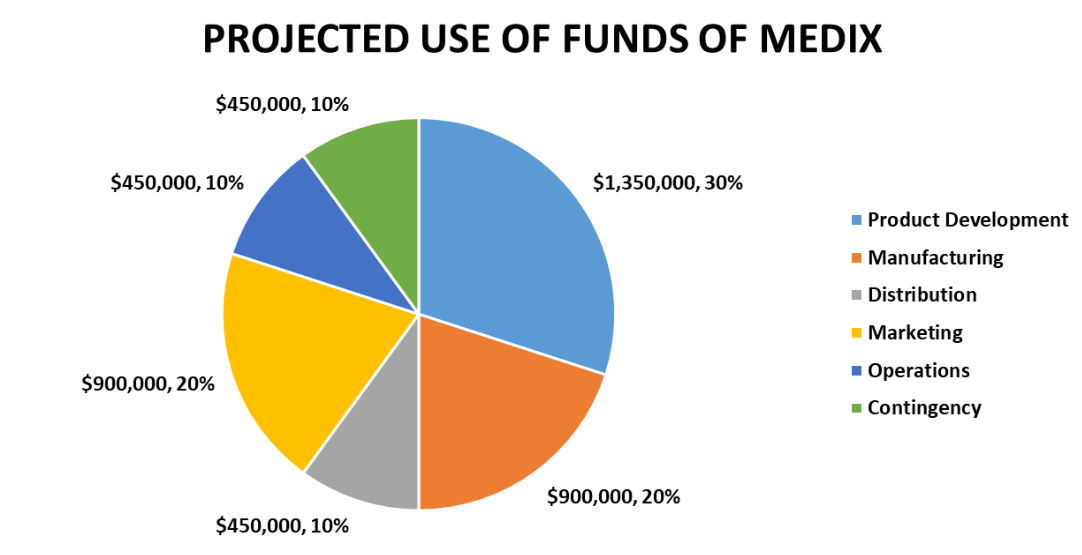
Key Assumptions
- Market size for our products is 10% of the total number of people with diabetes in the US and Europe
- Market share is projected to grow from 107,000 customers in 2024 to 444,000 customers in 2026
- Sales volume is projected to grow from 321,000 units in 2024 to 1.33 million units in 2026
- Gross margin is projected to be 60% in all three years
- Net margin is projected to grow from 20% in 2024 to 30% in 2026
Financial Projections
Based on the above assumptions, we have prepared the following financial projections for the next three years:
Income Statement
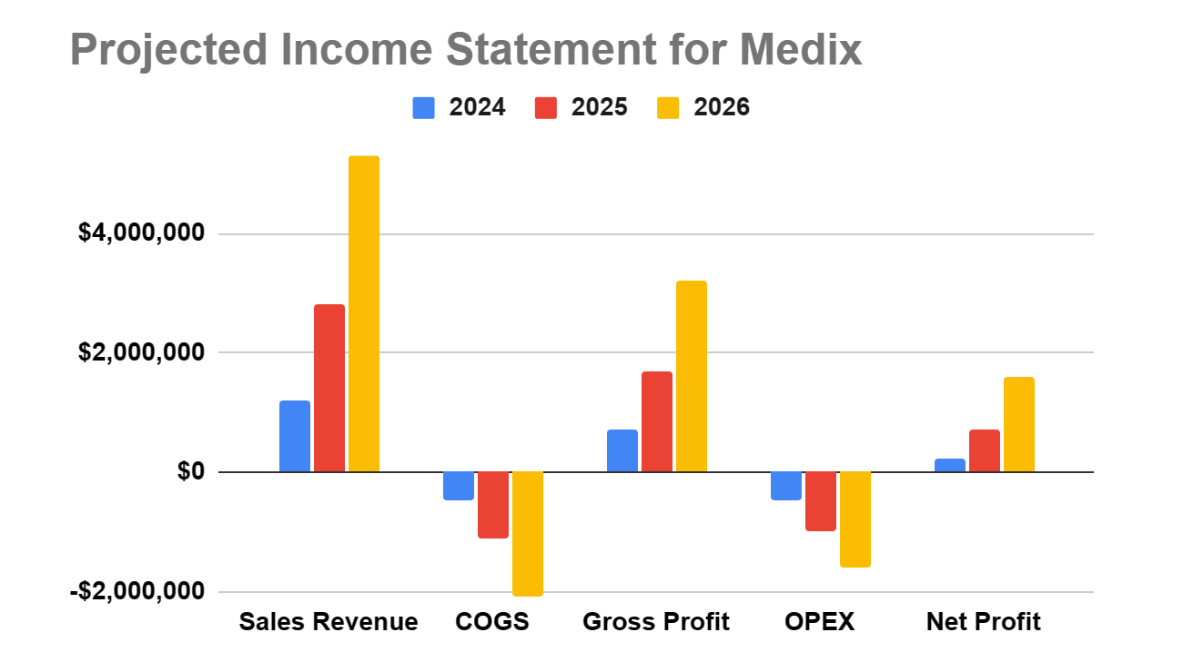
OGSCapital – Your Partner for Medical Device Startup Success
With over a decade of experience, at OGSCapital, we have helped various entrepreneurs craft winning business plans. Our consultants provide end-to-end support – from market research and competitor analysis to realistic profitability forecasts. We understand the medical device industry inside-out, including regulations, manufacturing, and distribution.
Whether you need help with your hospital feasibility study , medical equipment manufacturing business plan, or medical supply store business plan, we tailor our approach to your specific product and goals. Partner with us to launch your startup on the path to profitability and rapid growth.
Frequently Asked Questions
How to start a medical device business.
A strategic business plan is a key ingredient in a startup medical device company. But that alone won’t cut it – the company also requires a talented group of professionals, structured product development procedures, a plan for meeting regulatory guidelines, and effective marketing tactics. A distributor or a medical equipment supplier can help distribute the devices.
How profitable are medical devices?
The medical equipment industry is booming with high growth potential. The average operating margin for medical equipment and supplies companies averages 2.87%. The medical device market will grow at a CAGR of 5.5% to 5.9% from 2022 to 2030.
How do I market my medical device?
As highlighted in our Medical Clinic Business Plan , some popular marketing channels to market a medical device include online platforms, social media, trade shows, conferences, webinars, publications, referrals, and testimonials. A medical equipment rental company can also help market the device.
OGSCapital’s team has assisted thousands of entrepreneurs with top-rate business plan development, consultancy and analysis. They’ve helped thousands of SME owners secure more than $1.5 billion in funding, and they can do the same for you.

Add comment
E-mail is already registered on the site. Please use the Login form or enter another .
You entered an incorrect username or password
Comments (0)
mentioned in the press:
Search the site:
OGScapital website is not supported for your current browser. Please use:


How to Build a Digital Health Startup in 2024
Without a doubt, the demand for tech-enabled and digitally-focused healthcare and medicine continues to grow and 2023 is projected to be a record-breaking year for the digital health industry.
Clearly, the need for digital health solutions is at an inflection point.
But just how exactly should you go about building a startup in this $3.8 trillion (yes that’s with a “t”) industry? And more importantly, how you do avoid the traps and dead-ends of all those that have tried and failed before?
Seven steps to building a Digital Health Company
Well, let me cut to the chase. Follow these seven steps for building a digital health startup in 2023 and you’ll be way ahead of everyone else:
- Develop and test a digital-first problem solution
- Articulate a testable digital-first business model
- Plan your digital infrastructure
- Ruthlessly avoid building commodity technology
- Prototype, iterate, and get feedback
- Fuel the vision with funding (VC, strategic, non-dilutive)
- Scale using e-commerce best practices
Easy right? Well, you’d be surprised how non-obvious this is to a lot of people.
Why are there still so many small companies spending money on building redundant systems?
If there’s one piece of advice you learn today, it is that building a company in digital health today is very different than even a few years ago .
The world has changed and what worked just 3 or 4 years ago, may not work today
The big difference is the speed at which healthcare companies can generate value in the marketplace today. That speed is completely enabled by a deep understanding of what to build and even more importantly, what NOT to build.
There are just so many more products and services available today that have made available what were traditionally closed ecosystems.
Those that understand how to access the right solutions quickly and only spend time building what they absolutely have to will be the fast movers in today’s digital health marketplace .
It’s important to remember that most digital health companies need to have the same backend infrastructure in place as traditional healthcare providers.
We’re not talking about old-school IT systems. Rather, we’re talking about tech stacks specifically designed for healthcare software and healthcare integrations.
If you plan on launching a small business, startup, or private practice in the healthcare sector, we’re here to help. Keep reading to see the tips and strategies you can use in our guide to launching a digital health startup in 2023.
Specifically, we’ll be covering the digital health tools and health tech stacks that are key to launching in digital health today.
Starting your own digital health company from the ground up doesn’t have to be so difficult.
Examples of Successful Digital Health Apps
For inspiration, it helps to look at a few major examples of successful digital health applications. Some examples include the following:
- Mobile MIM – This platform was not only the first medical app to be granted access in the iTunes store, but it’s also the first major app to be released for sharing radiation imaging between physicians and peers.
- Kry – This virtual physician and therapist app has raised $500 million to date. This Swedish platform makes it possible for patients to meet with their physicians or therapists at any time, at any place.
- Hinge Health – For U.K. residents who deal with chronic musculoskeletal conditions that make it difficult to travel, Hinge Health provides digital care programs.
- AmWell – One of the biggest digital health companies out there, AmWell’s platform makes it possible to deliver HIPAA-compliant and extremely secure telehealth services to patients in need of urgent care, therapy, and other needs.
- MDLive – Consultation meetings with potential doctors or physicians can be quite convenient. During the pandemic, they were almost impossible. MDLive makes it possible for physician consultations to take place straight from home, quickly and easily. This platform is praised by patients and doctors alike.
We’ll mention a few more digital health giants later on in this guide as well.
Related: How To Build Amazing Digital Health Products That Patients Love
The New Digital Health Tech Stack
The Business models of virtually every single healthcare company founded over 10 years ago are vulnerable
The underlying infrastructure required to build a healthcare company has changed, and most entrenched companies have been slow to adopt these changes.
Leaning into these infrastructure changes will not only let your company optimize for speed but also take advantage of modern tech.
The cost to start a new healthcare product has never been lower which means that are plenty of new companies that can be seeded using infrastructure that’s been pre-built for you.
The analogy here is simple, think of AWS or Google Cloud. Amazon and Google have spent billions over the last decade bringing down the cost to store and manage data.
Not only that but they now provide full-service compute capabilities meaning that companies today don’t have to build their own data center to support a data-rich business model.
You can rent and scale your computing resources up or down as desired simply by clicking a few buttons.
New companies today can focus fully on creating businesses that solve pain points in the market and not spend valuable resources building computing infrastructure just to get off the ground. They can get the market faster and scale as quickly as needed.
Digital Health today is no different, except the infrastructure driving today’s companies are capabilities like data interoperability, white-label telehealth, APIs, AI/ML, and Clinical Operations.
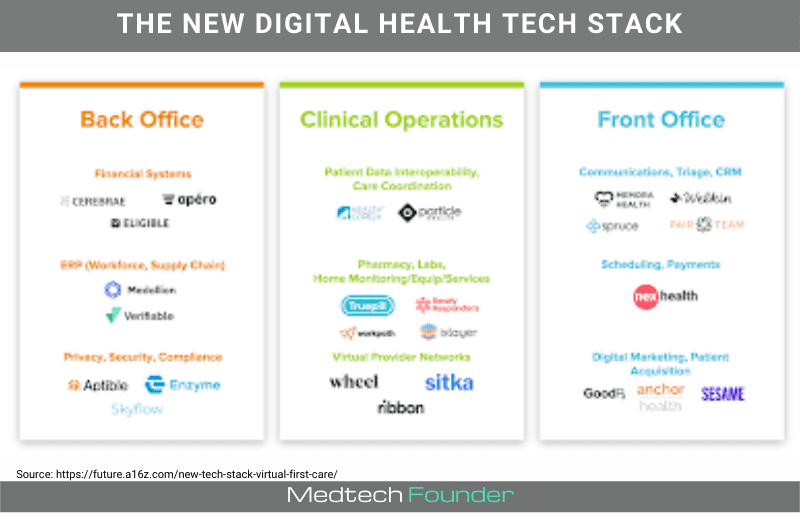
Digital Health Infrastructure Tools for 2023
There is an emerging ecosystem of healthtech companies that provide world-class tech-enabled services to the digital health market.
Today, each of these categories can be viewed as a micro-service where a digital health company might contract with multiple companies across these categories, or even create redundancy through multiple relationships within a category.
Many of these companies started within a very specific niche and have developed class-leading capabilities in a specific area. In the future, these companies will expand into adjacent areas, like Truepill for example.
Truepill started as virtual pharmacy API. They are now branching into telehealth and lab services.
The key to a successful digital health tech stack is interoperability.
Interoperability is the key to building a successful digital health application, as patients, physicians, clinicians, labs, and hospitals will need to interact seamlessly but still securely.
Interoperability should be the center of your digital health tech stack on a functional, structural, and semantic level.
Your client-side tech stack is what will be installed on a client’s machine of choice– such as their laptop, smartphone, etc. The client-side tech stack will make it possible for healthcare providers to run the environments and perform the tasks needed to run the app.
Server-side tech stacks are installed on a server. This tech stack will include all of the client-side technology in addition to database software and server software.
We mentioned the importance of implementing digital health infrastructure tools into your tech stack. However, nobody wants to have to build everything themselves.
Building your entire infrastructure and tech stack from the bottom-up is expensive, time-consuming, and usually not possible for many small digital health startups. And it’s a waste of resources in today’s market.
Do not build everything yourself. Spend the time upfront to identify a strategy where you leverage many of the great digital health infrastructure tools available today.
Let’s take a closer look at some of the key digital health infrastructure tools.
In the tech world, the cost of spinning up a startup plummeted like crazy thanks to Amazon’s Web Services (AWS). which lets startups rent out Amazon’s data storage and compute power.
This not only dropped the cost of starting a company from millions to hundreds of dollars but also allowed pay-as-use models that could scale with the companies as they grew.
Now, that same speed and cost reduction is coming to healthcare thanks to HIPAA-compliant cloud services. There are 119 different HIPAA-compliant AWS cloud services today vs 25 in 2017. Some of these are really cool healthcare-specific ones like AWS Comprehend Medical , which parses unstructured text data and maps it to different medical terms.
When it comes to the actual platforms your developers can use to build digital health and telehealth mobile and web apps, AWS Amplify is probably the most intuitive and simple platform to use. AWS Amplify is essentially a set of tools as well as services that can be used to help front-end developers build scalable, fully-fledged stack applications.
Amplify also supports pretty much every web framework under the sun, so it will integrate well with your framework of choice. Deployment with AWS Amplify is also quite simple.
If you’re considering working with connected medical devices. You’ll want to keep in mind device management services.
Phillips HealthSuite for example builds a layer on top of AWS to offer digital health-specific services for clinical and consumer applications and devices.
The Magic of Digital Health API’s
Api-as-a-service.
The proliferation of API-as-a-service has made it worth paying attention to in the digital health industry. One great API-first data solution to consider is Verifiable . This tool can be easily embedded into onboarding forms, thus making it possible for physician data to be pre-populated from a SSN. This significantly reduces friction throughout the provider onboarding process and removes many of the human error risks associated with data entry.
Eligible is a great product that could be used for back-office purposes for financial systems. This powerful API makes it easy to add insurance billing into your end product. In fact, this tool is trusted by developers from healthcare companies like Blue California and Omada. EHNAC accreditation, SOC II Compliance, and HiTrust certification are a few big perks to having this tool in your tech stack.
For patient data interoperability and care coordination, look at Particle . Particle makes it possible for startups to boost innovative solutions with data from hundreds of millions of patient records.
A rather simple API, Particle bridges the gap between digital health startups and the data being stored by thousands of hospitals and other networks. Particle’s API platform can unify this data into easy-to-work-with data records, secure access points, and so much more. If you have a limited development team, this intuitive tool could be very beneficial.
Ribbon Health is another great API-first company that provides healthcare enterprises with an API layer for accurate data on doctors, insurance plans, costs & quality of care. If you’re looking to build a provider network you’ll need the most accurate and up-to-date information (name, locations, hours, services offered, insurance accepted etc).
You’d be surprised how hard it is to keep directories up to date with this information. Ribbon’s API makes sure your directory is up to date always.
For EHR interoperability Redox is a leader in providing digital health companies API-based integration with many of the leading EHR systems like Epic and Cerner. They abstract away the complexity of this integration work and offer it a ready-made solution for a monthly fee. Many of the biggest medtech companies, like Stryker, Omron and Dexcom, work with Redox .
Suffice it to say that these are just a few of the API-as-a-service companies that support the digital health industry. The point here is that healthcare is complex and you need to test your value in the market as quickly as possible.
You’ll have a better shot at getting there if you’re not getting stuck trying to address outdated directories, EHR billing issues or provider credentialing challenges.
Use API-as-a-service infrastructure to build the foundation of your digital health startup.
Other useful tech stack tools
A few more digital health startup tech stack tools to consider include:
- ElasticSearch
- Anchor Health
- Amazon S3 and EC2
EMR and Existing Data registries
Verana Health and CorEvitas are taking this structured registry data and using it in new areas like life sciences. Registries are a viable approach to building a business, but the data is still coming from EMRs, so you’re not really replacing EMR so much as finding new use cases for the data.
Data registration is another big part of developing competitive and compliant digital health applications. Apache Spark is a unified analytics engine designed for the purpose of large-scale data processing. Apache Spark is popular because it can run workloads at lightning speeds, it’s very easy to use, it combines SQL with streaming with complex analytics, and it’s run virtually everywhere.
Many large organizations use Spark to process very large datasets, which is a vital ability to have if you’re dealing with massive amounts of patient and physician data. Plus, Spark is available as an open-source project– meaning you could potentially install and run it with absolutely no installation costs. Spark is also easy to program from most coding backgrounds, so your programming language of choice will implement well.
Bottom Line
One of the biggest benefits of this movement of digital health companies becoming buyers of healthtech is the raising of the quality bar for healthcare products—both in terms of the quality of the technology itself and that of the end-user experiences they enable.
To summarize:
- Look into what other successful digital startups have done and what they’re currently up to.
- Realize that there a ton of world-class companies building tools for digital health innovators
- Ensure that you invest your resources into proving your value in the market and not into rebuilding infrastructure that’s already out there.
- You do not have to build everything from the ground up by yourself. There are many excellent tools that you can implement.
How Medtech Founder Can Help
Medtech Founder was launched to help the medtech and digital health community launch their startups. Our goal is to boost the growth of successful digital health companies with more success than ever before. Specifically, we aim to guide and collaborate with startup founders to help them make the right choices when launching their company. From healthcare professionals to providers to entrepreneurs and tech developers, we’re helping pros in the digital health world by offering experience-based knowledge of the industry.
Get in touch with our team today to learn how we can help you get your digital health launch strategy right. Every entrepreneur deserves mentorship and assistance in the complex and intensive world of digital health. Medtech Founder is here to help!
How was our guide to building a digital health startup in 2023? We want to hear what your experience has been like in the comments below.
Join Me And The Community Of Innovators Shaping Digital Health Today
What’s trending.
- 10 Best Telemedicine Platforms for Healthcare Providers in 2024 January 7, 2024
- 16 Best Digital Health Investors in 2024 January 4, 2024
- Telemedicine – How it works and how to increase your income in 2024 January 20, 2024
Recent Posts
- 7 Best Digital Health Accelerators in 2024 February 2, 2024
- How to Build Amazing Digital Health Products That Patients Love January 20, 2024
- 10 Best APIs for Digital Health in 2024 January 16, 2024
- How to Get Started in Digital Health? A Comprehensive Guide January 15, 2024
- Digital Health How to Guide
- Digital Health Tools
- Remote Patient Monitoring
- Startup Funding
- Telemedicine
Recently Written

Author Christian
Join the discussion 7 comments.
- Pingback: 10 Best APIs for Digital Health in 2023 - Medtech Founder
- Pingback: 7 Best Digital Health Accelerators in 2023 - Medtech Founder
- Pingback: 15 Best Digital Health Investors in 2022 - Medtech Founder
- Pingback: 10 Best Telemedicine Platforms for Healthcare Providers in 2022
- Pingback: How to Build Amazing Digital Health Products That Patients Love - Medtech Founder
- Pingback: How to Get Started in Digital Health? A Comprehensive Guide
Leave a Reply Cancel Reply
Save my name, email, and website in this browser for the next time I comment.
Copyright © 2024 Medtech Founder All rights reserved.
- Make Money in Telemedicine
- Get Startup Funding
- Tools and Resources
- 7 Best Digital Health Accelerators in 2024
- How to Build Amazing Digital Health Products That Patients Love
- Telemedicine – How it works and how to increase your income in 2024
- 10 Best APIs for Digital Health in 2024
- How to Built a Digital Health Startup
- How to get Started in Digital Health
- How to Build Amazing Digital Health Products
- How to Maximize Your Telemedicine Revenue
- Best Telemedicine Platforms
- Best Remote Patient Monitoring Strategies
- Best Digital Health Investors
- Best Digital Health Accelerators
- How to Win SBIR Grants
- SBIR Proposal Templates
- Best APIs for Digital Health
- Digital Health Meetings
- Free NSF SBIR Template
- Free NIH SBIR Template
Join the Community
@medtechfounder
- Credit cards
- View all credit cards
- Banking guide
- Loans guide
- Insurance guide
- Personal finance
- View all personal finance
- Small business
- Small business guide
- View all taxes
You’re our first priority. Every time.
We believe everyone should be able to make financial decisions with confidence. And while our site doesn’t feature every company or financial product available on the market, we’re proud that the guidance we offer, the information we provide and the tools we create are objective, independent, straightforward — and free.
So how do we make money? Our partners compensate us. This may influence which products we review and write about (and where those products appear on the site), but it in no way affects our recommendations or advice, which are grounded in thousands of hours of research. Our partners cannot pay us to guarantee favorable reviews of their products or services. Here is a list of our partners .
18 Health Care Business Ideas for Passionate Entrepreneurs

Many or all of the products featured here are from our partners who compensate us. This influences which products we write about and where and how the product appears on a page. However, this does not influence our evaluations. Our opinions are our own. Here is a list of our partners and here's how we make money .
The health care sector is an amazing place for aspiring entrepreneurs to open up shop. Exploring health care business ideas is smart for lots of reasons.
There’s an opportunity to do a world of good by serving an aging American population and helping those struggling with the national drug crisis. There are lots of new medical and technological advances, and widespread interest in health and wellness, too. And those are all great incentives for passionate entrepreneurs.
Plus, these factors combined mean there's a thriving market for health-related businesses. Aspiring new business owners can turn one of many health care business ideas into a viable way to make a living, including those entrepreneurs who want to work remotely.
This list of health care business ideas should get you started — and maybe inspire you to explore starting a business.

Why businesses in health care are worth exploring
Nationwide spending on health is projected to grow at an average rate of 5.5% annually through 2026. That’s one percentage point faster than the national GDP is projected to grow during that same time. And by 2026, health care is projected to account for nearly 20% of the GDP.
Employment in health care-related occupations is projected to grow 18% from 2016 to 2026, much faster than the average for all occupations, according to the U.S. Bureau of Labor Statistics. Nearly half of the 20 occupations projected to have the highest percentage increase in employment by 2026 are in the health care industry.
What that spells is a lot of opportunity.
One big reason for the surge in health care spending: By 2030, the Census Bureau projects, approximately one-fifth of the population will be 65 and older. This will be the first time in history that the number of Americans over age 65 will surpass the number of Americans under 18.
Keep those numbers in mind as you look through this list of health care business ideas.
How much do you need?
with Fundera by NerdWallet
We’ll start with a brief questionnaire to better understand the unique needs of your business.
Once we uncover your personalized matches, our team will consult you on the process moving forward.
18 health care business ideas to consider
1. medical transcription services.
Medical transcriptionists transcribe doctors’, nurses’ and other health care practitioners’ voice recordings into written documents for patients’ records. Speech recognition technology has definitely improved the efficiency of medical transcription, sure. But it certainly hasn’t yet replaced the need for human transcriptionists to review and correct the transcriptions to make sure they’re accurate.
This is a great business to run from home because you can make your own hours, and all of the work can be done digitally. Plus, if you’re digitally savvy and can create an efficient (and secure) way to share files, you can really one-up the competition.
2. Medical records management
Start a service that manages medical records for hospitals, clinics and doctors’ offices. You can work with clients to identify the best records management systems, implement them and provide their staff with training on how to use the systems.
Another approach? You can offer full-service medical records management, and clients can outsource the work to you. This can be helpful for boutique practices and sole practitioners who need the organization but can’t afford the in-house staff.
3. Physical/occupational therapy center
Physical therapists help patients recover from injuries to regain their full range of motion and reduce pain. Occupational therapists provide more specific therapy to help patients perform tasks of daily living, such as dressing themselves or feeding themselves. You can specialize in one or the other, or put both under one roof. Note that this does require certification.
4. Develop a health care app
Both health care providers and individuals alike are increasingly turning to mobile apps to track, record and manage medical conditions. The world is your oyster if you’re skilled in app development, so you might want to consider developing your own health care app targeting these markets. Do some field research to find out where your skills can fit a need.
5. Diabetic care center
According to the CDC, 9.4% of all Americans either have diabetes or are prediabetic . Opening a diabetic care center can help diabetic patients improve their quality of life by providing nutrition counseling, dialysis and other medical services. You can also provide preventive help such as teaching healthy eating habits or providing support groups for diabetics.
6. Home health care service
A home health care business provides in-home medical care for recently discharged hospital patients, patients with chronic health conditions, seniors and others who need assistance managing their health.
In states with rapidly aging populations, like Florida and California, not only could this be a benefit to the community — but also a strong business prospect for you.
7. Medical foot care
A growing population of seniors and diabetics means more need for foot care services. Something as simple as trimming toenails can be impossible for seniors and overweight patients who can’t reach their feet. You can either open a foot care clinic or save patients a trip to the podiatrist by providing mobile foot care services in their homes or in a van. You’ll need to train as a podiatrist or hire one.
8. Drug treatment/rehabilitation center
As drug use has escalated to become a national crisis in the United States, legitimate places for people to seek treatment for their addictions and rebuild their lives are needed more than ever. Every day, more than 115 Americans die after overdosing on opioids, according to the National Institute on Drug Abuse .
Open a drug treatment and rehabilitation center to help clients with drug addiction. You can specialize in different types of patients, such as juveniles or more senior patients.
9. Childbirth services
Today's expectant parents want to control every aspect of childbirth, and that often includes having a midwife or doula present at the birth. The use of midwives is increasing , according to the American College of Nurse-Midwives.
Midwives are trained health care providers who assist women during childbirth, while a doula is more like a pregnancy coach who helps couples arrange all aspects of the birth and caring for the newborn. You can either become certified yourself or open a business that employs contractors under your umbrella.
10. Medical billing service
Medical billing requires performing complex coding when submitting insurance claims. Keep in mind, certification is required in this field to ensure that doctors and other health care practitioners get paid.
Although big hospitals and health care organizations often have in-house staff, small medical practices that don’t have time to manage billing and coding themselves are an ideal market for medical billing services. Acquire and learn medical billing software, get trained in proper coding and target these smaller medical practices to take medical billing hassles off their hands. And you can even earn your certification online.
11. Nutritionist/dietitian
If you want to help people improve their nutritional intake and habits, you can build a business as a nutritionist or dietitian. Only nutritionists who get a license with the Commission on Dietetic Registration, or CDR, can advertise themselves as dietitians. Some states regulate nutritionists and others don’t.
You can specialize in different types of clients, such as sports nutrition, nutrition for weight loss or holistic nutrition.
12. Alternative health care
Acupuncture and massage therapy are two alternative health care business ideas that are becoming more popular. Many are using these services to supplement their traditional medical treatment — or as a primary treatment unto itself.
Check with your state to see what the requirements are to practice; they vary across the country. Even when health insurance plans don’t provide coverage, Americans are more willing to pay out-of-pocket for these types of care than they used to be.
13. Health information website
If you have health care expertise — or access to people who do — consider starting a website to provide health care information and advice. You can create all kinds of content, such as podcasts, YouTube videos and even online classes, in addition to blog posts.
You might even be able to get health care experts to contribute content for free in exchange for the publicity your site offers. There are a lot of options; just make certain that you do some market research to figure out the white space to fill, and find viable revenue streams to make your business highly sustainable, too.
14. Medical supply sales
Seniors, people with disabilities and those with chronic illnesses have an ongoing need for medical supplies and equipment. This can include walkers, braces, bedpans and more.
Although you can open a physical store, keep in mind that your target customers will often have difficulty getting to your location, so an online store is likely a better bet. Again, research here will be key so you can make sure that you’re stocking the right products and marketing in the right places.
15. Stylish uniforms for medical professionals
Medical professionals who wear scrubs to work are always looking for affordable and durable uniforms. They’re also looking for stylish options — and those aren’t as easy to find. Start a store selling scrubs, comfortable shoes, lab coats and other gear for health care professionals. You can design the goods yourself or source them from multiple places, and encourage your customers with word-of-mouth incentives to drive sales.
16. Hearing aid dispensary
Because hearing aids generally aren’t covered by health insurance, this can be a lucrative health care business idea if you find the right customer base. You might want to open a location to provide hearing tests, recommendations and hearing aid fittings and care. You could even outfit a mobile van to come to customers' homes to clean and repair their hearing aids as an extra service.
17. Respite care service for caregivers
Whether they’re parents caring for severely disabled children or adult children caring for aging parents, caregivers have a stressful job. Provide a much-needed break for caregivers by starting a respite care business. Your caregivers can come in for a few hours or a few days, giving family caregivers a chance to rest.
18. Medical marijuana dispensary
As a growing number of states legalize medical marijuana, this $8 billion industry is projected to continue its growth, according to IBISWorld . Opening a medical marijuana dispensary can be a profitable business in the right location; however, changing state and federal regulations could affect your startup. (Marijuana is still illegal under federal law.)
Frequently asked questions
How do i start a health care business.
When you start a health care business, it can be helpful to begin by writing a business plan, registering your business and hiring employees. While all businesses need to obtain any necessary licenses, permits and forms of insurance, health care businesses may require earning professional designations or taking out extra forms of insurance. Research what you need to run your business safely and legally before you launch.
How do I start a home health care business?
Starting a home health care business requires a high level of professionalism, even if you’re running a business where the bulk of the work will occur in your clients’ homes. For example, you may still need office space to train your employees. Like starting any business, it is important to write a business plan, register your business and create proper business procedures. You should also obtain any necessary licenses, permits and insurance for running a business in your area, as well as for working within the health care industry.
How do I write a business plan in health care?
In general, a business plan is an organizational tool that business owners can follow when they need guidance. This document can also tell outside parties, such as investors, about your business and its value. A good business plan should include thorough research about your industry, market and competitors, as well as dive into your financials, products and services and your marketing plan. When writing a business plan in health care, it will be important to do heavy research on the industry, as well as outline clearly what medical services or products you will be offering and why you or your staff are qualified to run a health care business safely.

Start Your Dream Business
The bottom line
There are a lot of potential great health care business ideas for entrepreneurs interested in the health care sector — and many opportunities for health care business ideas to become real, sustainable businesses.
Be sure to check regulations, licensing, professional training or degrees needed for these businesses before you get started, and do lots of market research. Don’t forget that “care” part, of course.
On a similar note...

Upmetrics AI Assistant: Simplifying Business Planning through AI-Powered Insights. Learn How
Entrepreneurs & Small Business
Accelerators & Incubators
Business Consultants & Advisors
Educators & Business Schools
Students & Scholars
AI Business Plan Generator
Financial Forecasting
AI Assistance
Ai pitch deck generator
Strategic Planning
See How Upmetrics Works →
- Sample Plans
- WHY UPMETRICS?
Customers Success Stories
Business Plan Course
Small Business Tools
Strategic Canvas Templates
E-books, Guides & More
- Sample Business Plans
Medical & Health Care Business Plans
- IT, Staffing & Customer Service
- Construction, Architecture & Engineering
- Food, Beverage & Restaurant
- Real Estate & Rentals
- Mobile Apps & Software
- Education & Training
- Beauty Salon & Fitness
- Medical & Health Care
- Retail, Consumers & E-commerce
- Entertainment & Media
- Transportation, Logistics & Travel
- Agriculture, Farm & Food Production
- Nonprofit & Community
- Manufacturing & Wholesale
- Clothing & Fashion
- Children & Pets
- Fine Art & Crafts
- Cleaning, Maintenance & Repair
- Hotel & Lodging
- Finance & Investing
- Consulting, Advertising & Marketing
- Accounting, Insurance & Compliance
How To Write an Apothecary Business Plan + Template
How to Write Sober Living Home Business Plan + Free Template
Mobile Phlebotomy Business Plan
Yoga Studio Business Plan
Esthetician Business Plan
Urgent Care Business Plan
Health Coaching Business Plan
Medical Lab Business Plan
Optometrist Business Plan
IV Hydration Business Plan
CrossFit Gym Business Plan

Medical Transport Business Plan
Medical Billing Business Plan
Mental Health Private Practice Business Plan
Telemedicine Business Plan
Veterinary Clinic Business Plan
Rehabilitation Center Business Plan
Hospital Business Plan
Counseling Private Practice Business Plan
Chiropractic Business Plan
Dental Business Plan
Medical Practice Business Plan
Physical Therapy Business Plan
Wellness center Business Plan
Senior Daycare Business Plan
Cannabis Cultivation Business Plan
Tanning Salon Business Plan
CBD Business Plan
Non-Medical Home Care Business Plan
Medical Spa Business Plan
Gym Business Plan
Medical Equipment Business Plan
Massage Therapy Business Plan
Pharmacy Business Plan
Home Health Care Business Plan
Dispensary Business Plan
Skin Care Business Plan
Residential Assisted Living Business Plan
Personal Trainer Business Plan
Did you find what you are looking for.
Whether you plan to start a professional medical practice or a veterinary clinic, you need a clear roadmap to drive it to success.
Need help writing a business plan for your healthcare business?
This library of healthcare and medical business plan examples here can inspire and guide you as you begin to plan your business. So, don’t worry; we got you covered on that part.
Let’s learn more about these sample health and medicine business plans, starting with their benefits.
Benefits of using an industry-specific business plan example
Believe it or not, using an industry-specific business plan example is the best and probably the quickest way of writing a business plan.
Doubt it? Hold, this may change your perception; an extended list of the benefits of using an industry-specific business plan template.
- Inspiration : Reading a business-specific template can be incredibly helpful in getting content inspiration. Furthermore, it helps you gain insights into how to present your business idea, products, vision, and mission.
- Risk-free method : You are taking a reference from a real-life, let’s say, health coaching business plan—so you know this plan has worked in the past or uses a method subscribed by experts.
- Deep market understanding : Analyzing and reading such examples can provide clarity and develop a deeper market understanding of complex industry trends and issues you may not know but relate directly to the realities of your business landscape.
- Increased credibility : A business plan developed using an example follows a standard business plan format, wisely presents your business, and provides invaluable insights into your business. There’s no question it establishes you as a credible business owner, demonstrating your deep business and market understanding.
- Realistic financial projections : Financial forecasting being a critical aspect of your plan, this real-life example can help you better understand how they project their financials—ultimately helping you set realistic projections for your business.
These were the benefits; let’s briefly discuss choosing an medical business plan template that best suits your business niche.
Choosing a Medical and Health Care Business Plan
This category itself has 30+ business plan templates for various healthcare businesses. With many similar business types and templates, you may not find the most suitable one through manual scrolling.
Here are the steps to consider while choosing the most suitable business plan template.
Identify your business type
Are you going to be a rehabilitation providing nature therapy? Or a medical lab? Or planning on starting an urgent care center?
Asking yourself these questions will help you identify your business type, which will help in choosing a niche-specific business plan template.
Once you identify your business type, you can choose between templates for different business segments.
Search for the template
We have an in-built search feature, so you can easily search for a business-specific template using your business name as a key term. Once you have the search results, choose the most suitable one. Simple as that.
Review the example
Look closely at the content of the sample business plan you are considering. Analyze its sections and components to identify relevant as well as unnecessary areas.
Since all the Upmetrics templates are tailored to specific business needs, there won’t be many fundamental customizations. However, a hybrid business model targeting multiple customer segments may require adjustments.
For instance, if you plan to start a medical practice that also provides urgent care services—you may need to make necessary adjustments in some of your business plan sections based on your service offerings.
No big deal—you can view and copy sections from other business plan examples or write using AI while customizing a template.
That’s how you find and select the most suitable medical business plan template. Still haven’t found the perfect business plan example? Here’s the next step for you.
Explore 400+ business plan examples
Discover Upmetrics’ library of 400+ business plan examples to help you write your business plan. Upmetrics is a modern and intuitive business plan app that streamlines business planning with its free templates and AI-powered features. So what are you waiting for? Download your example and draft a perfect business plan.

From simple template to full finished business plan
No Risk – Cancel at Any Time – 15 Day Money Back Guarantee
Popular Templates
Medical Practice Business Plan Template
Written by Dave Lavinsky
Medical Practice Business Plan
You’ve come to the right place to create your Medical Practice business plan.
We have helped over 10,000 entrepreneurs and business owners create business plans and many have used them to start or grow their Medical Practices.
Medical Practice Business Plan Example
Below is a template to help you create each section of your Medical Practice business plan.
Executive Summary
Business overview.
Fresno Medical is a new medical practice located in Fresno, California. Our goal is to provide affordable healthcare to individuals and families living in the area and surrounding communities. We offer general and preventative healthcare for all ages, including checkups, screening tests, and immunizations.
Our medical practitioners and supporting staff are well-trained and have a passion for improving the health and well-being of our clients. We serve our patients not just with our knowledge and skills but also with our hearts. We aim to help our patients experience the best healthcare possible while maintaining relationships that last a lifetime.
Service Offering
Fresno Medical practice will focus on providing primary care services to every family member, from infants to adults. Some of the general and primary care services we provide include:
- Immunizations: flu shots, COVID boosters, measles, mumps, polio, etc.
- Annual checkups
- Pediatrics: checkups, developmental screening, immunizations, etc.
- Health screenings: blood pressure, cholesterol, depression, diabetes, etc.
- General health counseling
Fresno Medical will work with local and national insurance companies to ensure that every patient can afford our services. If the patient’s insurance does not cover all of their medical costs, Fresno Medical will provide payment plan options so that they are not overwhelmed by their medical bills.
Customer Focus
Fresno Medical will primarily serve the community of Fresno, California. The community consists primarily of middle to lower income residents who need access to affordable medical care. Many of these residents are hesitant to go to hospitals or other medical facilities due to their costs. We will offer lower prices, flexible payment plans, and flexibility when working with insurance companies to accommodate this demographic.
Management Team
Fresno Medical is owned and operated by Jessica Wells, who has been working as a doctor at local hospitals for 15 years. Throughout her career, she has worked for hundreds of patients and families with all their general and preventative care needs. Though she has never run a medical practice herself, she has worked in the industry long enough to gain an in-depth knowledge of the business, including the operations side (e.g., running day-to-day operations) and the business management side (e.g., staffing, marketing, etc.).
Fresno Medical will also employ nurses, expert medical staff, and administrative assistants that are passionate about helping the local community.
Success Factors
Fresno Medical will be able to achieve success by offering the following competitive advantages:
- Location: Fresno Medical’s location is in a high-traffic area that is easily accessible to thousands of residents. It’s visible from the street with many people walking and driving to and from work on a daily basis.
- Patient-oriented service: Fresno Medical will have a staff that prioritizes the needs of the patients and educates them on the proper way to take care of themselves.
- Management: Jessica Wells has a genuine passion to help the community. Because of her previous experience and reputation in the medical community, she is fully equipped to open this practice.
- Relationships: Jessica Wells has developed strong connections with her patients and fellow staff throughout her career. Many patients have expressed interest in following Jessica to her new practice, and some former colleagues have shown interest in working for the clinic. Jessica also has relationships with medical equipment suppliers and insurance companies.
Financial Highlights
Fresno Medical is currently seeking $400,000 to launch. The capital will be used for funding capital expenditures, staffing, marketing expenses, and working capital.
The breakdown of the funding may be seen below:
- Clinic design/build: $100,000
- Medical supplies and equipment: $130,000
- Three months of overhead expenses (payroll, rent, utilities): $100,000
- Marketing and advertising: $50,000
- Working capital: $20,000
The following graph below outlines the pro forma financial projections for Fresno Medical.
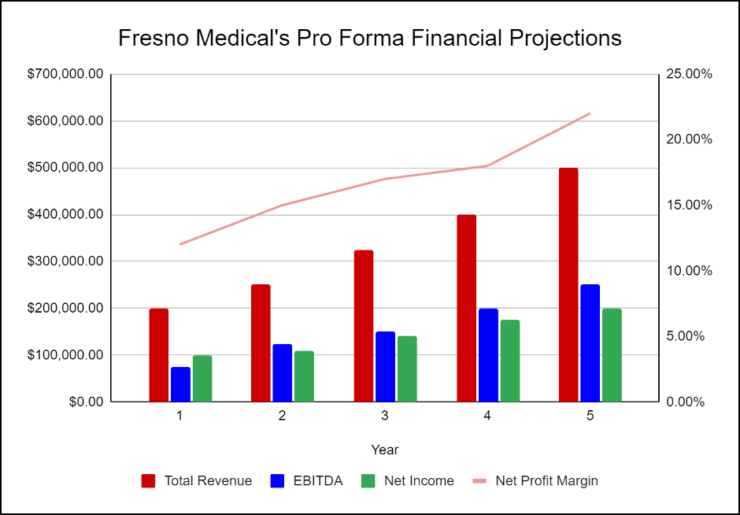
Company Overview
Who is fresno medical.
Fresno Medical is a medical practice located in Fresno, California. We offer general and preventative health care for all ages. We offer immunizations, pediatrics, health screenings, and more. Our medical practitioners and supporting staff are well-trained to improve the health and well-being of our patients.
Fresno Medical is run and owned by Jessica Wells, who has been a doctor in the local medical community for 15 years. She has helped hundreds of patients and families with their general healthcare needs throughout her career. She also has gained knowledge and experience in the operations and marketing aspects of the medical business, which will prove indispensable for this private practice.
Fresno Medical’s History
After years of working with patients in hospital settings, Jessica Wells decided to establish a private practice. She wanted to develop a closer relationship with her patients, which was difficult to achieve while working in a large hospital. With this goal in mind, Jessica incorporated Fresno Medical as an S-corporation on March 15th, 2023.
Since its incorporation, the medical practice has achieved the following milestones:
- Found a clinic space and signed a Letter of Intent to lease it
- Developed the company’s name, logo, and website
- Hired a contractor for the office build-out
- Determined equipment and fixture requirements
- Began recruiting key employees with previous healthcare experience
- Drafted marketing campaigns to promote the practice
Fresno Medical’s Services
Fresno Medical will focus on providing primary care services to every family member, from infants to adults. The costs will depend upon the materials used, the physician’s time, and the amount designated for each procedure. Some of the general and primary care services we provide include:
- Immunizations: flu shots, measles, mumps, polio, etc.
Fresno Medical will maintain privacy according to HIPAA regulations. All patients will be welcome, including those without insurance. However, we expect most patients to utilize their insurance plans to pay their costs. The medical practice will work with local and national insurance companies to ensure that every family can afford our services. After billing insurance, Fresno Medical will provide flexible payment plan options so that no patient is overwhelmed by their medical bills.
Industry Analysis
Healthcare is a human right that everyone deserves access to. The medical industry will always be a necessity as it is the industry keeping society alive and well. Therefore, the medical industry is expected to continue to grow as the population grows. This is especially true for private practices, as there is a rising demand for small, patient-focused clinics that provide top-tier medical services.
Furthermore, the demand for private physicians has been on the rise. Hospitals have been low on rooms and beds the past few years, and nurses and doctors have been overworked. This has led to an increased demand for more medical professionals and private practices that can help lessen the load of larger hospitals.
Moreover, the pandemic instilled the importance of quality healthcare and practices in the general population. We expect that people all around the world will now put in more effort towards taking care of their health and getting the care and screenings they need.
According to Facts & Factors, the global private medical market is expected to experience a compound annual growth rate (CAGR) of 12.5% over the next five years. This is enormous growth that is rarely seen in other industries. Furthermore, there is a growing demand for more primary care physicians as the general population aims to prevent developing chronic and preventable diseases. According to Grand View Research, the primary care market will experience a CAGR of 3.2% over the next 10 years, which is also moderate growth.
With such a demand for more medical practices and a greater emphasis on general health, we believe that Fresno Medical is starting at the right time and will see great success.
Customer Analysis
Demographic profile of target market.
Fresno Medical will serve the community residents of Fresno, California, and its surrounding areas. The community of Fresno, California has thousands of middle-class individuals and families seeking an affordable medical practice to take care of all their health concerns.
The demographics of Fresno, California are as follows:
Customer Segmentation
The company will primarily target the following customer segments:
- Middle-class individuals
- Hospital patients
Competitive Analysis
Direct and indirect competitors.
Fresno Medical will face competition from other companies with similar business profiles. A description of each competitor company is below.
City Metro Hospital
Founded in 1968, City Metro Hospital is one of the most popular hospitals in the area. Thousands of residents get all their primary care and emergency care needs taken care of with City Metro. It provides almost every service you can think of and enlists the help of thousands of doctors, nurses, and other expert medical professionals.
Though City Metro Hospital will continue to thrive, it does not foster an environment designed for long-lasting relationships. Since the pandemic, the hospital has been overwhelmed with patients and a staff shortage. This has led to doctors seeing thousands of patients and a tremendous increase in wait times. Fresno Medical will offer a more intimate setting where patients and doctors can create a long-lasting relationship that spans decades.
Quality Doctors
Quality Doctors is a private medical practice that provides highly personalized medical care. Quality Doctors includes a team of dedicated healthcare professionals with dual residency in emergency medicine and internal medicine. The practice offers same-day/next-day appointments, telemedicine, office visits, and home visits. Services offered by Quality Doctors include primary care, urgent care, and virtual visits.
Like City Metro Hospital, Quality Doctors is a large care system that cares for thousands of patients. This means that patients also do not get a close relationship with their doctor, which many crave. Furthermore, Quality Doctors has put much of its money and services toward emergency care in recent years and reduced its primary care services. Patients who want a lasting relationship with a primary care doctor will feel more welcome with Fresno Medical.
Johnson Community Care
Established in 1949, Johnson Community Care is a private medical practice with multiple locations. Patients all around the state can receive care at any location near them. Each site provides primary care services, emergency care, pharmacy services, and lab testing. Instead of heading to multiple locations to get all of these services, patients can get all their healthcare needs taken care of in one building.
Though Johnson is a highly successful medical practice, its major downfall is that it only provides services to those with its unique insurance plan. Therefore, anyone who has insurance through another company or plans provided by their employer cannot receive care at Johnson without paying out-of-network prices. Fresno Medical will partner with many insurance companies and provide flexible payment plans to help as many patients as possible.
Competitive Advantage
Fresno Medical enjoys several advantages over its competitors. These advantages include:
- Relationships: Jessica Wells has developed strong connections with her patients and fellow staff during her career. Many patients have expressed interest in following Jessica to her new practice, and some former colleagues have shown interest in working for the clinic. Jessica also has relationships with medical equipment suppliers and insurance companies.
Marketing Plan
Brand & value proposition.
The Fresno Medical brand will focus on the company’s unique value proposition:
- Client-focused healthcare services, where the company’s interests are aligned with the customer
- Service built on long-term relationships
- Big-hospital expertise in a small-clinic environment
- Moderate pricing for all preventative and general health services
Promotions Strategy
The promotions strategy for Fresno Medical is as follows:
Fresno Medical understands that the best promotion comes from satisfied patients. The clinic will encourage its patients to refer their friends and family by providing healthcare benefits for every new client produced. This strategy will increase in effectiveness after the business has already been established.
Social Media
We will maintain a social media presence to attract local clients looking for a new doctor or medical practice. We will post information about our team, services, and general health tips for better wellness. To create a genuine connection with our patients, we will also use social media to engage with them and answer any questions they may have about our practice.
Fresno Medical will have an informative and attractive website featuring all its services and referrals from other satisfied patients. The website will be highly informative and be designed in a way that is friendly and eye-catching.
Fresno Medical will invest in a high SEO presence so that the clinic is listed at the top of the Google or Bing search engine when a potential patient is researching private medical practices in Fresno, California.
Fresno Medical’s pricing will be significantly lower than big hospitals. We will partner with as many insurance companies as possible to ensure that our patients’ medical care is covered. For services not fully covered by insurance, we offer a flexible payment program so patients are not overwhelmed by their medical bills.
Operations Plan
The following will be the operations plan for Fresno Medical.
Operation Functions:
- Jessica Wells will operate as the CEO of Fresno Medical. She will run all the general operations and executive functions of the company. She will also provide basic medical care for patients until she can hire a full medical staff.
- Jessica is joined by Mindy Keller, who will serve as the Marketing Manager and run all of the marketing and advertising efforts.
- Jessica is also joined by Rhonda Smith, who will work as the Receptionist of the clinic and the Administrative Assistant for the company.
- Jessica is also joined by Cindy Nguyen who will be the company’s Head Nurse. She will manage and train incoming nurses and provide medical treatment to patients.
- Jessica will continue to hire a team of medical staff to treat the medical practice’s growing patient list. The team will consist of doctors, nurses, physicians, and other necessary medical staff.
Milestones:
Fresno Medical expects to achieve the following milestones in the following six months:
- 4/202X Finalize lease agreement
- 5/202X Design and build out Fresno Medical
- 6/202X Hire and train initial staff
- 7/202X Kickoff of promotional campaign
- 8/202X Launch Fresno Medical
- 9/202X Reach break-even
Fresno Medical is owned and operated by Jessica Wells, who has been working as a doctor at local hospitals for 15 years. Throughout her career, she has worked with hundreds of patients and families and taken care of all their general and preventative care needs. Though she has never run a private medical practice herself, she has worked in the industry long enough to gain an in-depth knowledge of the business, including the operations side (e.g., running day-to-day operations) and the business management side (e.g., staffing, marketing, etc.).
The medical practice will also employ nurses, expert medical staff, and administrative assistants that are passionate about helping the local community.
Financial Plan
Key revenue & costs.
The revenues for the medical practice will come from the fees it will charge the patients and their insurance for the health care services it provides.
The cost drivers for the company will include the payroll of the staff, lease on the office building, medical supplies and equipment, and marketing costs.
Funding Requirements and Use of Funds
Key assumptions.
The following outlines the key assumptions required in order to achieve the revenue and cost numbers in the financials and to pay off the startup business loan.
- Year 4: 100
- Year 5: 125
- Annual lease costs: $40,000
Financial Projections
Income statement, balance sheet, cash flow statement, medical practice business plan faqs, what is a medical practice business plan.
A medical practice business plan is a plan to start and/or grow your medical practice business. Among other things, it outlines your business concept, identifies your target customers, presents your marketing plan and details your financial projections.
You can easily complete your Medical Practice business plan using our Medical Practice Business Plan Template here .
What are the Main Types of Medical Practices?
There are a number of different kinds of medical practices , some examples include: Group medical practice, Private medical practice, and Hospital-based medical practice.
How Do You Get Funding for Your Medical Practice Business Plan?
Medical Practice businesses are often funded through small business loans. Personal savings, credit card financing and angel investors are also popular forms of funding.
A well-crafted medical practice business plan is key to securing any type of funding.
What are the Steps To Start a Medical Practice Business?
Starting a medical practice business can be an exciting endeavor. Having a clear roadmap of the steps to start a business will help you stay focused on your goals and get started faster.
1. Develop A Medical Practice Business Plan - The first step in starting a business is to create a detailed medical practice business plan that outlines all aspects of the venture. This should include market research on the medical industry and potential target market size, information the services or products you will offer, pricing strategies and a detailed financial forecast.
2. Choose Your Legal Structure - It's important to select an appropriate legal entity for your medical practice business. This could be a limited liability company (LLC), corporation, partnership, or sole proprietorship. Each type has its own benefits and drawbacks so it’s important to do research and choose wisely so that your medical practice business is in compliance with local laws.
3. Register Your Medical Practice Business - Once you have chosen a legal structure, the next step is to register your medical practice business with the government or state where you’re operating from. This includes obtaining licenses and permits as required by federal, state, and local laws.
4. Identify Financing Options - It’s likely that you’ll need some capital to start your medical practice business, so take some time to identify what financing options are available such as bank loans, investor funding, grants, or crowdfunding platforms.
5. Choose a Location - Whether you plan on operating out of a physical location or not, you should always have an idea of where you’ll be based should it become necessary in the future as well as what kind of space would be suitable for your operations.
6. Hire Employees - There are several ways to find qualified employees including job boards like LinkedIn or Indeed as well as hiring agencies if needed – depending on what type of employees you need it might also be more effective to reach out directly through networking events.
7. Acquire Necessary Medical Practice Equipment & Supplies - In order to start your medical practice business, you'll need to purchase all of the necessary equipment and supplies to run a successful operation.
8. Market & Promote Your Business - Once you have all the necessary pieces in place, it’s time to start promoting and marketing your medical practice business. This includes creating a website, utilizing social media platforms like Facebook or Twitter, and having an effective Search Engine Optimization (SEO) strategy. You should also consider traditional marketing techniques such as radio or print advertising.
Learn more about how to start a successful medical practice business:
- How to Open a Medical Practice

Medical Business Plan

You cannot start and run a successful medical business without writing and implementing a comprehensive business plan. A business plan gives you a complete framework for researching and analyzing the market, identifying possible opportunities, financing the project, and scaling it all together. Here are some of the best examples of medical business plans worth having a look.
Medical Practice Business Plan Template
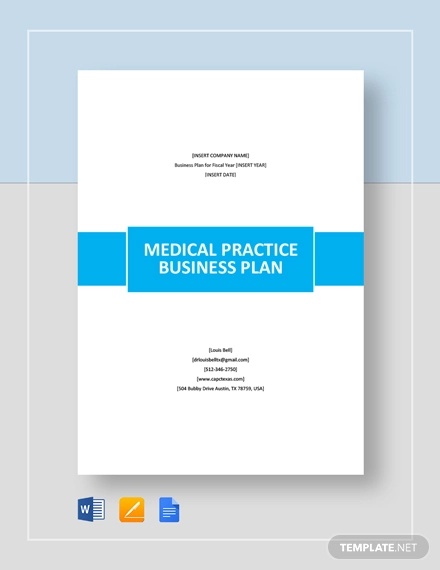
- Google Docs
Size: A4, US
Medical Laboratory Business Plan Template
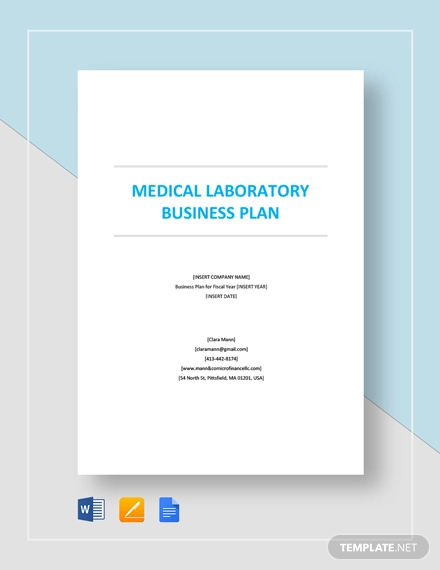
Dispensary Business Plan Template
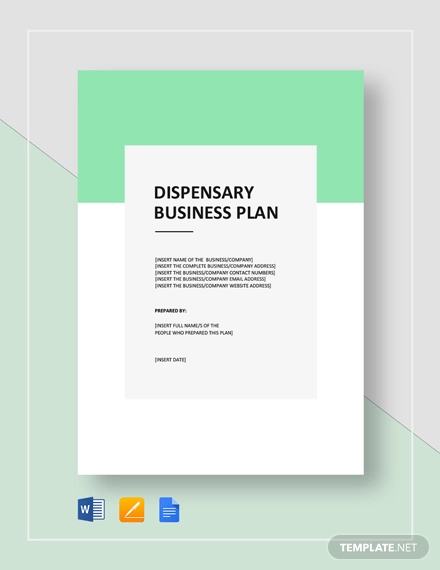
Fertility Clinic Business Plan Template
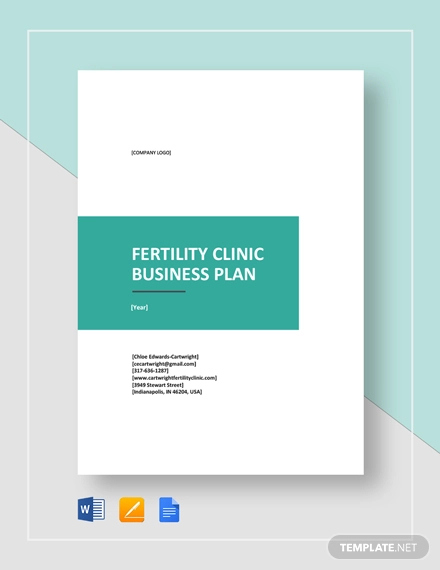
Fertility Clinic Marketing Plan Template
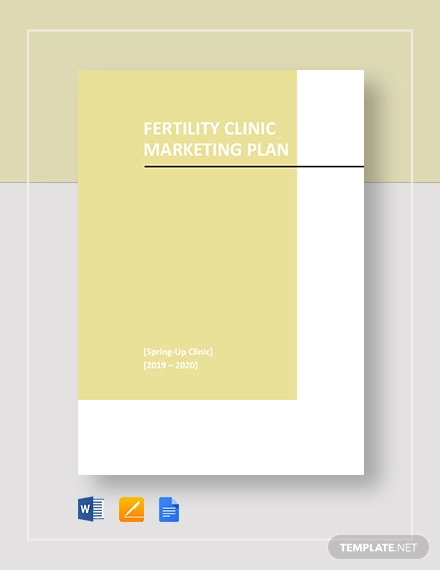
Pharma or Drug Sales Plan Template
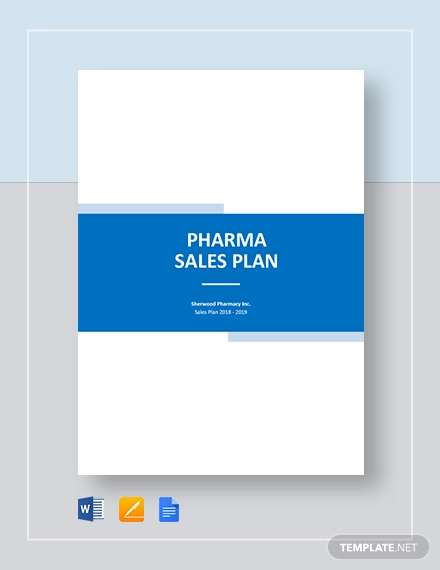
Medical Clinic Sales Plan Template
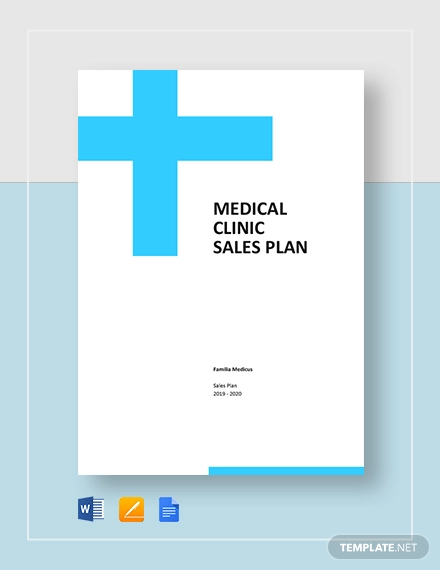
Medical Device Sales Plan Template
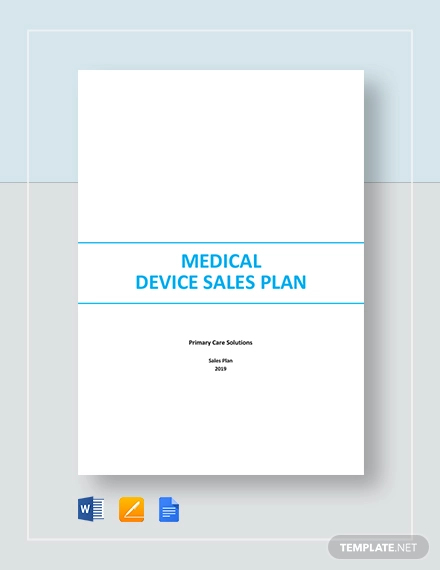
Executive Medical Reimbursement Plan Template

Best Medical Business Plan Examples & Templates
medical business plan example.

Size: 8.86 MB
If writing a medical business plan were easy, every business aspirant would do it with ease. To be clear, a comprehensive business plan for a new healthcare facility takes time to put together. But, what if you are green in this in the first place? The best thing to do is to look at a sample plan to get a clear picture of what a comprehensive strategy for a health facility looks like. This PDF file is a unique sample of a well-written business strategy for a healthcare facility. The plan covers everything you need to know about establishing a healthcare center, from business objectives and guiding principles to demographic analysis and their access to care.
Printable Medical Business Plan
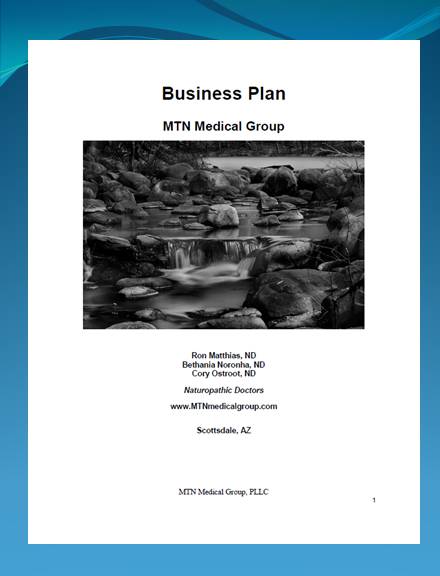
Size: 780 KB
It doesn’t make sense to start a medical business without a strategy in place. You need to identify your audience, sturdy the market, conduct a SWOT analysis , and develop a marketing technique. This calls for a comprehensive business plan and here is an example that you can download and use as a guide to writing your own strategy. This sample will help you to understand a few things. First, you’ll learn how to write a clear summary of the proposed medical business. Second, you will see what a detailed business description looks like. Third, you will dive deep into learning and understanding the competition. Then, you will learn about financial strategy, which is important for starting and running a healthcare business at scale.
Free Medical Business Plan Example
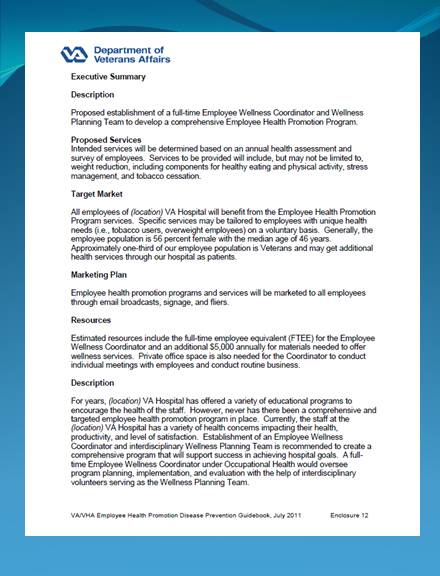
Size: 88 KB
It is important to understand that a business plan does not have to be complicated. It doesn’t have to be dozens or hundreds of pages either. In fact, you can set up and run a successful medical business with a very simple business plan . This PDF document is an example of a very simple business strategy, which a clear indication that even lean business plans can help you take a step in the right direction. This plan covers a number of sections, including an executive summary for the proposed business, proposed services, market evaluation, and marketing approach. Click the link above to download the PDF file.
Medical Practice Business Plan Example

Size: 237 KB
This PDF document is one of the most comprehensive medical business plans that you can read to understand what a professionally written business strategy looks likes. The 37-page file features a unique outline, which makes the entire document easy to scan. This file has a lot of information. From the executive summary and market sturdy to SWOT and market analysis , there is quite a lot to learn. The author uses a simple language throughout the document. So, whether you are green to writing a business proposal or you just need a simple example for reference, this is a good template to download.
Medical Startup Business Plan Example
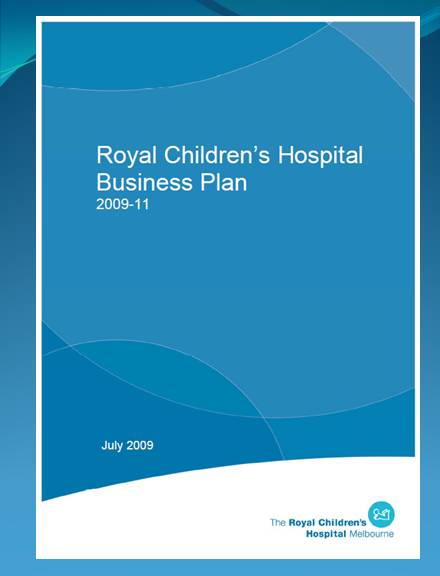
Size: 219 KB
You cannot start and run a successful business without a plan. In fact, many businesses that begin to operate without a strategy often close within the first six months. This happens across various industries, even in medical business. Now that you have made up your mind to start a medical business, you first need to write a business plan. If you have never written one before, don’t worry. You can just download this PDF file, read the entire strategy example, and then use the same knowledge that you pick from it to write a comprehensive business plan of your own. Click the link above to download this template.
Medical Business Plan Example for Clinic
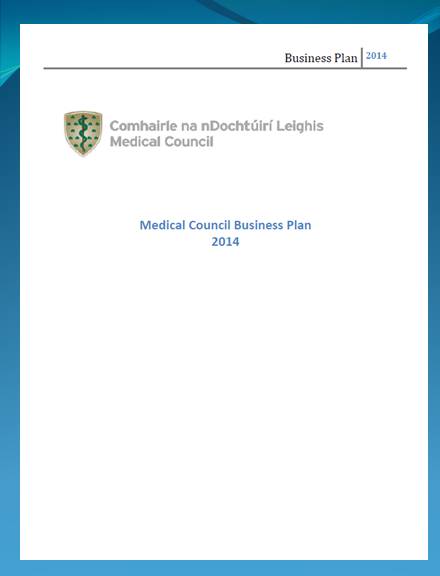
Size: 262 KB
Ask every serious entrepreneur what it takes to start and run a successful business and they’ll tell you that the first thing you need is a business plan. This tells you that a successful business depends on a comprehensive strategy . Now that you have made up your mind that it is time for you and your stakeholders to start a clinic in your locale, it’s important to write a business plan before investing money in the project. The plan will enable you to determine whether the business is feasible to pursue. By finding, connecting with, and studying the target market, it becomes easy to understand your business even before starting it. Download this medical plan for the clinic to learn more.
Private Hospital Business Plan Example
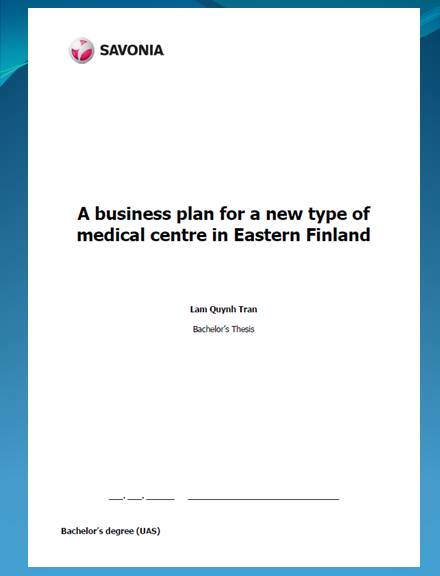
Size: 2.15 MB
Even if you have enough funding to start a private hospital, you’ll need to do in-depth research and then come up with a solid business plan that will help you set up the enterprise. At the end of the day, your goal is to run a successful business . This is something you can’t do if you start with a proper strategy. Remember, the success of your private medical startup will depend on the structure of the plan. The success of the upcoming business will depend on the structure of the plan. In other words, a business plan is a must-have.
Simple Medical Business Plan Example
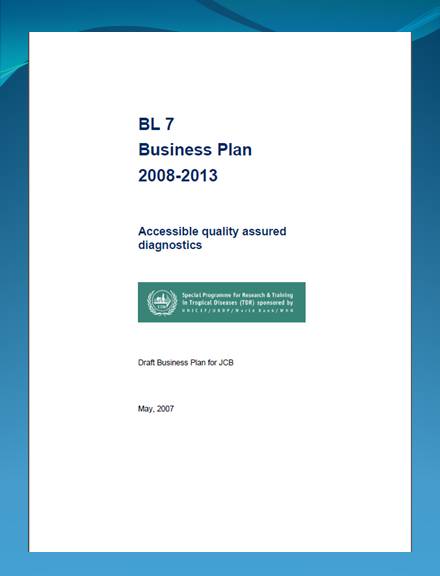
Size: 141 KB
You already know that it is difficult to run a successful business without a plan. So, if you want to set up a new medical facility in your area, first start by writing a business plan for the foreseen startup. The PDF file above is a unique example of a business plan that you can use for reference. This guide is important because it focuses on the most important elements that make up a comprehensive business plan.
Comprehensive Business Plan for Medical Facility
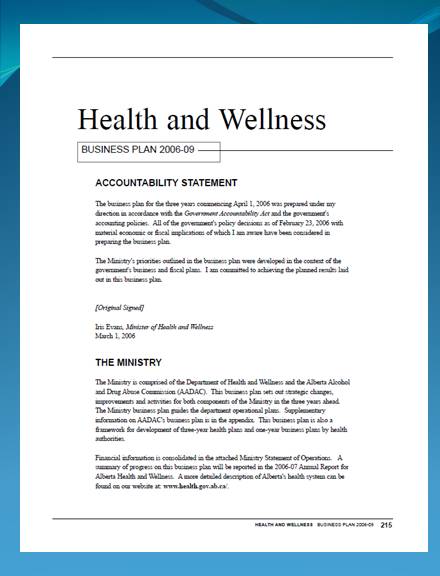
You can use this sample template to write a comprehensive business plan for a medical facility. Some of the highlights include identifying challenges and determining their respective opportunities. This gives you a clear understanding of the market that you would like to target so that you can align your medical services to their needs once you start operation.
Short Medical Business Plan Example

Size: 264 KB
If you are the kind of a medical business enthusiast who prefers to write a short business plan, this example is suitable for you. The content of the file includes an executive summary, market analysis, business growth, marketing strategy, and financial projection.

Text prompt
- Instructive
- Professional
Create a study plan for final exams in high school
Develop a project timeline for a middle school science fair.

Search Product category Any value Sample Label 1 Sample Label 2 Sample Label 3
How to Write a Business Plan for a Private Clinic: Complete Guide
- January 3, 2023

Whether you’re looking to raise funding from private investors or to get a loan from a bank (like a SBA loan) for your private clinic, you will need to prepare a solid business plan.
In this article we go through, step-by-step, all the different sections you need in the business plan of your private clinic.
Whether you want to open a primary care or a specialized clinic (e.g. plastic surgery, chiropractor or any other type of medical clinic), use this template to create a complete, clear and solid business plan that get you funded.
1. Executive Summary
The executive summary of a business plan gives a sneak peek of the information about your business plan to lenders and/or investors.
If the information you provide here is not concise, informative, and scannable, potential lenders and investors will lose interest.
Though the executive summary is the first and the most important section, it should normally be the last section you write because it will have the summary of different sections included in the entire plan.
Why do you need a business plan for a private clinic?
The purpose of a business plan is to secure funding through one of the following channels:
- Obtain bank financing or secure a loan from other lenders (such as a SBA loan )
- Obtain private investments from investment funds, angel investors, etc.
- Obtain a public or a private grant
How to write an executive summary for a private clinic?
Provide a precise and high-level summary of every section that you have included in the business plan of your construction business. The information and the data you include in this segment should grab the attention of potential investors and lenders immediately.
Also make sure that the executive summary doesn’t exceed 2 pages in total: it’s supposed to be a summary for investors and lenders who don’t have time to scroll through 40-50 pages, so keep it short and brief.
The executive summary usually consists of 5 major sub-sections:
- Business overview : describe your medical clinic, where it is located, and what type of inpatient or outpatient care you offer. Also, mention the services and treatments you specialize in and the average price per treatment
- Market analysis : a comprehensive market analysis includes details about your market. Provide information about your target audience (children vs. elderly, health conditions, outpatient care trends and preferences, etc.), as well as the market size , growth and competitors.
- People : introduce your construction business’ management and employee structure. Provide a brief (no more than a couple of sentences each) of the knowledge and experience of the team. Also, mention how the company will be structured (management roles and reporting lines)
- Financial plan: how much profit and revenue do you expect in the next 5 years? When will you reach the break-even point and start making profits? You can include here a chart with your key financials (revenue, gross profit, net profit )
- Funding ask : what loan/investment/grant are you seeking? How much do you need? How long will this last?
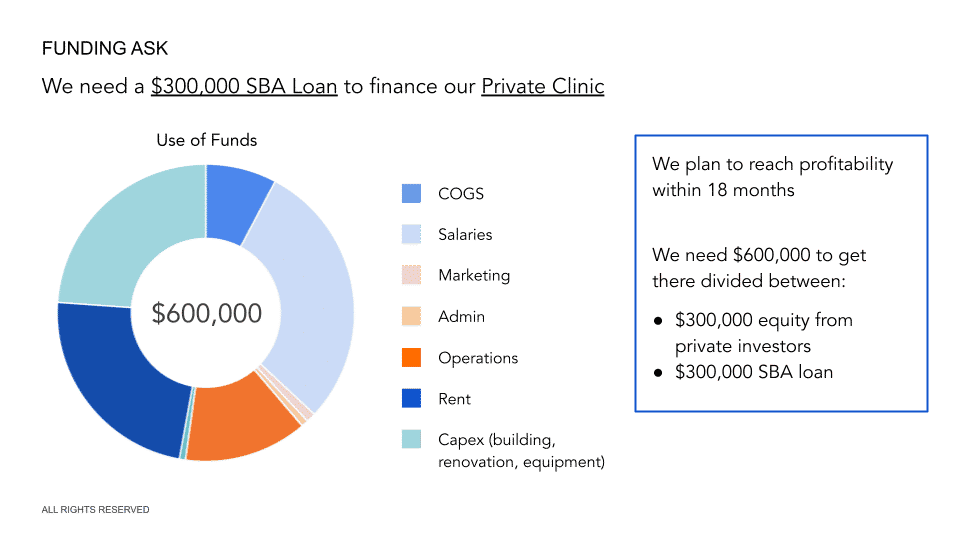
Medical Clinic Financial Model
Download an expert-built 5-year Excel financial model for your business plan
2. Medical Clinic Business Overview
In this section, you should explain in simple terms the type of clinic you wish to open. Here are a few questions you may want to answer:
- Where exactly is your medical clinic located? And why did you choose that location?
- What type of medical clinic are you opening (franchise vs. independent)?
- Are you opening a primary care or a specialized health clinic?
- Which medical services will you provide? For whom (what is your target audience)?
- What is the capacity of your private clinic? How many beds? How many doctors/specialists will there be?
- What will be the legal structure of your company (partnership, corporation)?
a) Rationale
Before we jump into the business, it’s always good practice to give an overview of the rationale behind this project. In other words: why did you decide to open such clinic in your area today?
For example, if there are no plastic surgery clinics in the area despite strong market demand, you could come in to fill the existing market gap after conducting a proper market analysis.
b) Business Concept
Now, it’s time to explain your business model. Firstly, business owners can choose between independent practices or franchising.
But that’s not all. You must also decide on the specific type of clinic you want to open. And that’s only possible after answering the following questions;
- Will you specialize in primary care or specialty medicine?
- Is this a franchise or an independent clinic?
- Is this a solo, group or hospital-owned practice?
What are the different types of medical clinics?
Here are a few business models commonly used by medical professionals:
- Solo practice : you will be the main partner of the clinic and have full control. A major pitfall of a solo practice is the high startup costs for leasing the property, purchasing the medical equipment, managing administrative functions and marketing your business
- Group practice : you partner with other physicians or practitioners instead. This business model comes with fewer responsibilities, with well-defined roles for every individual. Also, it provides easy access to capital, lowering the startup and operating costs along the way
- Hospital-owned practice : a medical clinic within the hospital premises. Here, you work with a fixed schedule, getting limited freedom compared to a solo practice. But the upside is that you can capitalize on the hospital’s resources, making it easier to establish your practice and market it to your target audience.

c) Treatments and Services
In addition to the business model of your clinic, let’s now take a look at the services and treatments you offer.
For example, a plastic surgery clinic with reconstructive procedures could offer the following treatments:
- Head/face/eyes (Facelift, forehead lift, eyelid lift, ear pinning, hair replacement surgery, nasal surgery, nose reshaping, etc.)
- Mouth and teeth (oral surgery)
- Breasts (Breast augmentation, breast reconstruction, breast reduction, breast lift)
- Abdomen (Liposuction, tummy tuck, etc.)
- Hand and upper limb
- Skin (Chemical peel, vein removal, scar revision, tattoo removal, dermaplaning, laser skin resurfacing)
d) Pricing Strategy
Lenders and investors will want to see your pricing strategy . We recommend you create a summary table with the main services you offer as well as their prices.
You can start by determining the average cost of similar medical services in your area before making your pricing list.
When creating your pricing structure, consider the necessary elements, like the local regulations and whether most consumers rely on insurance bodies to cover their medical expenses or fund them from their pockets.
e) Legal Structure
Finally, your business overview section should specify what type of business structure you want. Is this a corporation or a partnership (LLC)? Who are the investors? How much equity percentage do they own? Is there a Board of Directors? If so, whom? Do they have experience in the industry?

3. Medical Clinic Market Overview
One of the most important steps when writing a medical clinic’s business plan is understanding the market you’re in. Try to address here the following questions:
- Industry size & growth : how big is the industry in your area? What is its growth/decline rate, and what factors contribute to its growth/decline in the region?
- Competition overview : how many competitors are there? How do they compare vs. your business? How can you differentiate yourself from them?
- Customer analysis : who is your target market ? What type of inpatient and/or outpatient treatments do they need?
a) Medical Industry Size & Growth
The cosmetic surgery industry was worth $20.1 billion in 2022 (+2.3% CAGR from 2017-22).
In total, there were 22.4 million procedures in 2019: that’s an average price per procedure of around $900.
In terms of plastic surgeons, there were approximately 7,000 in the US in 2020 .
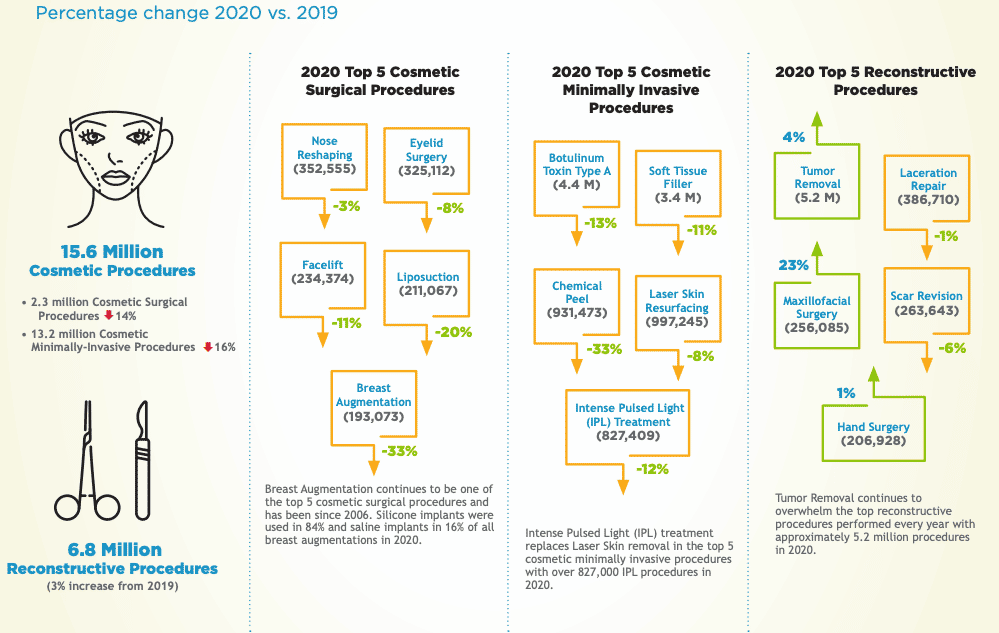
b) Competition Overview
In addition to an overview of the market size, you should also describe who are your competitors in the area where you plan to open your clinic.
Find useful information about your competitors’ biggest strengths and weaknesses , products and services , and marketing strategies.
For example, create a summary table that compares your competitors’ treatments, marketing strategies, pricing ranges, target audience, etc.
c) Customer Analysis
Finally, take some time to understand your target audience. Here are a few elements you must look into:
- What is the average spend per capita on medical procedures (for example plastic surgery)?
- How often do people need such treatments?
- The most sought-after treatments
- What’s the average price of a treatment / service?

4. Sales & Marketing
The next section of your medical clinic’s business plan should outline your customer acquisition strategy. Start by answering the following questions:
- What are the different marketing strategies you will use?
- What are your unique selling points (USPs)?
- How will you track the success of your marketing strategy ?
- What is your customer acquisition cost (CAC)?
- What is your marketing budget?
- Will you consider any offers or promotions to attract new clients?
What marketing channels do private clinics use?
A few marketing channels used by clinics include;
- Content marketing on social media and blogs
- Email, SMS marketing
- Online local listing (Google Business)
- Word-of-mouth advertisement, recommendations
- PPC ads, Facebook ads, etc.
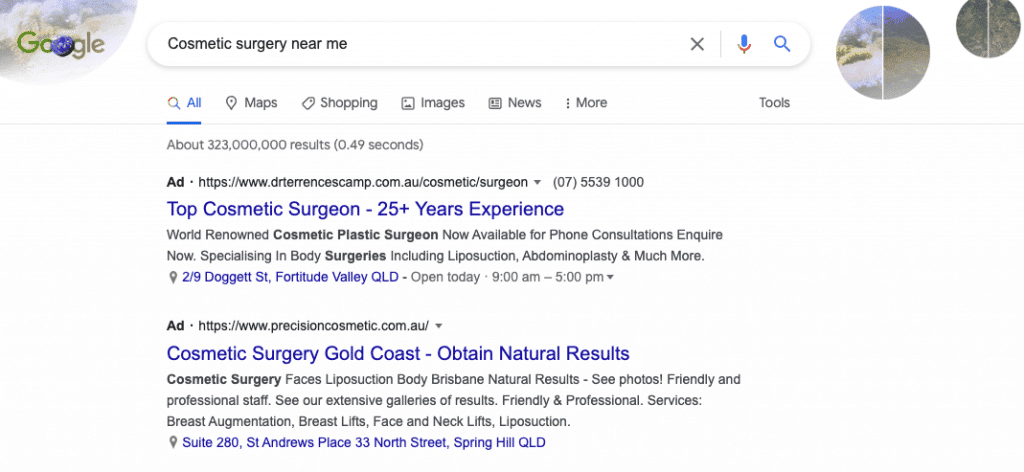
5. Management & People
You must address two things here:
- The management team and their experience / track record
- The organizational structure : different team members and who reports to whom?
Small businesses often fail because of managerial weaknesses. Thus, having a strong management team is vital. Highlight the experience and education of senior managers that you intend to hire to oversee your private clinic.
For the partners of the clinic, describe their duties, responsibilities, and roles. Also, highlight their previous experience and track record.
For the receptionists, personal assistants, office managers, medical assistants, etc. no need to go into a lot of detail, especially as it’s likely you won’t have hired them yet before you get the funding you need, which is the objective of this business plan.
Organization Structure
Even if you haven’t already hired anyone yet, you must provide a chart of the organizational structure defining the hierarchy of reporting.
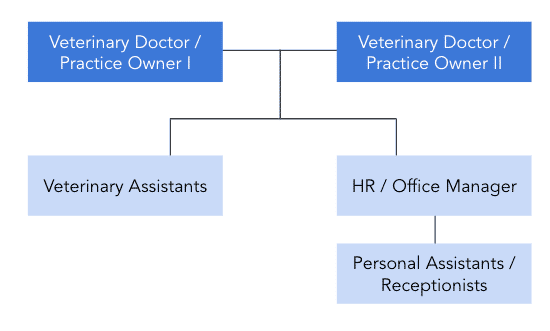
6. Financial Plan
The financial plan is perhaps, with the executive summary, the most important section of any business plan for a private clinic.
Indeed, a solid financial plan tells lenders that your business is viable and can repay the loan you need from them. If you’re looking to raise equity from private investors, a solid financial plan will prove them your private clinic is an attractive investment.
There should be 2 sections to your financial plan section:
- The startup costs of your private clinic
- The 5-year financial projections
a) Startup Costs
Before we expand on 5-year financial projections in the following section, it’s always best practice to start with listing the startup costs of your project. For a private clinic, startup costs are all the expenses you incur before you open your clinic.
These expenses typically are: the lease for the space, the renovation costs, the equipment and furniture.
Logically, the startup costs vary depending on the size of your clinic, the treatments you will offer (and therefore the equipment you need), the quality of the equipment and furniture, whether you buy the real estate or rent a commercial space, etc.
b) Financial Projections
In addition to startup costs, you will now need to build a solid 5-year financial model for your private clinic. Your financial projections should be built using a spreadsheet (e.g. Excel or Google Sheets) and presented in the form of tables and charts.
As usual, keep it concise here and save details (for example detailed financial statements, financial metrics, key assumptions used for the projections) for the appendix instead.
Your financial projections should answer at least the following questions:
- How much revenue do you expect to generate over the next 5 years?
- When do you expect to break even?
- How much cash will you burn until you get there?
- What’s the impact of a change in pricing (say 15%) on your margins?
- What is your average customer acquisition cost?
You should include here your 3 financial statements (income statement, balance sheet and cash flow statement). This means you must forecast:
- The number of patients you can receive in a day or week;
- The number of procedures you can perform ;
- Your expected revenue ;
- Operating costs to run the business ;
- Any other cash flow items (e.g. capex, debt repayment, etc.).
When projecting your revenue, make sure to sensitize pricing (prices of treatments and services) and your sales volume (number of customers). Indeed, a small change in these assumptions may have a significant impact on your revenues and profits.

7. Use of Funds
This is the last section of the business plan of your private clinic. Now that we have explained what your private clinic’s business model and services are, your marketing strategy, etc., this section must now answer the following questions:
- How much funding do you need?
- What financial instrument(s) do you need: is this equity or debt, or even a free-money public grant?
- How long will this funding last?
- Where else does the money come from? If you apply for a SBA loan for example, where does the other part of the investment come from (your own capital, private investors?)
If you raise debt:
- What percentage of the total funding the loan represents?
- What is the corresponding Debt Service Coverage Ratio ?
If you raise equity
- What percentage ownership are you selling as part of this funding round?
- What is the corresponding valuation of your business?
Use of Funds
Any private clinic business plan should include a clear use of funds section. This is where you explain how the money will be spent.
Will you spend most of the loan / investment in paying your employees’ salaries? Or will it cover mostly the cost for the lease deposit for the space, the renovation and equipment?
For the use of funds, we also recommend using a pie chart like the one we have in our financial model template where we outline the main expenses categories as shown below.
Privacy Overview

Mobile Medical Clinic Business Plan [Sample Template]
By: Author Tony Martins Ajaero
Home » Business Plans » Medical and Healthcare » Hospital & Clinic
Do you want to start a mobile health clinic? If YES, here is a detailed sample mobile medical clinic business plan template & FREE feasibility report.
As a medical doctor or a player in the healthcare industry, if you are interested in starting a business in the industry and you don’t have the financial requirements to start a standard hospital, then you should opt for a mobile medical clinic.
It is important to note that any healthcare related business requires that you first look at the existing laws in the country or the state you reside, before starting the business. Any healthcare related business is usually highly regulated so as to guard against the infiltration of quacks or substandard health facilities.
You would need to pay a visit to the health and medical regulatory body in your country (the department / ministry of health and medical services) to get all the needed information.
A Sample Mobile Medical Clinic Business Plan Template
1. industry overview.
A mobile hospital is a medical center or a small hospital with full and functional medical equipment that can be moved and settled in a new place swiftly as the situation demands. So, it can provide medical services to patients in critical conditions such as war or natural disasters.
A mobile hospital is bigger than first aid units and smaller than a permanent hospital. It is a modular, in that unit that every part of it is on the wheel, so it can be moved to another place easily, although all the required space and necessary equipment are considered so it can be utilized in the minimum time.
Since mobile hospitals provide most of the medical equipment on wheels through the roads, it needs a special platform. Base platform of a mobile hospital can be a rear box of a truck or the box of a semi-trailer.
Mobile medical clinic is a subset of the Emergency and Other Outpatient Care Centers industry and this industry includes establishments with medical staff primarily engaged in providing emergency, general or specialized outpatient care not included in other industries.
This industry also includes centers or clinics with a variety of health practitioners, each with different specializations and operating in different industries, who practice in the same establishment. A recent report published by IBISWorld estimates that industry revenue grew at an annual rate of 5.4 percent over the five years to 2010 to $83.9 billion.
The industry includes several types of healthcare facilities; however, the major segments are kidney dialysis providers and ambulatory surgical centers (ASCs).
The industry continued to grow during the recession due to the fact that most of the economy-related factors that drive lower healthcare spending incorporate a lag. For example, in anticipation of losing their jobs, many consumers took advantage of their health insurance while they had it.
Further fostering industry growth have been the demographics of the patient population, the high value of quality care and the necessary nature of many industry services. The dialysis patient population, in particular, has been increasing in the past five years, driven by the aging US population, higher incidence rates of diabetes and improved life expectancy for dialysis patients.
The Emergency and Other Outpatient Care Centers industry is indeed a very massive industry in the U.S. Statistics has it that in the united states of America, the industry is worth $127 billion, with an estimated growth rate of 3.3 percent between 2015 and 2022.
There are about 50,039 registered and licensed emergency and other outpatient care centers in the United States and they are responsible for employing about 858,493 people that comprises of doctors, nurses, pharmacists, dentist, opticians, surgeons and other health and non – health workers.
It is important to state that Fresenius Medical Care AG & Co. KGaA and DaVita HealthCare Partners Inc. are the only establishments with the lion shares of the available market in the United States. If you are considering starting your own mobile medical clinic and practice business in the United States, then you should try and work around the industry barriers.
The truth is that, the barriers to entry in the Emergency and Other Outpatient Care Centers industry are high due to the significant regulatory requirements and the experience and strength of incumbents. For example, medical licensure creates a barrier to entry in the healthcare sector.
As a matter of fact, it is absolutely compulsory for any investor who is looking towards starting a any medical clinic to meet extensive federal, state and local laws and regulations. These regulations relate to the adequacy of medical care, equipment, personnel, operating policies and procedures.
Regulations also involve maintaining adequate records, preventing fires, setting rates and complying with building codes and environmental protection laws. These regulations make it difficult and costly for aspiring entrepreneurs to enter the industry.
2. Executive Summary
Life First® Mobile Medical Clinic, LLC is a standard, licensed and government approved healthcare services provider that will be located in the heart of Los Angeles, California – United States of America but move all across different cities and locations in the state.
We have been able to acquire a standard and well – equipped trailer that is suitable for the kind of mobile medical clinic we want to operate.
Life First® Mobile Medical Clinic, LLC is in the Emergency and Other Outpatient Care Centers industry to provide healthcare services such as Health Maintenance Organization (HMO) medical care, kidney dialysis, ambulatory surgical and emergency care, biofeedback treatment, infusion therapy, pain therapy, sleep disorder treatment, community health and other medical services and practice.
We are well trained and equipped to service the market segments that require the healthcare services we will be offering. We are in the medical clinic industry to deliver excellent healthcare services.
We will also ensure that in the line of carrying out our duty, we comply with the laws and health regulations in California and the United States of America. Our employees are well trained and qualified to handle the wide range of healthcare services.
Life First® Mobile Medical Clinic, LLC will operate 24 hours 7 days a week mobile medical clinic; our mobile medical clinic will be opened round the clock to attend to patients wherever we are located per time. We have a standard medical call center that is manned by trained health workers.
Our employees are going to be well trained to operate within the framework of our organization’s corporate culture and also to meet the needs of all our customers.
Life First® Mobile Medical Clinic, LLC will ensure that all our patients are given first class treatment whenever they visit our mobile medical clinic. We have a CRM software that will enable us manage a one on one relationship with our customers no matter how large the number of our customer base grow.
Life First® Mobile Medical Clinic, LLC is owned and managed by Dr. Borger Jasper. Dr. Borger Jasper is going to be the Medical Director (Chief Executive Officer) of the mobile medical clinic, he is a qualified and well trained Medical Doctor with over 15 years’ experience working as a medical doctor and medical researcher with the United States’ government.
3. Our Products and Services
Life First® Mobile Medical Clinic, LLC is in the mobile medical clinic business to bring healthcare services closer to the people and our services will be carried out by highly trained professional doctors, dentist, opticians, nurses, nurse’s aides, mental health counselors, chiropractors, medication management counselors, physical therapists and other health and non – health workers, who know what it takes to give our highly esteemed patients value for their money.
These are the healthcare services that Life First® Mobile Medical Clinic, LLC will be offering;
- Health Maintenance Organization (HMO) medical care
- Kidney dialysis
- Ambulatory surgical and emergency care
- Biofeedback treatment
- Infusion therapy
- Pain therapy
- Sleep disorder treatment
- Community health
- Personal Injury Case Management
4. Our Mission and Vision Statement
- Our vision is to become the number one choice when it comes to mobile healthcare service delivery in the whole of California and also to be amongst the top 10 mobile medical clinics in the United States of America within the next 10 years.
- Life First® Mobile Medical Clinic, LLC is in business to establish a first – class mobile medical clinic that will move from one location to another in order to take care of both highly placed clients and lowly placed clients as long as they can afford our services.
- We want to become one of the leaders in the Emergency and Other Outpatient Care Centers industry in California, and in The United States of America.
Our Business Structure
Life First® Mobile Medical Clinic, LLC is a business that will be built on a solid foundation. From the outset, we have decided to recruit only qualified professionals to man various job positions in our organization. We are quite aware of the rules and regulations governing the emergency and other outpatient care industry which is why we decided to recruit only well experienced and qualified employees.
We hope to leverage on their expertise to build our mobile medical clinic brand to be well accepted in California and the whole of the United States. When hiring, we will look out for applicants that are not just qualified and experienced, but honest, customer centric and are ready to work to help us build a prosperous business that will benefit all our stakeholders.
As a matter of fact, profit-sharing arrangement will be made available to all our management staff and it will be based on their performance for a period of five years or more. These are the positions that will be available at Life First® Mobile Medical Clinic, LLC;
- Chief Medical Director/Chief Executive Officer
- Doctor/Surgeon/Dentist
- Nurses/Nurse’s Aides
- Information Technologist (Contract)
- Admin and Human Resources Manager
- Sales and Marketing Executive
- Accountant / Cashier
- Client Service Executive / Call Center Agents
5. Job Roles and Responsibilities
Chief Medical Director/Chief Executive Officer:
- Responsible for providing direction for the business
- Creating, communicating, and implementing the organization’s vision, mission, and overall direction – i.e. leading the development and implementation of the overall organization’s strategy.
- Attend to high profile clients and severe medical cases
- Responsible for fixing prices and signing business deals
- Responsible for recruitment
- Responsible for payment of salaries
- Responsible for signing checks and documents on behalf of the company
- Evaluates the success of the organization
- Responsible for providing professional medical services to our patients
- Responsible for offering occupational, physical, and speech therapy
- Responsible for handling medical emergencies.
Pharmacist:
- Responsible for recruiting, training and managing staff
- Responsible for processing prescriptions and dispensing medication
- Responsible for ordering, selling and controlling medicines and other stock
- Handle any other duty as assigned by the Medical Director.
Nurses / Nurse’s Aides
- Responsible for managing our patients
- Handles personal injury case management
- Responsible for offering medication management services
- Assist the doctors in treating patients
Accountant/Cashier:
- Responsible for preparing financial reports, budgets, and financial statements for the organization
- Provides managements with financial analyses, development budgets, and accounting reports
- Responsible for financial forecasting and risks analysis.
- Performs cash management, general ledger accounting, and financial reporting for one or more properties.
- Responsible for developing and managing financial systems and policies
- Responsible for administering payrolls
- Ensuring compliance with taxation legislation
- Handles all financial transactions for Life First® Mobile Medical Clinic, LLC
- Serves as internal auditor for Life First® Mobile Medical Clinic, LLC.
Client Service Executive/Call Center Agent
- Welcomes clients and potential clients by greeting them in person or on the telephone; answering or directing inquiries.
- Ensures that all contacts with clients (e-mail, walk-In center, SMS or phone) provides the client with a personalized customer service experience of the highest level
- Through interaction with clients on the phone, uses every opportunity to build client’s interest in the company’s products and services
- Manages administrative duties assigned by the creative director in an effective and timely manner
- Consistently stays abreast of any new information on the organizations’ products, promotional campaigns etc. to ensure accurate and helpful information is supplied to clients when they make enquiries
- Responsible for cleaning the mobile medical clinic facility at all times
- Ensure that toiletries and supplies don’t run out of stock
- Handle any other duty as assigned by the admin and HR manager.
- Responsible for driving the mobile medical facility from one location to another
- Ensures that every part of the trailer is functional, well – maintained and serviced so as to facilitate easy movement in case of emergency
- Handle any other duty as assigned by the admin and HR manager
6. SWOT Analysis
Life First® Mobile Medical Clinic, LLC is set to become one of the leading mobile medical cum healthcare service providers in California which is why we are willing to take our time to cross every ‘Ts’ and dot every ‘Is’ as it relates to our business.
We want our mobile medical clinic to be the number one choice of all residents of Los Angeles and other cities in California. We know that if we are going to achieve the goals that we have set for our business, then we must ensure that we build our business on a solid foundation.
Even though our Chief Medical Director (owner) has a robust experience in health management services, we still went ahead to hire the services of business consultants that are specialized in setting up new businesses to help our organization conduct detailed SWOT analysis and to also provide professional support in helping us structure our business to indeed become a leader in the Emergency and Other Outpatient Care Centers industry.
This is the summary of the SWOT analysis that was conducted for Life First® Mobile Medical Clinic, LLC;
Our strength lies in the fact that we have a team of well qualified healthcare professionals manning various job positions in our mobile medical clinic. As a matter of fact, they are some of the best hands in the whole of Los Angeles, California.
Our well branded mobile medical clinic, the Business model we will be operating on, multiple payment options, well equipped medical call center and our excellent customer service culture will definitely count as a strong strength for us.
Our perceived weakness lies in the point that we are just starting out and we may not have the required finance to sustain the kind of publicity that we intend giving the business and also the finance needed for the acquiring some of the latest medical and surgical equipment et al.
- Opportunities:
The opportunities that are available to mobile medical clinics are unlimited considering the fact they have the capacity to move from one location to another within short notice. Aside from that, the fact that adults aged 65 and older tend to be major users of healthcare services due to the increased prevalence of diseases among this age group.
Therefore, growth in this demographic has a positive influence on industry demand. The number of adults aged 65 and older is expected to increase in 2023, representing a potential opportunity for the industry.
People covered by private health insurance are more likely to use industry services frequently. Therefore, the extent to which the US population is covered by private health insurance affects demand for healthcare services. An estimated 36.6 percent of industry revenue comes from private insurance.
The number of people with private health insurance is expected to decrease in 2023, posing a potential threat to the industry.
7. MARKET ANALYSIS
- Market Trends
Mobile medical clinics historically began as offshoots of the emergency room, but now they provide a broader range of care.
Every year, some 20 million surgical procedures take place at ASCs across the country. The fact that physician-entrepreneurs have grown single ASCs into formidable facilities or formed joint ventures with hospitals has raised their profile in the healthcare sector.
Reasons for their continued growth are numerous. As the population becomes more mobile, people are less committed to a particular physician. Additionally, the US culture increasingly values convenience in healthcare, as in other services, and the public feels ever more confident in choosing healthcare providers.
Finally, modern physicians, who are valuing their own leisure time more highly, have been seeking ways to meet their patients’ needs without having to be on-call all the time. The emergency and other outpatient care centers industry is indeed a thriving and dynamic industry; with the aid of technology, it is becoming easier to treat, manage and cure some ailments.
As an investor in the emergency and other outpatient care centers industry, in order to maintain an advantaged position in this competitive industry, you should source for the most skilled and specialized healthcare professionals and perhaps merge with standard hospitals.
One thing about this industry is that labor costs is on the high side. However, medical clinics have also faced nurse and physician shortages and have struggled to recruit qualified personnel. Industry profitability has generally risen over the past five years due to increases in service prices.
No doubt the home healthcare industry will continue to grow and become more profitable because the aging baby-boomer generation in United States are expected to drive increasing demand for healthcare services.
8. Our Target Market
Life First® Mobile Medical Clinic, LLC is in business to service a wide range of customers in Los Angeles, California – United States of America and other cities such as San Diego, Sacramento, San Jose, Claremont, Thousand Oaks, San Marino, Palm Springs, and Sierra Madre et al.
We will ensure that we target both self – pay customers (who do not have health insurance cover), and those who have health insurance cover. Generally, every living person, whether old or young will at one point or the order need to visit the medical clinic.
The fact that we are going to open our doors to a wide range of customers does not in any way stop us from abiding by the rules and regulations governing the emergency and other outpatient care centers industry in the United States. Our staff are well – trained to effectively service our customers and give them value for their monies. Our customers can be categorized into the following;
- The whole residents within the area where our mobile medical clinic will be located per time
- Expectant Mothers
- Injured Sports Men and Women
- Public facilities
Our Competitive Advantage
Aside from the competitions that exist amongst various mobile medical clinics, they also compete against other healthcare services providers such as home healthcare service providers, health centers and standard hospitals et al.
To be highly competitive in the industry means that you should be able to deliver consistent quality patient service and should be able to meet the expectations of your patients at all time; they should experience improvement in their health when they patronize your mobile medical clinic.
Life First® Mobile Medical Clinic, LLC is coming into the market prepared to favorably compete in the industry. Our mobile medical clinic facility will always be settled in a familiar, easily accessible place and will placed next to a relatively tall or well-known landmark (such as a school or shopping mall, etc.) so patients and locals may locate it without much trouble.
Our staff are well groomed in all aspect of healthcare service delivery and all our employees are trained to provide customized customer service to all our patients. Our services will be carried out by highly trained professionals who know what it takes to give our highly esteemed customers value for their money.
We are going to be one of the few mobile medical clinics cum healthcare service providers in the whole of California that will run a standard medical call center for 24 hours a day and 7 days a week. We have enough trained health workers that are ready to run a shift system.
Lastly, all our employees will be well taken care of, and their welfare package will be among the best within our category in the industry. It will enable them to be more than willing to build the business with us and help deliver our set goals and objectives.
9. SALES AND MARKETING STRATEGY
- Sources of Income
Life First® Mobile Medical Clinic, LLC will ensure that we do all we can to maximize the business by generating income from every legal means within the industry. Below are the sources we intend exploring to generate income for Life First® Mobile Medical Clinic, LLC;
10. Sales Forecast
It is important to state that our sales forecast is based on the data gathered during our feasibility studies, market survey and also some of the assumptions readily available on the field. We have been able to examine the mobile medical clinic market, we have analyzed our chances in the industry and we have been able to come up with the following sales forecast.
Below is the sales projection for Life First® Mobile Medical Clinic, LLC it is based on the location of our medical clinic and of course the wide range of our services and target market;
- First Year (FY1): $100,000 (From Self – Pay Clients / Patients): $250,000 (From Health Insurance Companies)
- Second Year (FY2): $250,000 (From Self – Pay Clients / Patients): $500,000 (From Health Insurance Companies)
- Third Year (FY3): $500,000 (From Self – Pay Clients / Patients): $1,500,000 (From Health Insurance Companies)
N.B: This projection was done based on what is obtainable in the industry and with the assumption that there won’t be any major economic meltdown and natural disasters within the period stated above. Please note that the above projection might be lower and at the same time it might be higher.
- Marketing Strategy and Sales Strategy
The marketing and sales strategy of Life First® Mobile Medical Clinic, LLC will be based on generating long-term personalized relationships with customers. In order to achieve that, we will ensure that we offer all – round healthcare services at affordable prices compared to what is obtainable in California.
All our employees will be well trained and equipped to provide excellent and knowledgeable healthcare services and customer service.
We know that if we are consistent with offering high quality healthcare service delivery and excellent customer service, we will increase the number of our customers by more than 25 percent for the first year and then more than 40 percent subsequently.
Before choosing a location for our mobile medical clinic, we conducted a thorough market survey and feasibility studies in order for us to be able to penetrate the available market and become the preferred choice for residents of Los Angeles, California – United States of America and other cities such as San Diego, Sacramento, San Jose, Claremont, Thousand Oaks, San Marino, Palm Springs, and Sierra Madre et al where our services will be available.
We have detailed information and data that we were able to utilize to structure our business to attract the number of customers we want to attract per time.
We hired experts who have good understanding of the emergency and other outpatient care centers industry to help us develop marketing strategies that will help us achieve our business goal of winning a larger percentage of the available market in California.
In summary, Life First® Mobile Medical Clinic, LLC Services will adopt the following sales and marketing approach to win customers over;
- Introduce our medical clinic by sending introductory letters to residence, public facility managers, schools, business owners and corporate organizations all across California
- Advertise our medical clinic and practice in community based newspapers, local TV and radio stations
- List our mobile medical clinic and practice on yellow pages ads (local directories)
- Leverage on the internet to promote our mobile medical clinic and practice
- Engage in direct marketing
- Leverage on word of mouth marketing (referrals)
- Enter into business partnership with health management organizations, public facility managers, schools, government agencies and health insurance companies.
- Attend healthcare related exhibitions / expos with the aim of networking and marketing our medical clinic and practice business.
11. Publicity and Advertising Strategy
We are in the mobile medical clinic business -to become one of the market leaders and also to maximize profits hence we are going to explore all available means to promote our mobile medical clinic.
Life First® Mobile Medical Clinic, LLC has a long – term plan of opening of mobile medical clinics in key cities around the United States of America which is why we will deliberately build our brand to be well accepted in Los Angeles before venturing out. Here are the platforms we intend leveraging on to promote and advertise Life First® Mobile Medical Clinic, LLC;
- Place adverts on both print (community based newspapers and magazines) and electronic media platforms
- Sponsor relevant community health programs
- Leverage on the internet and social media platforms like; Instagram, Facebook, twitter, YouTube, Google + et al to promote our brand
- Install our Billbboards in strategic locations all around California.
- Distribute our fliers and handbills in target areas
- Ensure that all our workers wear our branded shirts and all our trailers, vehicles and ambulances are well branded with our company’s logo et al
12. Our Pricing Strategy
Life First® Mobile Medical Clinic, LLC will work towards ensuring that all our services are offered at highly competitive prices compared to what is obtainable in The United States of America.
On the average, hospitals and healthcare service providers usually leverage on the fact that a good number of their clients do not pay the service charge from their pockets; private insurance companies, Medicare and Medicaid are responsible for the payment.
In view of that, it is easier for hospitals and healthcare service providers to bill their clients based in their discretion. However, in some cases hospitals and healthcare service providers also adopt the hourly billing cum per visit billing method.
For example, it is easier and preferable for mobile medical clinic and healthcare services providers to bill personal injury case management services by the hour as against a fixed price.
- Payment Options
The payment policy adopted by Life First® Mobile Medical Clinic, LLC is all inclusive because we are quite aware that different customers prefer different payment options as it suits them but at the same time, we will ensure that we abide by the financial rules and regulation of the United States of America. Here are the payment options that Life First® Mobile Medical Clinic, LLC will make available to her clients;
- Payment via bank transfer
- Payment with cash
- Payment via credit cards
- Payment via online bank transfer
- Payment via check
- Payment via mobile money transfer
- Payment via bank draft
In view of the above, we have chosen banking platforms that will enable our client make payment for our services without any stress on their part. Our bank account numbers will be made available on our website and promotional materials.
13. Startup Expenditure (Budget)
If you are looking towards starting a mobile medical clinic, then you should be ready to ensure that you raise enough capital to cover some of the basic expenditures that you are going to incur. The truth is that starting this type of business does not come cheap.
You would need money to secure a standard mobile medical clinic / trailer, you will need money to acquire medical equipment and supply and also pay your workforce and bills for a while until the revenue you generate from the business becomes enough to pay them.
Besides it is expensive to acquire a standard well – equipped ambulance. The items listed below are the basics that we would need when starting our medical clinic in the United States, although costs might vary slightly;
- The total fee for registering the Business in the United States – $750.
- Legal expenses for obtaining licenses and permits – $1,500.
- Marketing promotion expenses for the grand opening of Life First® Mobile Medical Clinic, LLC in the amount of $3,500 and as well as flyer printing (2,000 flyers at $0.04 per copy) for the total amount of – $3,580.
- Cost for hiring Business Consultant – $2,500.
- Cost for computer software (Accounting Software, Payroll Software, CRM Software, Microsoft Office, QuickBooks Pro, drug interaction software, Physician Desk Reference software) – $7,000
- Insurance (general liability, workers’ compensation and property casualty) coverage at a total premium – $3,400.
- The cost for acquiring a mobile clinic/trailer – $105,600.
- The cost for mobile clinic remodeling (construction of racks and shelves) – $20,000.
- Other start-up expenses including stationery ($500) and phone and utility deposits – ($2,500).
- The operational cost for the first 3 months (salaries of employees, payments of bills et al) – $500,000
- The cost for Start-up inventory (stocking with a wide range of drugs and related medical supplies ) – $150,000
- Storage hardware (bins, rack, shelves,) – $10,720
- The cost for Nurse and Drugs Supplies (Injections, Bandages, Scissors, et al) – $3,000
- The cost for medical equipment – $400,000
- The cost of purchase of ambulance and other vehicles – $100,000
- The cost for the purchase of furniture and gadgets (Computers, Printers, Telephone, TVs, tables and chairs et al) – $4,000.
- The cost of launching a website – $700
- Miscellaneous – $10,000
We would need an estimate of $1.2 million to successfully set up our mobile medical clinic and practice business in Los Angeles – California.
Generating Funds/Startup Capital for Life First® Mobile Medical Clinic, LLC
Life First® Mobile Medical Clinic, LLC is a private business that will be owned and managed by Dr. Borger Jasper Jnr. He decided to restrict the sourcing of the startup capital for the business to just three major sources.
- Generate part of the startup capital from personal savings
- Source for soft loans from family members and friends
- Apply for loan from my Bank
N.B: We have been able to generate about $500,000 (Personal savings $300,000 and soft loan from family members $200,000) and we are at the final stages of obtaining a loan facility of $700,000 from our bank. All the papers and documents have been duly signed and submitted, the loan has been approved and any moment from now our account will be credited.
14. Sustainability and Expansion Strategy
The future of a business lies in the number of loyal customers that they have, the capacity and competence of their employees, their investment strategy and the business structure. If all of these factors are missing from a business, then it won’t be too long before the business closes shop.
One of our major goals of starting Life First® Mobile Medical Clinic, LLC is to build a business that will survive off its own cash flow without the need for injecting finance from external sources once the business is officially running.
We know that one of the ways of gaining approval and winning customers over is to offer our healthcare services a little bit cheaper than what is obtainable in the market and we are well prepared to survive on lower profit margin for a while. Life First® Mobile Medical Clinic, LLC will make sure that the right foundation, structures and processes are put in place to ensure that our staff welfare are well taken of.
Our organizations’ corporate culture is designed to drive our business to greater heights and training and retraining of our workforce is at the top burner. We know that if that is put in place, we will be able to successfully hire and retain the best hands we can get in the industry; they will be more committed to help us build the business of our dreams.
Check List/Milestone
- Business Name Availability Check : Completed
- Business Registration: Completed
- Opening of Corporate Bank Accounts: Completed
- Securing Point of Sales (POS) Machines: Completed
- Opening Mobile Money Accounts: Completed
- Opening Online Payment Platforms: Completed
- Application and Obtaining Tax Payer’s ID: In Progress
- Application for business license and permit: Completed
- Purchase of Insurance for the Business: Completed
- Acquiring a mobile clinic / trailer and remodeling the trailer: In Progress
- Conducting Feasibility Studies: Completed
- Generating capital from family members: Completed
- Applications for loan from the bank: In Progress
- Writing of Business Plan: Completed
- Drafting of Employee’s Handbook: Completed
- Drafting of Contract Documents and other relevant Legal Documents: In Progress
- Design of The Company’s Logo: Completed
- Printing of Promotional Materials: In Progress
- Recruitment of employees: In Progress
- Purchase of Medical Equipment and Ambulances et al: In Progress
- Purchase of the needed furniture, racks, shelves, computers, electronic appliances, office appliances and CCTV: In progress
- Creating Official Website for the Company: In Progress
- Creating Awareness for the business both online and around the community: In Progress
- Health and Safety and Fire Safety Arrangement (License): Secured
- Compilation of our list of products that will be available in our pharmacy store: Completed
- Establishing business relationship with Private medical insurance companies, Medicare and Medicaid, vendors (wholesale pharmaceutical companies): In Progress.
Related Posts:
- Adult Daycare Business Plan [Sample Template]
- Dental Clinic Business Plan [Sample Template]
- Orthopedic Clinic Business Plan [Sample Template]
- Heart Failure Clinic Business Plan [Sample Template]
- Aesthetic Clinic Business Plan [Sample Template]
Medical Supplies Business Plan Template & Guidebook
Starting a medical supplies business is an excellent way to serve a growing segment of the health industry and become your own boss in the process. With the #1 Medical Supplies Business Plan Template & Guidebook, you can create a step-by-step plan to help you launch and grow your business. From researching the market to setting goals and objectives and finding the right legal structure, this guidebook takes you through every step of the journey so that you can become a success in medical supplies.

Get worry-free services and support to launch your business starting at $0 plus state fees.
- How to Start a Profitable Medical Supplies Business [11 Steps]
- 10+ Best & Profitable Medical Supplies Business Ideas [2023]
How to Write a Medical Supplies Business Plan in 7 Steps:
1. describe the purpose of your medical supplies business..
The first step to writing your business plan is to describe the purpose of your medical supplies business. This includes describing why you are starting this type of business, and what problems it will solve for customers. This is a quick way to get your mind thinking about the customers’ problems. It also helps you identify what makes your business different from others in its industry.
It also helps to include a vision statement so that readers can understand what type of company you want to build.
Here is an example of a purpose mission statement for a medical supplies business:
Our mission is to provide effective, reliable, and affordable medical supplies and services to both individuals and organizations, empowering them to confidently manage their own health and wellness. By delivering high-quality products and services, we strive to improve the quality of life of our customers.

2. Products & Services Offered by Your Medical Supplies Business.
The next step is to outline your products and services for your medical supplies business.
When you think about the products and services that you offer, it's helpful to ask yourself the following questions:
- What is my business?
- What are the products and/or services that I offer?
- Why am I offering these particular products and/or services?
- How do I differentiate myself from competitors with similar offerings?
- How will I market my products and services?
You may want to do a comparison of your business plan against those of other competitors in the area, or even with online reviews. This way, you can find out what people like about them and what they don’t like, so that you can either improve upon their offerings or avoid doing so altogether.

3. Build a Creative Marketing Stratgey.
If you don't have a marketing plan for your medical supplies business, it's time to write one. Your marketing plan should be part of your business plan and be a roadmap to your goals.
A good marketing plan for your medical supplies business includes the following elements:
Target market
- Who is your target market?
- What do these customers have in common?
- How many of them are there?
- How can you best reach them with your message or product?
Customer base
- Who are your current customers?
- Where did they come from (i.e., referrals)?
- How can their experience with your medical supplies business help make them repeat customers, consumers, visitors, subscribers, or advocates for other people in their network or industry who might also benefit from using this service, product, or brand?
Product or service description
- How does it work, what features does it have, and what are its benefits?
- Can anyone use this product or service regardless of age or gender?
- Can anyone visually see themselves using this product or service?
- How will they feel when they do so? If so, how long will the feeling last after purchasing (or trying) the product/service for the first time?
Competitive analysis
- Which companies are competing with yours today (and why)?
- Which ones may enter into competition with yours tomorrow if they find out about it now through word-of-mouth advertising; social media networks; friends' recommendations; etc.)
- What specific advantages does each competitor offer over yours currently?
Marketing channels
- Which marketing channel do you intend to leverage to attract new customers?
- What is your estimated marketing budget needed?
- What is the projected cost to acquire a new customer?
- How many of your customers do you instead will return?
Form an LLC in your state!

4. Write Your Operational Plan.
Next, you'll need to build your operational plan. This section describes the type of business you'll be running, and includes the steps involved in your operations.
In it, you should list:
- The equipment and facilities needed
- Who will be involved in the business (employees, contractors)
- Financial requirements for each step
- Milestones & KPIs
- Location of your business
- Zoning & permits required for the business
What equipment, supplies, or permits are needed to run a medical supplies business?
- Business license
- Medical Supplies
- Computers and other office equipment
- Business insurance
- Employee payroll software
- Point-of-sale system for tracking orders and inventory levels
- Accounting software to manage accounts receivable, accounts payable and payroll
- Certifications or other credentials required to operate a medical supplies business
5. Management & Organization of Your Medical Supplies Business.
The second part of your medical supplies business plan is to develop a management and organization section.
This section will cover all of the following:
- How many employees you need in order to run your medical supplies business. This should include the roles they will play (for example, one person may be responsible for managing administrative duties while another might be in charge of customer service).
- The structure of your management team. The higher-ups like yourself should be able to delegate tasks through lower-level managers who are directly responsible for their given department (inventory and sales, etc.).
- How you’re going to make sure that everyone on board is doing their job well. You’ll want check-ins with employees regularly so they have time to ask questions or voice concerns if needed; this also gives you time to offer support where necessary while staying informed on how things are going within individual departments too!
6. Medical Supplies Business Startup Expenses & Captial Needed.
This section should be broken down by month and year. If you are still in the planning stage of your business, it may be helpful to estimate how much money will be needed each month until you reach profitability.
Typically, expenses for your business can be broken into a few basic categories:
Startup Costs
Startup costs are typically the first expenses you will incur when beginning an enterprise. These include legal fees, accounting expenses, and other costs associated with getting your business off the ground. The amount of money needed to start a medical supplies business varies based on many different variables, but below are a few different types of startup costs for a medical supplies business.
Running & Operating Costs
Running costs refer to ongoing expenses related directly with operating your business over time like electricity bills or salaries paid out each month. These types of expenses will vary greatly depending on multiple variables such as location, team size, utility costs, etc.
Marketing & Sales Expenses
You should include any costs associated with marketing and sales, such as advertising and promotions, website design or maintenance. Also, consider any additional expenses that may be incurred if you decide to launch a new product or service line. For example, if your medical supplies business has an existing website that needs an upgrade in order to sell more products or services, then this should be listed here.
7. Financial Plan & Projections
A financial plan is an important part of any business plan, as it outlines how the business will generate revenue and profit, and how it will use that profit to grow and sustain itself. To devise a financial plan for your medical supplies business, you will need to consider a number of factors, including your start-up costs, operating costs, projected revenue, and expenses.
Here are some steps you can follow to devise a financial plan for your medical supplies business plan:
- Determine your start-up costs: This will include the cost of purchasing or leasing the space where you will operate your business, as well as the cost of buying or leasing any equipment or supplies that you need to start the business.
- Estimate your operating costs: Operating costs will include utilities, such as electricity, gas, and water, as well as labor costs for employees, if any, and the cost of purchasing any materials or supplies that you will need to run your business.
- Project your revenue: To project your revenue, you will need to consider the number of customers you expect to have and the average amount they will spend on each visit. You can use this information to estimate how much money you will make from selling your products or services.
- Estimate your expenses: In addition to your operating costs, you will need to consider other expenses, such as insurance, marketing, and maintenance. You will also need to set aside money for taxes and other fees.
- Create a budget: Once you have estimated your start-up costs, operating costs, revenue, and expenses, you can use this information to create a budget for your business. This will help you to see how much money you will need to start the business, and how much profit you can expect to make.
- Develop a plan for using your profit: Finally, you will need to decide how you will use your profit to grow and sustain your business. This might include investing in new equipment, expanding the business, or saving for a rainy day.
Frequently Asked Questions About Medical Supplies Business Plans:
Why do you need a business plan for a medical supplies business.
A business plan for a medical supplies business is needed to help plan operational and financial strategies, set goals and objectives, gain investor backing or financing, and act as a roadmap for the future of the business. It outlines the vision and goals of the business, the market it operates in, a detailed SWOT analysis, an evaluation of potential competitors, strategies for marketing and sales, financial projections, how the company will be structured and managed, profit margins, staffing requirements and other critical elements to ensure successful operations.
Who should you ask for help with your medical supplies business plan?
The best person to ask for help with a medical supplies business plan is an experienced business consultant or mentor who has experience in the medical supplies industry, as they will be best placed to provide you with expert advice and guidance. Additionally, you could seek advice from your local chamber of commerce or small business association, as they may be able to provide resources and insights.
Can you write a medical supplies business plan yourself?
Yes, it is possible to write a medical supplies business plan yourself. However, it is highly recommended to consult with an experienced professional who can provide guidance and support throughout the process. Additionally, there are a number of resources available online that can provide helpful tips, advice and information on writing a business plan, creating a financial plan, and understanding the legal aspects of running a medical supplies business.
Related Business Plans

Home Inventory Business Plan Template & Guidebook

Home Inspection Business Plan Template & Guidebook

Home Decor Business Plan Template & Guidebook

Health And Wellness Business Plan Template & Guidebook

Hauling Business Plan Template & Guidebook

Hardware Business Plan Template & Guidebook

Handyman Business Plan Template & Guidebook

Hair Extension Business Plan Template & Guidebook

Handbag Business Plan Template & Guidebook
I'm Nick, co-founder of newfoundr.com, dedicated to helping aspiring entrepreneurs succeed. As a small business owner with over five years of experience, I have garnered valuable knowledge and insights across a diverse range of industries. My passion for entrepreneurship drives me to share my expertise with aspiring entrepreneurs, empowering them to turn their business dreams into reality.
Through meticulous research and firsthand experience, I uncover the essential steps, software, tools, and costs associated with launching and maintaining a successful business. By demystifying the complexities of entrepreneurship, I provide the guidance and support needed for others to embark on their journey with confidence.
From assessing market viability and formulating business plans to selecting the right technology and navigating the financial landscape, I am dedicated to helping fellow entrepreneurs overcome challenges and unlock their full potential. As a steadfast advocate for small business success, my mission is to pave the way for a new generation of innovative and driven entrepreneurs who are ready to make their mark on the world.
- Nation & World
Senior doctors in South Korea submit resignations, deepening dispute over medical school plan
SEOUL, South Korea (AP) — Senior doctors at major hospitals in South Korea began submitting their resignations en masse on Monday in support of medical interns and residents who have been on strike for five weeks over the government’s push to sharply increase medical school admissions.
The senior doctors’ action isn’t likely to cause an immediate worsening of hospital operations in South Korea because they have said they would continue to work even after submitting their resignations. But prospects for an early end to the medical impasse were dim, as the doctors’ resignation submissions came after President Yoon Suk Yeol called for talks with doctors while suggesting a possible softening of punitive steps against the striking junior doctors.
About 12,000 interns and medical residents have faced impending suspensions of their licenses over their refusal to end their strikes, which have caused hundreds of canceled surgeries and other treatments at their hospitals.
They oppose the government’s plan to increase the country’s medical school admission cap by two-thirds, saying schools can’t handle such a steep increase in students and that it would eventually hurt South Korea’s medical services. But officials say more doctors are urgently needed because South Korea has a rapidly aging population and its doctor-to-population ratio is one of the lowest in the developed world.
In a meeting with governing party leader Han Dong-hoon on Sunday, representatives of medical professors and doctors at some 40 university hospitals — where the junior doctors worked while training — expressed support for the striking doctors, saying the government’s recruitment plan “would collapse our country’s medical system,” Kim Chang-soo, head of the emergency committee at those universities, said Monday.
Kim called Yoon’s overture a positive step but said the current standoff between doctors and the government won’t be resolved unless the government rolls back its recruitment plan.
He said doctors at the universities were expected to stick to earlier plans to submit resignations voluntarily and cut back their working hours to 52 hours per week — the maximum weekly number of legal working hours. Observers say senior doctors have been grappling with excessive workloads after their juniors left their hospitals.
“If the government has an intention of withdrawing its plan or has an intention of considering it, we’re ready to discuss all pending issues with the government before the public,” Kim said.
Later Monday, an unspecified number of senior doctors went ahead and handed in their resignations, according to doctors involved in the protests. They said some doctors had already submitted resignations last week.
After Sunday’s meeting, Han asked Yoon’s office to “flexibly handle” the issue of planned license suspensions for the striking doctors. Yoon then asked his prime minister to pursue “a flexible measure” to resolve the dispute and seek constructive consultations with doctors, according to Yoon’s office.
It’s unclear whether and how soon the government and doctors would sit down for talks and reach a breakthrough. Some observers say the government’s likely softening of punishments for the striking doctors and its pursuit of dialogue with doctors were likely related to next month’s parliamentary elections as further disruptions of hospital operations would be unhelpful for ruling party candidates.
The striking junior doctors represent less than 10% of South Korea’s 140,000 doctors. But in some major hospitals, they account for about 30% to 40% of the doctors, assisting senior doctors during surgeries and dealing with inpatients while training.
Public surveys show that a majority of South Koreans support the government’s push to create more doctors, and critics say that doctors, one of the highest-paid professions in South Korea, worry about lower incomes due to a rise in the number of doctors.
Officials say more doctors are required to address a long-standing shortage of physicians in rural areas and in essential but low-paying specialties. But doctors say newly recruited students would also try to work in the capital region and in high-paying fields like plastic surgery and dermatology. They say the government plan would also likely result in doctors performing unnecessary treatments due to increased competition.
Most Read Business Stories
- Southwest Airlines to offer red-eye flights for the first time
- Costco cracking down on nonmembers eating at food courts
- FBI is investigating Eastside real estate firm iCap, lawyers say
- CEO Calhoun just latest Boeing chief felled by scandal or disaster VIEW
- UW's $340 million finance upgrade is still struggling, despite progress
Traders have invested $55 million using an app that helps them copy congressional stock portfolios
- Despite wide public support against the practice, members of Congress invest in the stock market.
- People have invested at least $55 million in two years mimicking members of Congress' portfolios.
- Pelosi's reported trades increased 45% in value in 2023. Crenshaw's increased in value by 41%.

An app allowing its users to trade like members of Congress and leading investors just broke $100 million in total investments. Despite its success, the app's cofounders adamantly say they hope it leads Congress to ban themselves from trading.
Released in January 2023, Autopilot pulls trading data filed by members of Congress and allows users to copy their trades. Since the passage of the Stop Trading on Congressional Knowledge (STOCK) Act in 2012, members of Congress are required to report each of their and their immediate family's investments within 45 days or face financial penalties.
The app also allows its users to mimic investments made by prominent hedge fund managers like Michael Burry, the subject of the 2015 movie "The Big Short," via their federally required 13F filings.
Chris Josephs, a cofounder of the platform who runs the popular " Nancy Pelosi Stock Tracker " on X, told Business Insider the app breezed past the $100 million trading milestone on Monday, with more than $55 million copied from trades that copied congressionally filed ones.
The app doesn't allow its users to mimic every member of Congress. Instead, it provides four legislators to copy — Rep. Nancy Pelosi, Rep. Dan Crenshaw, Rep. Debbie Wasserman Schultz, and Rep. Dan Goldman, plus an amalgam of stocks from "the top 10 politician traders based on their 2022 performance."
Josephs said the portfolios of Crenshaw and Pelosi, which the congresswoman has said are made by her husband, Paul Pelosi , are the two most popular to mirror.
Statistics within the app show that Pelosi's reported trades increased 45% in value in 2023. Crenshaw's increased in value by 41%.
Related stories
Asked for comment on the matter, Corry Schiermeyer, spokesperson for Crenshaw's office, told Business Insider their boss is "not a millionaire and barely has anything invested in the market."
Representatives from Pelosi's office declined Business Insider's request for comment.
The fight against congressional stock trading
At the end of 2021, Pelosi — then-speaker of the House — said that she was against banning members of Congress and their families from trading stocks, leading to massive public outcry and her to flip her position on the matter.
Several members of Congress — both Republicans and Democrats — tried to ban the practice in 2022 to no avail . Next congressional session, in 2023, a group of Democratic senators introduced a similar bill , though it remains stuck in committee.
"That's why we're doing this," Josephs, the Autopilot spokesperson, said. "Honestly, it's partly to continue holding their feet to the fire. We're not going away."
Donald Sherman, deputy director for the Citizens for Responsibility and Ethics in Washington, said he thinks the app is a "clever idea." He's not surprised to hear that many legislators have trading portfolios that are more successful than the average investor's.
"If I take the most generous perspective, their entire job lends itself to the kind of careful study of market trends, economic factors, and experience with what moves the market that I think most traders need and would envy," he said.
As Autopilot's Josephs has put it : If you can't beat 'em, join 'em.
Watch: What happens when Elon Musk moves markets with a tweet
- Main content
- Skip to main content
- Keyboard shortcuts for audio player
- Your Health
- Treatments & Tests
- Health Inc.
- Public Health
First human transplant of a genetically modified pig kidney performed

Surgeons perform the first transplant of a genetically modified pig kidney into a living human at Massachusetts General Hospital in Boston. Michelle Rose/Massachusetts General Hospital hide caption
Surgeons perform the first transplant of a genetically modified pig kidney into a living human at Massachusetts General Hospital in Boston.
For the first time, surgeons have transplanted a kidney from a genetically modified pig into a living person, doctors in Boston said Thursday.
Richard Slayman, 62, of Weymouth, Mass., who is suffering from end-stage kidney disease , received the organ Saturday in a four-hour procedure, Massachusetts General Hospital announced . He is recovering well and is expected to be discharged Saturday, the hospital said.
"I saw it not only as a way to help me, but a way to provide hope for the thousands of people who need a transplant to survive," Slayman said in a statement released by the hospital.
The procedure is the latest development in a fast-moving race to create genetically modified pigs to provide kidneys, livers, hearts and other organs to help alleviate the shortage of organs for people who need transplants.

Shots - Health News
How genetically modified pigs could end the shortage of organs for transplants.
"Our hope is that this transplant approach will offer a lifeline to millions of patients worldwide who are suffering from kidney failure," said Dr. Tatsuo Kawai, the hospital's director for clinical transplant tolerance, in the hospital statement.
Animal organs could ease transplant shortage
Several biotech companies are racing to develop a supply of cloned pigs whose DNA has been genetically modified so they won't be rejected by the human body, spread pig viruses to people or cause other complications. NPR recently got exclusive access to a research farm breeding these animals for a company in this competition, Revivicor Inc. of Blacksburg, Va.
The kidney transplanted in Boston came from a pig created by eGenesis of Cambridge, Mass. The eGenesis pigs are bred with 69 genetic modifications to prepare organs for human transplantation. The changes protect against a virus known to infect pigs as well as delete pig genes and add human genes to make the organs compatible with people.
"We are grateful for the courageous contribution of the patient and to the advancement of transplantation science," said Mike Curtis, chief executive officer for eGenesis in the statement. "This represents a new frontier in medicine and demonstrates the potential of genome engineering to change the live of millions of patients."
The Government's Plan To Fix A Broken Organ Transplant System

- LISTEN & FOLLOW
- Apple Podcasts
- Google Podcasts
- Amazon Music
Your support helps make our show possible and unlocks access to our sponsor-free feed.
The field is stirring excitement about harnessing cloning and gene-editing technologies to solve the persistent shortage of organs for human transplantation. More than 103,000 people are currently on the waiting list for organs. About 17 die every day because they can't get one.
End-stage renal disease is 3.8 times more common among Black people than white people in the U.S., according to federal statistics .
The transplant "represents a potential breakthrough in solving one of the more intractable problems in our field, that being unequal access for ethnic minority patients to the opportunity for kidney transplants due to the extreme donor organ shortage and other system-based barriers," said Dr. Winfred Williams, the kidney specialist treating Slayman, who is a Black man.
Reservations about using animal organs in people
But the research is also raising several concerns. One worry is about the possibility of spreading animal viruses to humans. Another is about slaughtering thousands of animals every year to harvest their organs.
"I think we need to be very, very careful," L. Syd M. Johnson , a bioethicist at SUNY Upstate Medical University in Syracuse, N.Y., told NPR. "I have a lot of concerns about a therapy that is very much unproven."
Some also question testing these organs on gravely ill patients.
"If the FDA wants to explore the use of pig kidneys in humans, it would be better to authorize a phase I clinical trial so we can begin to gather more systematic evidence about this," Michael Gusmano , a bioethicist at Lehigh University, wrote NPR in an email.
Surgeons have already transplanted kidneys and livers from genetically modified cloned pigs into baboons and a handful of brain dead people. Surgeons at the University of Maryland even tested hearts in two men who had run out of other options. They lived for several weeks after the procedures.
Slayman got a human kidney transplant after being on dialysis for seven years, according to the hospital. But his transplanted kidney showed signs of failure after about five years, forcing Slayman to resume dialysis last May. He's since been suffering serious complications.
The transplant of the pig kidney was made possible by the Food and Drug Administration as part of a " compassionate use " program aimed at helping desperate patients.
"When my transplanted kidney began failing in 2023, I again trusted my care team at MGH to meet my goals of not just improving my quality of life but extending it," Slayman said in the hospital's statement, adding the doctors explained the "pros and cons of this procedure."
- xenotransplantation
- massachusetts general
- kidney disease
- kidney transplant
Hulu on Disney+ launches Wednesday. What you need to know

- Show more sharing options
- Copy Link URL Copied!
Subscribers of both Disney+ and Hulu can now access Hulu content through the Disney+ app, as the Burbank media and entertainment giant launched its one-app integration of the two streaming services Wednesday.
Known as Hulu on Disney+, the combined experience brings shows such as FX’s “The Bear” and Hulu Original “Only Murders in the Building” right onto the Disney+ homepage, allowing viewers to peruse those shows alongside already-existing Disney series and movies, such as “The Mandalorian” and “Loki.” Hulu content is also fully merged into search and recommendations.
The Bob Iger-led company announced plans in December to combine Hulu with Disney+ and initiated a beta test to see how viewers would react to the integration.
The move is part of Disney’s plan to increase viewer engagement and reduce churn on Disney+, which has 111.3 million subscribers globally. Disney has lost billions on its direct-to-consumer business as it tries to compete with Netflix, but the company has told investors that its streaming segment will begin to turn a profit by the end of fiscal 2024 . Streaming losses have been a key component of a nasty activist shareholder campaign ahead of next week’s annual meeting.
Disney+ has typically served up family-friendly content and major brands such as Pixar, Star Wars and Marvel, whereas Hulu’s offering has been the streaming home of more adult-oriented programming.

Company Town
Will Nelson Peltz’s Disney proxy campaign prove to be a costly distraction?
Last week, Disney unveiled a political-style attack ad aimed at Peltz and his co-nominee, former Disney chief financial officer Jay Rasulo, which blasted the former’s credentials.
March 19, 2024
Disney executives described the combined app experience as the most extensive technical advancement to the Disney+ streaming platform since it launched in November 2019 .
“Watching Hulu on Disney+ is going to be simple, easy and seamless,” Aaron LaBerge, president and chief technology officer of Disney Entertainment and ESPN, told reporters Tuesday. “It’s going to make it stickier and more engaging, which is also going to be great for our business.”
The price of the bundle plan starts at $9.99 with ads.
Here’s what this means for viewers and why Disney wanted to combine the two.
Hulu and Disney+ will still remain as standalone apps
Just because Hulu content will be available on Disney+ doesn’t mean the Hulu app is going away.
Both Hulu and Disney+ will still be available as standalone services, though Disney+ only subscribers will see more in-app options to upgrade to the combined service. Upgrading to the bundle of Hulu on Disney+ will start at $2 more per month, Disney said.

As Disney looks for cost cuts, what’s the future of Hulu?
Walt Disney Co. took control of Hulu as part of its $71-billion acquisition of 21st Century Fox. Now Chief Executive Bob Iger says ‘everything is on the table.’
Feb. 14, 2023
Beta tests of the integrated app showed higher engagement
Though the beta test was more limited than the full combo seen Wednesday, Disney executives were pleased with what they saw.
Engagement with the one-app beta phase “exceeded our expectations across every single metric, with significant growth week over week,” said Joe Earley, president of Disney Entertainment’s direct-to-consumer division.
Those metrics included hours per subscriber, or the amount of time viewers spent watching; the percentage of subscribers who were watching; and the number of titles watched, he said.
“In every way that we were measuring and watching, the behavior exceeded it,” he said.
That’s important because increasing engagement and reducing churn helps to boost advertising dollars.
“It’s whole goal is to make happier subscribers ... provide them convenience, deeper engagement, better retention, increase the value of the Disney bundle for our subscribers,” Earley said.
The one-app experience still won’t include Hulu + Live TV
Hulu + Live TV will remain a standalone service “for the foreseeable future,” Earley said, describing the service as “very, very healthy” and “an important part” of the direct-to-consumer system.
Disney will get a taste of what this kind of live content integration could look like in June, when Latin American streaming service Star+ will be consolidated into Disney+ , a move that will bring the ESPN networks in Latin America into Disney+.
More to Read

Apple veteran to lead new sports streaming venture
March 15, 2024

Disney merges India media business with Reliance venture in $8.5-billion deal
Feb. 28, 2024

Fox, Disney and Warner Bros. Discovery are launching a joint sports streaming service
Feb. 6, 2024
Inside the business of entertainment
The Wide Shot brings you news, analysis and insights on everything from streaming wars to production — and what it all means for the future.
You may occasionally receive promotional content from the Los Angeles Times.

Samantha Masunaga is a business reporter for the Los Angeles Times. She’s worked at the paper since 2014.
More From the Los Angeles Times

Martin Scorsese will produce and host a docudrama series for Fox Nation streaming service

Disney and DeSantis-appointed Florida oversight board settle lawsuit

In Disney proxy battle, second firm urges shareholders to elect Nelson Peltz

Shohei Ohtani is baseball’s golden ticket. How will the gambling scandal impact his brand?
March 27, 2024

An official website of the United States government
Here's how you know
Official websites use .gov A .gov website belongs to an official government organization in the United States.
Secure .gov websites use HTTPS A lock ( Lock A locked padlock ) or https:// means you’ve safely connected to the .gov website. Share sensitive information only on official, secure websites.
What should I do if I get a call claiming there is a problem with my Social Security number or account?
Programs to get more help while on SSI
Sign up for free programs that help you save money and take care of basic needs.
Explore other government programs
If you get SSI, you can usually get federal benefits like the Supplemental Nutrition Assistance Program (SNAP) and state benefits like Medicaid. SNAP helps pay for food, and Medicaid helps pay doctor and hospital bills. Help from these programs won’t affect your SSI payment.
Your state might also have other programs to help you, like rent rebates and Temporary Assistance for Needy Families (TANF).
Visit benefits.gov to see what programs are available
Make a work or business plan
A Plan to Achieve Self-Support (PASS) lets you set aside money to get a new job or start a business. The money you save doesn’t count toward your SSI resource limit, and you may be eligible for a higher income limit to help you save.
Learn more about PASS
Save for disability-related expenses
If you were under age 26 when you became disabled, you can save for disability-related expenses with an Achieving a Better Life Experience (ABLE) account. The first $100,000 in an ABLE account won’t count toward your SSI resource limit.
Learn more about ABLE accounts
How to Write a Business Plan for an Outpatient Medical Practice

Noah Parsons
16 min. read
Updated February 7, 2024
Free Download: Sample Medical Practice Business Plan Template
So you’re thinking about starting your own outpatient medical practice.
You probably have many good reasons to open a private practice. Private practices can be lucrative, although it requires you to spend time building relationships with patients while also attending to all business processes that are part of running your practice .
Maybe you want more autonomy over your practice and your workflow. Or maybe you hope to expand your services to underserved areas or specific populations based on your expertise.
If you’re thinking about starting an outpatient medical practice, one of the first things you should do is write a business plan. Even if you’re able to self-fund your practice and don’t need outside investment, your business plan is a great tool for thinking through all the different aspects of building a profitable and sustainable practice.
You should go into this thinking about your business plan as a living document, not something you do once and then file away forever. Use it as a tool, especially around your financials. Revisit and update it regularly by comparing your forecasts to your actuals and adjusting as necessary.
To help you get started, you can download our free business plan template . If you’ve never written a business plan before, Bplans also offers a library of sample medical business plans that you can review or even download to use as a model.
- Executive summary
The first section that will appear in your business plan is the executive summary . But before you dive right in, it’s the section of your plan that you should actually write last. It’s a summary and an overview of your outpatient medical practice and your plans, so it will be easy to put together after you’ve written the rest of your plan.
Executive summaries are short—keep it to one to two pages. Keep in mind that if you’re using your plan to get funding, investors and banks tend to read your executive summary to get a sense of whether to read on and consider your request. Do not neglect it; just write it last.
Your executive summary will include the following sections:
- Who you are: Your business name, location, and contact information.
- What you offer and the problem your business solves: What does your practice offer and why is it needed? This is your value proposition .
- Target market: Who is your ideal patient? Do they self-pay or use insurance? Be specific.
- Competition: Who else is offering similar services?
- Team: Who is on your management team?
- Financial summary: Explain your business model, startup costs, revenues, and liabilities to the company. Mention your funding needs.
- Milestones and traction: How have you validated that there’s a need for your practice in your location?
Brought to you by
Create a professional business plan
Using ai and step-by-step instructions.
Secure funding
Validate ideas
Build a strategy
Position your practice’s business opportunity
Now that you’re familiar with what’s included in your executive summary, tuck that information away, and get to work on the rest of your plan.
Think of the next few sections of your plan as the overarching description of your practice’s business opportunity. You’ll cover the problem you’ve identified and the solution that your practice offers. Then you’ll think through your ideal customer , your competition , and your opportunities for growth . This section area should describe the services you provide and how they benefit your patients.
- Problem and solution
First, describe the problem that you’ve identified and how your practice solves that problem. Here’s a brief example:
The problem : There is a lack of affordable pediatric and gynecological care available in coastal areas of Lane County, Oregon. Many patients have to travel miles to the closest practice.
The solution : Dr. Gardner plans to open Ocean Lane Outpatient Care to serve smaller Oregon coastal communities scattered outside of major towns with major hospitals. Due to her focus on pediatric and gynecological care, Dr. Gardner’s particular services are especially valuable in this location due to the lack of available service providers in the area. Dr. Gardner’s practice will accept private insurance and Medicaid, as well as a sliding scale for patients in a certain income bracket.
The services section identifies what kind of medical practice you are opening. Restate who your practice serves and what kind of services you specialize in. Talk about how your practice approaches treatment and what goals you have in addition to providing quality care. Here’s an example from a sample business plan for a medical practice.
Include a breakdown of all services furnished by the clinic, being as granular as possible. For example:
Gynecology:
- Annual women’s wellness exam
Pediatrics:
- Immunizations
- Youth eating disorder treatment
- Target market
Next, talk about your ideal patients. If you’re in the earliest stages, you’ll want to do some research that verifies your hypotheses.
For example, Dr. Gardner would have needed to verify her assumption that people in coastal towns in Oregon are in need of pediatric and gynecological services—a need that isn’t currently satisfied by available resources.
A formal market analysis can help verify that there’s a need for your particular practice in your intended location.
Your target market section should include:
- TAM, SAM, and SOM: Total Available Market (TAM), Segment of the Available Market (SAM), Share of the Market (SOM). Here, you are looking at the difference between targeting everyone: TAM (all people who need medical care—so all humans in your area), versus your ideal clients: SAM (maybe this is those with certain insurance or ability to self-pay), versus the number of new patients you think you can realistically reach: SOM, especially within your first few years. The idea is that not everyone will be an ideal patient. It matters because you can waste a lot of money with marketing outreach to everyone, instead of targeting a specific population that is more likely to be looking for your services.
- Buyer persona : Imagine there’s one specific patient who represents your ideal patient. Be specific. Maybe she’s 34 years old, has private insurance, is relatively healthy, but needs more regular medical care and advice.
- Competition and competition matrix : List competitors and analyze what makes them competitive. For instance, your competitors might be large hospitals because of the wide range of services they offer. You might also be competing with local chiropractors or other alternative medicine practices that already have a foothold in local communities.
- Future products and services : Name the products/services you will offer as your practice grows and earns more money and as your patients develop new needs. Maybe you will want to open a second location when you gain enough patients. Or maybe you will want to extend your practice’s hours of operation.
Ideal patient profile
Your ideal patient profile identifies the type of patient whom you hope to attract and retain. To clarify, this does not mean you only serve your ideal patient type. Rather, focusing your outreach efforts on attracting your ideal patient will allow you to grow your practice more effectively than targeting a large number of patients who may or may not be in the market for your practice’s specialty.
When developing your ideal patient profile, consider:
- Who you enjoy working with
- Who needs the services you provide
- Who can and will pay your pricing (or have an insurance plan that you want to accept)
For instance, because Dr. Gardner specializes in preventive and curative care, a patient seeking palliative treatment for terminal cancer is not the ideal patient. This patient would not receive the best care for their needs from Dr. Gardner’s services.
Acquiring a new patient is six to seven times more expensive than retaining a current patient. In order to support and retain current patients, develop a strategy to proactively meet their needs and set benchmarks to measure the success of your strategy.
- Execution: How your practice will respond to the opportunity
First, your business plan laid out the opportunity at hand. Now, the rest of your plan will focus on how to take advantage of that opportunity. Now is the time to lay out what you’ll do to attract patients and set up a viable business model with healthy financials.
Components of this section include:
- Your marketing and sales plan
- Strategic partnerships or alliances
- Your operations plan
- Your team and company information
- Financial plan
- Milestones and metrics that you’ll need to hit to be viable
- Your key assumptions and risks
- Your funding ask and exit strategy, if applicable
- Marketing and sales plan
The marketing and sales component of your plan should include how you plan to reach the patients in your target market, how you’ll bill for your services, and what you need to do to bring in the right number and type of patients.
- Positioning : Describe how you will present your company to your customers with your positioning statement . Think about answering these questions: What are you offering your patients that they can’t get elsewhere? Why should they pick you instead of another practice? Where do you see yourself in the competitive landscape? Use this model to help:
“For [target market description] who [target market need], [how our business offering meets the need]. Unlike [key competition], it [most distinguishing feature].”
For [coastal community members] who [require gynecological care], Ocean Lane Outpatient Care [provides both pediatric and women’s health services]. Unlike [other area medical practices], Ocean Lane Outpatient Care is [conveniently located near the communities it serves and can fill the gap between pure pediatric care and full-blown adult care for young women].
- Pricing and billing : Medical pricing is complex, especially if you plan to work with insurance companies. Practice Builders says that “a 10 percent increase in pricing can result in a much better return than a 10 percent reduction in costs—or even a 10 percent increase in patient volume.”
Make sure you price your services at what they are worth and explain your pricing to your patients. Consider the demographics your practice serves when you choose your pricing. Research other practices in the area and learn more about how you can choose the best prices for your patients and your practice.Also, consider how you will get patients to keep coming back to your practice. Sometimes you can increase sales by upselling and cross-selling , or offering complementary services.
If you accept insurance, the contracts you set up with insurance companies for reimbursement will probably dictate your pricing, so this is a good place to talk about your negotiation strategy as well.
- Update your website and social media frequently and ensure your website is mobile-friendly and share-friendly with credible links added.
- Make sure all communications with and about patients are HIPAA-compliant . Download a HIPAA Compliance Guide to ensure you are following regulations.
- Maintain a positive online reputation for your practice as a key management technique. You can do this by claiming your profile on any third-party sites that list it. Encourage your patients to review you online, too.
- Strategic alliances : List any people or organizations with whom you are working. You will most likely need to partner with a regional lab for medical testing. Opening an on-site lab can be costly for a smaller practice. You will most likely need to partner with a nearby hospital as part of a referral system or to share select services and equipment.
The operations section of your business plan covers how your business works, from the logistics to the technology.
- Technology: Describe how your technology works, but do not go into too much detail. Investors can ask for more information if they want to. Will you rent or buy equipment ? The technology you need ranges from simple items like thermometers to more complex items like centrifuges.
- Billing and information storage: Provide a brief overview of how you will manage information technology and patient records to promote safety, efficiency, and compliance with HIPPA regulations and industry standards. Explain your usage of Electronic Medical Record (EMR) software in this section.
- Payment types you accept: Consider payment types such as private pay, private insurance, Medicaid/Medicare, etc. What kind of referrals can you offer to the uninsured or those who cannot afford your services?
- Milestones and metrics
In this part of your plan, you set measurable, achievable milestones, such as the number of new patients added per month in the first year of operations. Milestones can be about any aspect of your medical practice as long as they emphasize growth. For metrics , decide which numbers to check regularly to track your company’s health. This area should also include information about traction (past successes) and risks:
- Traction: Look back at major milestones you have achieved. Hopefully, they demonstrate that your business model works and that you are filling a need for your market. If you’re looking to attract private funders, this section is important since it shows your initial success .
- Key assumptions and risks : Acknowledge the assumptions you are basing your business on. Set out to prove them right if you can. Also, discuss risks so that investors know you have considered what could go wrong and that you have a plan for dealing with challenges. Malpractice suits and changing healthcare regulations are risks specific to the healthcare field. Malpractice insurance is a must for addressing the former. Changing healthcare regulations can affect the volume of patients who are able to afford your services.
Your team can be more important than your product or service. Describe your team here, even if it is just you and a receptionist who answers the phone in your office building.
- Management team and qualifications: Address who works for you, what do they do, and how much you pay them. Compile the details of their relevant experience and education.
- Hiring plans : Outline who, if anyone, you need to hire to fill skills gaps in your management team and how much you plan to pay them.
- Company overview
The company overview tells about who you and your staff are and appeals to potential investors. Keep it short—it should be the shortest chapter of your business plan but is still very important.
It needs to include these elements:
- Mission statement : Your mission statement articulates your goals for what your company does for its customers, employees, and owners. It will read something like this: “Our mission is to provide X (services) for Y (customers) by Z (methods).” For instance, Ocean Lane Outpatient Care is dedicated to providing quality care for all the inhabitants of coastal Lane County by providing affordable and versatile services.”
- Intellectual property : List any patents you have or have pending, and mention any core technology you are licensing from another company.
- Legal structure and ownership : Explain your business structure and who owns how much of it. More on considerations for physicians and legal structure here.
- Business location : Describe the company’s location and any facilities it owns.
- Company history if it’s an existing company
Having a solid financial plan is critical, whether you’re seeking funding or not. A typical financial plan includes projections by month for the first year and annual projection for the next three to five.
Include these key elements:
- Profit and loss statement : this explains how your business made a profit or incurred a loss in a given amount of time (typically three months) by listing all revenue and expenses, then documenting the total amount of net profit or loss.
- Cash flow statement: documentation of how much cash the business brought in, how much it paid out, and the amount of its ending cash balance (on a monthly basis).
- Balance sheet : snapshots how your company is performing at a given moment by including how much money you have in the bank, how much your customers owe you, and how much you owe your vendors.
- Sales forecast : projections of what you think you will sell in a given timeframe (one to three years).
- Business ratios : Comparisons of your company’s financials with numbers from the industry profile.
- Keep it brief. For example, Dr. Gardner will employ administrative aides and nurses.
- Use of funds : Needed if you’re seeking investment or a loan. This section explains how you will use investors’ money.
- Exit strategy : You only need this if you’re seeking outside investment. An exit strategy is a method by which entrepreneurs and investors, especially those that have invested large sums of money, transfer ownership of their business to a third party to recoup money invested in the business. Common exit strategies include being acquired by another company, the sale of equity, or a management or employee buyout.
When writing your financial plan, make sure to consider startup costs . For a medical practice, average startup costs can include initial fees, malpractice insurance, cost of renting or leasing office space, and the cost of any legal or tax advisors.
Consider submitting your plan to at least five to 10 banks if you need help financing your startup costs. Many banks have divisions designated to providing loans to new dental and medical practices , so submit your plan to that division if you can. Startup costs can be high in the medical field, so make sure not to underestimate them.
Finally, your appendix is the holder for any supporting information such as charts, images, graphs, and more. If you need to include large sets of data or pages of information, put it here. That way, it is available but does not distract from the plan’s most important pieces.
For instance, you can expand on your personnel plan with charts of each employee’s annual insurance costs. You can also include versions of your profit and loss statements and other financials that extend further into the future.
Don’t forget to go back to your executive summary! Remember to keep it brief and write it based on what you have written already.
When you’re ready to write your business plan, there are an array of resources available to you. Download our free business startup checklist to think about the next steps. Also, check out our free business plan template . Reviewing sample business plans in the medical field can help you get a better sense of the process and information you’ll provide. Downloading this plan for a family medicine clinic will probably be most helpful if you’re setting up a primary care practice.
Remember that this plan is a living document. Schedule a regular business plan review meeting. You should review your trajectory and compare your financial projections to your actuals frequently to keep your practice on track.
See why 1.2 million entrepreneurs have written their business plans with LivePlan
Noah is the COO at Palo Alto Software, makers of the online business plan app LivePlan. He started his career at Yahoo! and then helped start the user review site Epinions.com. From there he started a software distribution business in the UK before coming to Palo Alto Software to run the marketing and product teams.
.png)
Table of Contents
- Position your practice’s business opportunity
Related Articles

10 Min. Read
How to Write a Business Plan for a Retail Clothing Boutique

How to Write a Small Restaurant Business Plan + Free Sample Plan PDF

6 Min. Read
How to Write a Fix-and-Flip Business Plan + Free Template PDF

9 Min. Read
Free Etsy Business Plan Template [2024 PDF + Sample Plan]
The Bplans Newsletter
The Bplans Weekly
Subscribe now for weekly advice and free downloadable resources to help start and grow your business.
We care about your privacy. See our privacy policy .

The quickest way to turn a business idea into a business plan
Fill-in-the-blanks and automatic financials make it easy.
No thanks, I prefer writing 40-page documents.

Discover the world’s #1 plan building software
- Election 2024
- Entertainment
- Newsletters
- Photography
- Personal Finance
- AP Buyline Personal Finance
- Press Releases
- Israel-Hamas War
- Russia-Ukraine War
- Global elections
- Asia Pacific
- Latin America
- Middle East
- March Madness
- AP Top 25 Poll
- Movie reviews
- Book reviews
- Personal finance
- Financial Markets
- Business Highlights
- Financial wellness
- Artificial Intelligence
- Social Media
MacKenzie Scott donates $640 million, more than doubling her planned gifts to nonprofit applicants
FILE - Billionaire philanthropist MacKenzie Scott arrives at the Vanity Fair Oscar Party, March 4, 2018, in Beverly Hills, Calif. Scott announced Tuesday, March 19, 2024 she would give $640 million to more than 360 organizations in response to an application process she launched last year. The award is more than double the amount that she initially promised in an “open call” for applications. (Photo by Evan Agostini/Invision/AP, File)
- Copy Link copied
Billionaire philanthropist and author MacKenzie Scott announced Tuesday she is giving $640 million to 361 small nonprofits that responded to an open call for applications.
Yield Giving’s first round of donations is more than double what Scott had initially pledged to give away through the application process. Since she began giving away billions in 2019 , Scott and her team have researched and selected organizations without an application process and provided them with large, unrestricted gifts.
In a brief note on her website, Scott wrote she was grateful to Lever for Change, the organization that managed the open call, and the evaluators for “their roles in creating this pathway to support for people working to improve access to foundational resources in their communities. They are vital agents of change.”
The increase in both the award amount and the number of organizations who were selected is “a pleasant surprise,” said Elisha Smith Arrillaga, vice president at The Center for Effective Philanthropy. She is interested to learn more about the applicants’ experience of the process and whether Scott continues to use this process going forward.
Some 6,353 nonprofits applied to the $1 million grants when applications opened.
“The donor team decided to expand the awardee pool and the award amount,” said Lever for Change, which specializes in running philanthropic prize awards.
The 279 nonprofits that received top scores from an external review panel were awarded $2 million, while 82 organizations in a second tier received $1 million each.
Competitions like Scott’s open call can help organizations who do not have connections with a specific funder get considered, said Renee Karibi-Whyte, senior vice president, Rockefeller Philanthropy Advisors.
“One of the best things about prize philanthropy is that it surfaces people and organizations and institutions that otherwise wouldn’t have access to the people in the power centers and the funding,” she said. Her organization also advises funders who run competitive grants or philanthropic prize competitions to phase the application to diminish the burden of applying on any organization that is eliminated early.
Megan Peterson, executive director of the Minnesota-based nonprofit, Gender Justice, said the application was a rare opportunity to get noticed by Scott.
“Having seen the types of work that she has supported in the past, we did feel like, ‘Oh, if only she knew that we were out here racking up wins,’” said Peterson.
Her organization has won lawsuits recently around access to emergency contraception and the rights of trans youth to play sports. They plan to use the funds to expand their work into North Dakota. Peterson said the funds must be used for tax exempt purposes but otherwise come with no restrictions or reporting requirements — just like Scott’s previous grants.
“I think she’s really helping to set a new path for philanthropy broadly, which is with that philosophy of: Find people doing good work and give them resources and then get out of the way,” Peterson said of Scott. “I am grateful for not just the support individually, but the way in which I think she is having an impact on philanthropy broadly.”
The open call asked for applications from nonprofits who are community-led with missions “to advance the voices and opportunities of individuals and families of meager or modest means,” Yield Giving said on its website. Only nonprofits with annual budgets between $1 and $5 million were eligible to apply.
The awardees were selected through a multilayer process, where applicants scored fellow applicants and then the top organizations were reviewed by a panel of outside experts.
Scott has given away $16.5 billion from the fortune she came into after divorcing Amazon founder Jeff Bezos. Initially, she publicized the gifts in online blog posts, sometimes naming the organizations and sometimes not. She launched a database of her giving in December 2022, under the name Yield Giving.
In an essay reflecting on the website , she wrote, “Information from other people – other givers, my team, the nonprofit teams I’ve been giving to – has been enormously helpful to me. If more information about these gifts can be helpful to anyone, I want to share it.”
Smith Arrillaga, of CEP, said it was important that Scott is, “continuing to honor her commitment in terms of giving away her wealth, even though she’s thinking, changing and tweaking the ‘how’ of how it’s done and she’s still trying to go with the spirit of what she committed to.”
Associated Press coverage of philanthropy and nonprofits receives support through the AP’s collaboration with The Conversation US, with funding from Lilly Endowment Inc. The AP is solely responsible for this content. For all of AP’s philanthropy coverage, visit https://apnews.com/hub/philanthropy .

IMAGES
VIDEO
COMMENTS
If the app is one that needs specialist medical knowledge, investors will probably want to see someone with this experience represented in your medical app business plan. A strong advisory board can help you fill in the experience gaps of your team. When you write up your team bios in your plan, consider how investors will perceive your team ...
Here are a few steps to develop your mobile app. 1. Market research. As with any business, you need to have an understanding of your competition, the overall market and determine if there's a need for your solution. Performing market research will give you answers to the following questions:
Explore a real-world medical software business plan example and download a free template with this information to start writing your own business plan. Don't bother with copy and paste. Get this complete sample business plan as a free text document. ... In one foreseeable application, diabetics would be able to painlessly extract a small amount ...
The funding will be dedicated towards procuring a medical van and necessary medical supplies, and payroll of the staff until the firm reaches break even. The breakout of the funding is below: Used Medical Vehicle: $200,000. Clinic equipment, supplies, and materials: $50,000. Marketing costs: $10,000.
Best Healthcare apps in Medical Services . Medical app development that utilizes the smartphone and functionality of other smart devices provides an advanced value. To develop the software operating on iPhone devices, applying specific tech stacks and following the platform guidelines is necessary. The same applies to the Android operating system.
Your operations plan should have two distinct sections as follows. Everyday short-term processes include all of the tasks involved in running your mobile health clinic business, including answering calls, planning and providing mobile clinic services, billing insurance and/or corporate clients, etc.
Well, if anything, skim through our guide and make sure you're covering all the bases. We'll answer the most frequent questions on how to create a medical app. Table of Contents: 1. Healthcare Applications Overview. 2. Types of Medical Apps. 3. Top 5 Successful Healthcare Apps. 4. Benefits of Healthcare Apps For Doctors And Patients. 5.
Looking for a free sample business plan for a medical billing, chiropractic, dental, hospital, or another health care businesses? You've come to the right place! If you're looking to develop a more modern business plan, we recommend you try LivePlan. It contains the same templates and information you see here, but with additional guidance ...
Go over the needs of your telemedicine plan. Think about how and where patients and doctors will be located and what security measures will be implemented to allow only credentialed users. Also consider things like how scheduling, documentation, and billing will be integrated within the system. Develop a business plan and risk analysis.
Healthcare app development is the process by which an app is built for mobile devices with the intent of helping users effectively manage their medical conditions, fitness goals, hospital visits or insurance claims. This includes telemedicine, lab results reviews, prescription & appointment management and more.
The medical device industry is one of the world's most innovative and dynamic sectors. Fortune Business Insights reported that the global medical device market was valued at $512.29 billion in 2022 and can grow from $536.12 billion in 2023 to $799.67 billion by 2030, at a CAGR of 5.9%. The medical device industry is driven by several factors ...
Follow these seven steps for building a digital health startup in 2023 and you'll be way ahead of everyone else: Develop and test a digital-first problem solution. Articulate a testable digital-first business model. Plan your digital infrastructure. Ruthlessly avoid building commodity technology.
The 10 elements of a healthcare business plan. The following elements are crucial to a well-written healthcare business plan. Each component plays an important role in the planning process and can guide healthcare providers during the initial start-up phase or when expanding the practice. 1. Executive summary.
To minimize waiting time and keep users engaged, consider developing separate native Android and iOS versions of your app. Delivering top-notch performance is a highly effective marketing strategy for healthcare apps. 9. Push Notifications. Push notifications offer immense outreach potential but must be used wisely.
18 health care business ideas to consider. 1. Medical transcription services. Medical transcriptionists transcribe doctors', nurses' and other health care practitioners' voice recordings ...
Choosing a Medical and Health Care Business Plan. This category itself has 30+ business plan templates for various healthcare businesses. With many similar business types and templates, you may not find the most suitable one through manual scrolling. Here are the steps to consider while choosing the most suitable business plan template.
Financial Highlights. Fresno Medical is currently seeking $400,000 to launch. The capital will be used for funding capital expenditures, staffing, marketing expenses, and working capital. The breakdown of the funding may be seen below: Clinic design/build: $100,000. Medical supplies and equipment: $130,000.
PDF. Size: 264 KB. Download. If you are the kind of a medical business enthusiast who prefers to write a short business plan, this example is suitable for you. The content of the file includes an executive summary, market analysis, business growth, marketing strategy, and financial projection.
How to Open a Medical Clinic in 10 Steps: Complete Guide. 1. Executive Summary. The executive summary of a business plan gives a sneak peek of the information about your business plan to lenders and/or investors. If the information you provide here is not concise, informative, and scannable, potential lenders and investors will lose interest.
By understanding these and other potential costs, you can develop a budget in your business plan. For more in-depth financial considerations, you should develop forecasts to gauge costs, future cash flow, and how your app company might grow and change over time by hitting release and growth milestones. 5. Development milestones.
Legal expenses for obtaining licenses and permits - $1,500. Marketing promotion expenses for the grand opening of Life First® Mobile Medical Clinic, LLC in the amount of $3,500 and as well as flyer printing (2,000 flyers at $0.04 per copy) for the total amount of - $3,580. Cost for hiring Business Consultant - $2,500.
Starting a medical supplies business is an excellent way to serve a growing segment of the health industry and become your own boss in the process. With the #1 Medical Supplies Business Plan Template & Guidebook, you can create a step-by-step plan to help you launch and grow your business. From researching the market to setting goals and ...
Senior doctors at major hospitals in South Korea have begun submitting their resignations in support of medical interns and residents who have been on a strike over the government's push...
Traders have invested $55 million using an app that helps them copy congressional stock portfolios. Despite wide public support against the practice, members of Congress invest in the stock market ...
Michelle Rose/Massachusetts General Hospital. For the first time, surgeons have transplanted a kidney from a genetically modified pig into a living person, doctors in Boston said Thursday. Richard ...
A growing number of AI chatbots are being pitched as a way to address the recent mental health crisis among teens and young adults. But experts disagree about whether these chatbots are delivering a mental health service or are simply a new form of self-help. (Earkick via AP) WASHINGTON (AP) — Download the mental health chatbot Earkick and ...
The move is part of Disney's plan to increase viewer engagement and reduce churn on Disney+, which has 111.3 million subscribers globally. Disney has lost billions on its direct-to-consumer ...
If you get SSI, you can usually get federal benefits like the Supplemental Nutrition Assistance Program (SNAP) and state benefits like Medicaid. SNAP helps pay for food, and Medicaid helps pay doctor and hospital bills. Help from these programs won't affect your SSI payment. Your state might also have other programs to help you, like rent ...
Here's an example from a sample business plan for a medical practice. Include a breakdown of all services furnished by the clinic, being as granular as possible. For example: Gynecology: ... Noah is the COO at Palo Alto Software, makers of the online business plan app LivePlan. He started his career at Yahoo! and then helped start the user ...
Updated 10:49 AM PDT, March 20, 2024. Billionaire philanthropist and author MacKenzie Scott announced Tuesday she is giving $640 million to 361 small nonprofits that responded to an open call for applications. Yield Giving's first round of donations is more than double what Scott had initially pledged to give away through the application process.